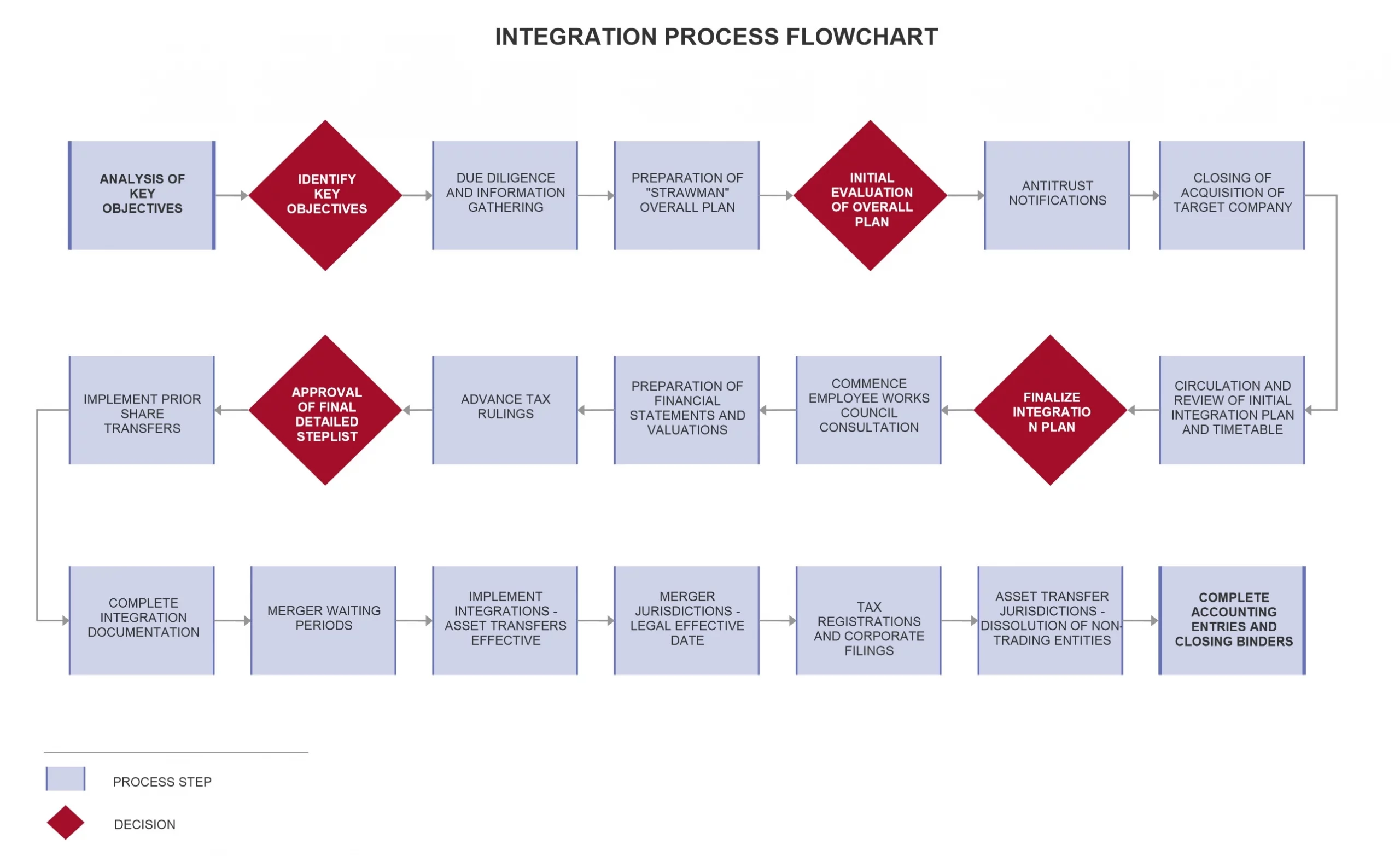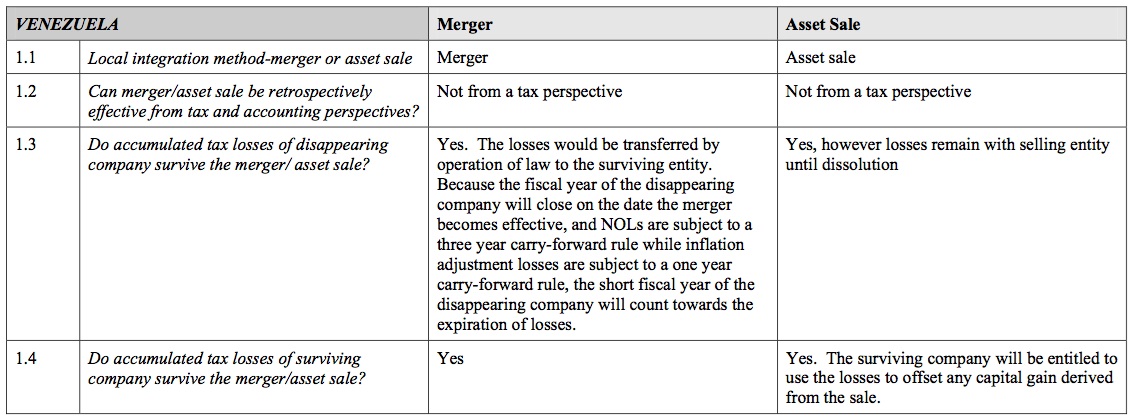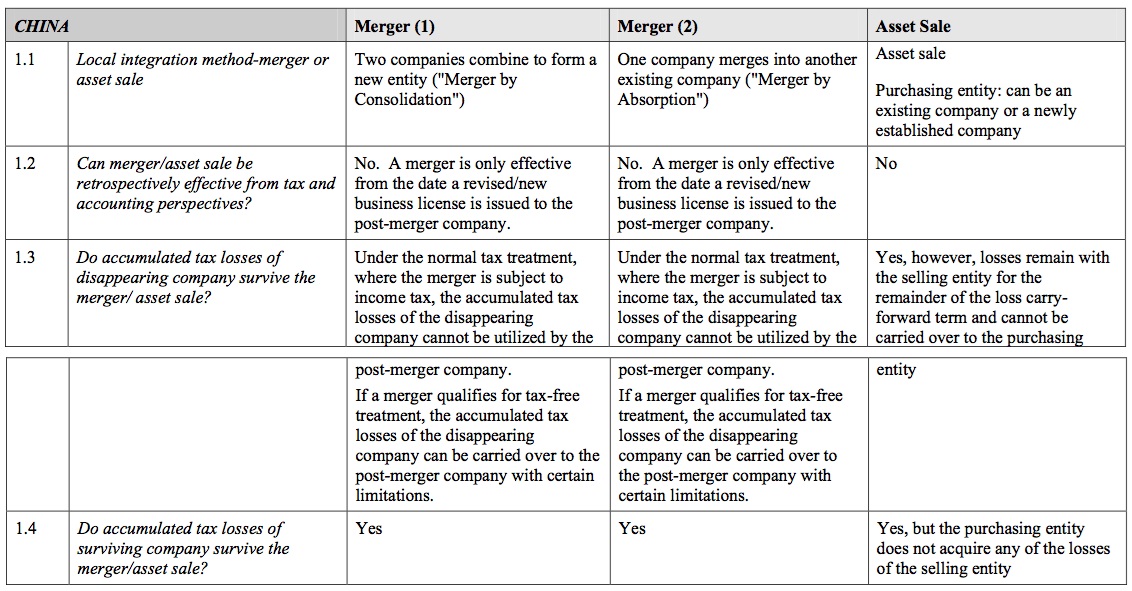
Publications Post Acquisition Integration Handbook
- Publications
Post Acquisition Integration Handbook
By: Baker & McKenzie
Post Merger Integration Handbook
SECTION 1: Optimizing Value in Multinational Corporate Acquisitions
Companies active in the mergers and acquisitions market are realizing that the real challenge when acquiring a new business starts only when the deal closes and are focusing more attention on how they best derive value from their acquisitions. Where the existing and target businesses operate in the same or complementary fields, it is almost always the case that the acquiror desires to integrate the two businesses in order to save costs, develop synergies and generate value for its shareholders.
Bringing together businesses with different trading relationships, histories and cultures inevitably poses substantial challenges. Where the businesses of the acquiror and target are multinational, the scale and number of those challenges increase significantly.
The aim of this Handbook is to provide a reference tool for companies which may either be contemplating, or in the process of executing, a multinational business acquisition, and which therefore need to focus, at an early stage, on how best to overcome these challenges and deliver maximum value to shareholders from the acquisition. It provides a guide to the process of identifying the legal issues to be addressed, planning the business integration and its legal implementation.
The following chapters focus on the common situation where the parent company of one multinational group acquires all of the shares of the parent or intermediate holding company of another multinational group. This creates a corporate structure containing two completely separate groups of international subsidiaries, with the likelihood that in many territories the newly enlarged group will have duplicate operating and holding companies. These individual companies will have their own separate management structures and customer relationships and their own existing trading and intra-group arrangements. Integrating these structures, relationships and arrangements in the post-acquisition environment can prove to be one of the most significant challenges that management will have to face.
The issues raised in this Handbook may apply to acquiring groups headquartered in any jurisdiction, though a number of examples highlight issues particularly relevant to acquirors headquartered in the United States.
The key to developing a post-acquisition integration plan, implementing it successfully, and overcoming the challenges referred to above, is the early identification of the key strategic and business objectives of the acquisition and the subsequent integration. Provided that these objectives are realistic and supported by management, and provided that proper attention is given to the planning and implementation of the integration, the likelihood of delivering the desired benefits from the acquisition and integration of a target business will be increased.
SECTION 2: Executing a Post-Acquisition Integration Strategy
This section provides an overview of the type of integration process that typically ensures success in global post-acquisition integration projects, and then provides a brief summary of the more common substantive issues companies are likely to encounter in planning and implementing such projects.
Several of the key issues discussed in this overview are expanded upon in subsequent sections of the Handbook.
1. Overseeing the Execution of Post-Acquisition Integration
A large post-acquisition integration project raises issues of both process management and technical expertise. Moreover, once an integration plan has been developed, practical implementation issues will often prove critical in determining how quickly the plan can be implemented and how soon the benefits of the integration can be realized. In particular, human resource concerns, corporate and tax law issues, regulatory approval and filing requirements should be built into the planning process itself, and not be left to the implementation phase, with particular focus on avoiding road-blocks that might otherwise delay or frustrate the realization of integration goals in many jurisdictions.
Outside advisors are typically used in this type of project because of their specialized experience and expertise, and because a company’s permanent staff often are best used in other ways that relate more directly to the daily business operations of the company. However, internal staff are the best (indeed, for the most part, the only) source of the information that is critical to creating an effective implementation plan. In particular, they understand the historical perspective of the tax, corporate and business planning background of many of the existing structures. Ultimately, they must be sufficiently familiar with the new plan so that they can assist in both its implementation and be in a position to manage and sustain the structure that results at the end of the process.
Outside advisors and management must therefore work together to strike a balance that makes the best use of internal resources but adds the particular experience and expertise of the outside advisors and relieves the strain on already scarce management time. Frequently, however, this balance is not struck and advisors and management adopt one of two extreme approaches: the “black box” approach, whereby outside advisors gather data, disappear for some period of time and then present proposals, which can fail to take advantage of existing background knowledge possessed by management and, by excluding them from development of the plan, does not put management in a position to manage the end product; or the “shotgun” approach, whereby outside advisors gather minimal data, and then subject management to a barrage of ideas that “might” work, which effectively puts too much of the onus on management to place the ideas into the context of their group’s actual circumstances (of which the advisors are unaware) and assess resulting risks.
Although there is no “one size fits all” integration process, a happy medium can often be achieved if it is first understood that identification of the group’s strategic objectives is predominantly a senior management task, and that designated key management personnel should continue to be involved in both a fairly comprehensive information gathering phase and in strategic and tactical decision making during the ensuing analysis phase. In addition, the appropriate management personnel should be involved in the construction of any financial models necessary to understand the tax impact of the ideas generated by the project team
Ideally, there should be an interim evaluation of a preliminary plan to provide important feedback from the company on practical feasibility (including analysis of the impact on IT systems), risk appetite and business impact, followed by at least two opportunities to review the overall plan.
The process can be broken down into seven phases:
- identification of strategic and key objectives;
- information gathering;
- preliminary analysis and overall plan development;
- initial evaluation of overall plan;
- final detailed steplist development;
- evaluation and approval of final detailed steplist; and
- implementation of detailed final
1.1 Identifying Strategic and Fundamental Goals
The management team will need to decide the relative significance of business goals, timing and implementation, and prioritize accordingly. It may be that certain geographic regions or lines of business warrant first attention and the integration would then proceed on the basis of a planned series of iterations. Alternatively it may be that what is required is a comprehensive solution that pursues all regions or business units simultaneously with, to the extent possible, a single effective date for the entire integration. Naturally, the more comprehensive the initial plan, the more time it will take to move through the phases of the process.
The key issues to focus on are:
- what are the company’s business goals and priorities in the integration?
- what are the company’s plans for employee transfers and workforce reductions, if any?
- what are the constraints on moving assets, entities and people?
- what are the timing and sequencing priorities?
1.2 Data Gathering Phase
This process must provide for planned, structured input from all relevant constituencies, for example human resources, tax, general counsel’s office, strategic business development, finance and information systems. Whilst this adds some time to the process of developing a plan, it will pre-empt problems that could otherwise arise in the implementation phase in case a previously uncirculated plan should prove unacceptable to one or more of these constituencies. It is often the case, for example, that information systems compatibility issues can hold up the integration of newly-acquired entities into an acquiring group’s existing or newly designed commercial structure and the time required to resolve these issues will need to be built into the overall integration plan. The object of this phase is to develop a clear understanding of the goals of the integration project and to gather sufficient information and documentation about the entities and assets that are to be integrated in order to allow the planning and execution phases to proceed.
The initial information gathering phase of an integration project typically involves seeking answers to the following questions:
- in which jurisdictions do the companies within the scope of the proposed integration operate?
- where are the taxes being paid?
- what are the tax attributes of the enlarged group?
- where are the tangible assets?
- where are the intangible assets?
- are there any non-core businesses or operations?
- what are the current transfer pricing policies?
1.3 Initial Assessment and Overall Integration Blueprint
It is then necessary to conduct a preliminary analysis of the information collected in order to develop an overall integration plan. The focus in this phase is on planning an integration that achieves the integration goals in the most efficient manner from a tax, cost and corporate perspective. The tax goal will often be to ensure that most or all of the steps in the integration are free from income and capital gains taxes in any jurisdiction, while minimizing any capital duty, local transfer and documentary taxes and avoiding any negative consequences on the business due to VAT and customs changes. The following tax goals also often come to bear:
- the integration of the corporate structure may be combined with a change in the inter- company commercial relationships of all or some of the combined group companies so as to minimize taxes globally;
- the acquired companies may have favorable tax attributes, such as net operating losses and unused foreign tax credits, and the integration should be conducted in a manner designed to preserve those attributes, where possible;
- the integration may be structured in a way to take advantage of existing tax attributes, such as using net operating losses in the acquired entities to offset taxable income in the existing structure;
- in the United States, there may be opportunities for domestic state and local tax minimization planning;
- there may be opportunities for minimizing other governmental costs (for example customs and VAT planning).
In the preliminary analysis phase, management and the outside advisors will consult with one another and develop a high-level integration plan. To the extent possible at this stage, the plan will specify which entities will be kept and which will be eliminated. It will also, where possible, specify the method of integration (for example “Target France Sarl will merge into Parent France Sarl,” or “Target UK Ltd. will sell all assets and all liabilities to Parent UK Ltd. and will then liquidate”). The overview document will be revised and expanded into a detailed steplist as the planning continues.
1.4 Preliminary Review of Integration Plan
Once the high-level integration plan has been developed, it is important to have the key constituencies (for example operations, tax, finance, legal, human resources, information systems) evaluate it and provide input on any issues the plan presents and any refinements that they wish to propose.
Depending on the scale of the integration project, this evaluation may take place in a single meeting or over several days or weeks.
It is important to note that developing the overall integration plan is often an iterative process because, as more information is learned about the entities to be consolidated, new issues and opportunities may present themselves and the integration goals may change. As the goals change, more fact gathering may be required. With each iteration, however, the integration goals become more refined and more detailed.
1.5 Comprehensive Steplist Plan Formulation
As the overall integration plan becomes more refined and is finalized, it should be expanded into a fully detailed list of each step necessary to execute the assigned tasks. The end product will be a complete plan and timetable for executing the assigned tasks with the names of those responsible for each step and, in the case of documents, the identity of the signatories. Interdependencies and steps that must follow a certain order or await permissions, filings and the like should be noted on the steplist.
1.6 Detailed Approval Process
As with the high-level integration plan, it is important to have the key constituencies evaluate the detailed steplist and provide input. Sometimes issues that were not apparent in the high-level plan become apparent when a person sees the detailed steps that will be taken and considers his or her role in implementing those steps.
1.7 Carrying out the Roadmap
There are various ways to manage the implementation of the detailed integration steplist. The specific approach will depend on the size of the project, the nature and geographical scope of the tasks involved and even the management styles and personalities of the individuals involved. The key to success in this phase is maintaining open and clear channels of communication about how the implementation is progressing, what issues are surfacing and making sure that there is a central decision maker available who can make executive decisions as and when required.
Throughout the execution phase the detailed integration steplist serves to track the status of tasks. Regular scheduled status calls with the key project individuals at the companies and the outside advisors keep the integration process on track, focusing minds on any open issues and allowing advisors and management to help identify what, if anything, is holding up completion of a particular step and take action accordingly.
2. Legal & Tax Considerations
Certain legal and tax considerations frequently arise in post-acquisition integrations. The discussion below is not intended to be exhaustive, particularly as additional issues, such as industry-specific considerations, can also apply.
2.1 Due Diligence Integration
As part of the information gathering phase of the plan, the company should undertake a legal and tax due diligence investigation of each of the entities involved (for example subsidiaries, branches, representative offices) in order to identify legal and tax issues that need to be dealt with before or during the consolidation. This investigation should not just delve into the acquired entities, but also into the existing entities with which they will be consolidated. Experienced legal counsel should be able to provide a due diligence checklist, which would include such items as determining what assets the entities own, identifying contracts that may need to be assigned, identifying ongoing litigation, tax attributes, data protection issues, employment matters etc. (see Section 4 for a sample checklist).
Opportunities for starting the integration due diligence process before the acquisition is complete (i.e., during the acquisition due diligence itself) are often overlooked. After an acquisition completes, it typically becomes increasingly difficult to gather the information and documentation needed to conduct an effective and efficient integration. As time passes, people who worked for the acquired companies often depart, taking institutional knowledge with them, and those who remain are often not as highly motivated for the task of gathering required documents and facts as they were during the pre-acquisition phase. Furthermore, leveraging the often considerable resources marshalled for the acquisition due diligence to also address consolidation due diligence issues can be much more cost effective than starting a new due diligence process after the deal closes. However, when planning commences before completion of the acquisition of a competitor, attention must be paid to antitrust restrictions on the sharing of information. See Section 8 for more detail.
2.2 Choosing Between Local Statutory Mergers and Asset Transfers
In many jurisdictions, the local corporate laws provide for statutory mergers. In these jurisdictions, the alternative approaches of merger vs. sale-and-liquidation should be compared to see which one best achieves the integration goals. Statutory mergers are often advantageous because it is then generally the case that the assets and contracts of the non-surviving entity transfer automatically, whereas individual transfers of assets and contracts can be cumbersome, for example there may be a requirement to register any change of ownership of assets and, in certain cases, a third party or a government must approve the transfer of an asset or contract. In these situations, a merger may effectively be the only means to transfer certain assets. Local merger regimes often also have tax benefits. Indeed, even if the only benefit of the local statutory merger regime is that the transaction is tax-free for local tax purposes, this benefit can be substantial.
Some jurisdictions have recently introduced merger legislation; one such jurisdiction is Singapore, where a change to the Singapore Companies Act in 2006 means that two or more Singapore incorporated companies can now be amalgamated.
A number of jurisdictions simply do not have a merger statute that allows local companies to merge together. In these jurisdictions, the only choice available for combining two companies may be some variation on the theme of selling (or otherwise transferring) the assets of one company to the other and then liquidating or dissolving the seller entity. These jurisdictions tend to be common law countries such as Hong Kong and the UK. These jurisdictions often allow for a business transfer within a local group to occur without taxable gain, and achieve the objective of consolidating the two local businesses in a manner that is functionally equivalent to a merger from a local perspective.
Moreover, a business transfer can usually be converted into a tax-free reorganization from a US tax perspective. If a business transfer or merger is not possible or desirable, two further ways in which the businesses can be “integrated” are by utilizing local tax consolidation/group rules or by having one company operate the other’s business under a management contract, or business lease, during the interim period. These options do not result in full integration with a single entity in the jurisdiction, and further details are set out in paragraph 3.3 of Section 3 “Tax Considerations”.
2.3 Asset Relocation Strategies
Where the local integration method chosen requires the individual transfer of assets, steps must be taken to effect the transfer, and sometimes registration, of the legal ownership of the assets. The steps required will depend on the type of assets involved. In many cases, a simple asset sale and purchase agreement will suffice to transfer title.
In the case of some assets, however, such as real property, automobiles or certain types of intellectual property, the change in legal title may have to be recorded with governmental or regulatory authorities to be effective. Moreover, in some cases approval of a governmental agency must be obtained before transfer of governmental licenses, permits, approvals and rulings.
In certain jurisdictions, even a general asset transfer agreement may have to be filed with local authorities and may have to be drafted in a local language. Bulk sales laws may apply to significant asset transactions with the effect that liabilities and creditors’ rights transfer by operation of law with the assets. Local insolvency and creditor protection laws need to be taken into consideration (for example those prohibiting transactions at an undervalue) especially when there is a plan to wind up the transferor entity. In addition, the asset transfer may give rise to issues of corporate benefit and directors’ statutory or fiduciary duties. Also, separate formalities are almost always required to effect the transfer of shares of subsidiaries.
A key issue in asset transfer jurisdictions is ascertaining the purchase price to be paid for the assets to be transferred. Often the interests from tax, corporate law, accounting and treasury perspectives will compete. For example, a sale by a subsidiary to its parent at less than market value may be an unlawful return of capital to the shareholder. However, a sale at market value may result in significant goodwill being recognized by the parent company for local statutory accounting purposes. Depending on the group’s or local entity’s goodwill amortisation policy, a “dividend blocker” could be created at the level of the parent, as the amortisation created by the acquisition is expensed through the parent’s profit and loss account.
2.4 Contract Novation and Assignment Methods
In a local asset sale or merger, existing contracts, such as office leases, equipment leases, service agreements, distributor agreements, customer agreements, supplier agreements, utility and telephone accounts, and a host of other operational agreements, will have to be transferred to the surviving entity.
In a merger, these assignments almost always occur by operation of law, but in other cases steps have to be taken to effect the novation or assignment (see Section 10 for a summary by jurisdiction). These steps may range from giving a simple notice of assignment to all third parties to obtaining written consent from the other party to permit the novation (by way of a tripartite contract) of all of the rights and obligations to the surviving entity.
It may be prudent, though not practically desirable, to review contracts, particularly key arrangements, in order to determine whether they are freely transferable or whether permission is required. Even in a merger between affiliates it may be advisable to review the contracts of both affiliates to determine whether their contracts contain any provisions that may be triggered by the merger, such as provisions giving the other party the right to terminate upon a merger or change in control.
If the surviving and disappearing entity use different suppliers for the same product or raw material and it is intended to rationalize the supply chain, it will be necessary to identify the likely cost of cancelling those supply contracts which are not to be continued or whether the third party has the bargaining power to impose new contractual terms which comprise of the best of both pre-existing arrangements.
2.5 Tax Attribute Preservation Strategies
Favorable local tax attributes, such as net operating losses or current year or carried forward tax losses (Net Operating Losses, “NOLs”), can provide a permanent benefit to the company if preserved. In many jurisdictions, how a consolidation is executed will have an impact on whether the NOLs survive.
For instance, in some jurisdictions, the NOLs of the acquiring or surviving subsidiary are preserved, but the NOLs of the target or absorbed company are restricted (for example Italy) or lost (for example many Latin American countries). Thus, it may be beneficial to make the company with the NOLs the surviving company in the consolidation. Similarly, in many jurisdictions, transferring the shares of a subsidiary may impact the survival of the NOLs (for example Germany). In such a case, it may be beneficial to merge the profitable company into the loss-making company (rather than vice versa).
In other cases, a cash or asset infusion can impact the NOLs. In fact, in many countries, a mere change in the business may be sufficient to restrict or eliminate the NOLs (for example the UK and Australia). Finally, in many countries it may be advisable, or even necessary, to obtain an advance ruling with respect to the NOLs to confirm that the NOLs (or at least some portion of them) will survive the local consolidation (for example France).
In a merger, these assignments almost always occur by operation of law, but in other cases steps have to be taken to effect the novation or assignment (see Section 10 for a summary by jurisdiction). These steps may range from giving a simple notice of assignment to all third parties to obtaining written consent from the other party to permit the novation (by way of a tripartite contract) of all of the rights and obligations to the surviving entity.
It may be prudent, though not practically desirable, to review contracts, particularly key arrangements, in order to determine whether they are freely transferable or whether permission is required. Even in a merger between affiliates it may be advisable to review the contracts of both affiliates to determine whether their contracts contain any provisions that may be triggered by the merger, such as provisions giving the other party the right to terminate upon a merger or change in control.
If the surviving and disappearing entity use different suppliers for the same product or raw material and it is intended to rationalize the supply chain, it will be necessary to identify the likely cost of cancelling those supply contracts which are not to be continued or whether the third party has the bargaining power to impose new contractual terms which comprise of the best of both pre-existing arrangements.
2.6 Tax Efficiency Measures for Corporations and Shareholders
In the transactions undertaken to integrate the acquired entities, it is important to avoid, or at least minimize, foreign income taxes. Foreign income taxes can be imposed on the consolidating corporations with respect to their assets. Similarly, income taxes can be imposed on the shareholders in connection with stock transfers.
If structured properly, foreign corporate level income taxes can often be avoided either by consolidating through a merger, if available, or through the local form of consolidation or group relief. Stock transfers, on the other hand, may be exempt from income tax due to either the appropriate double tax treaty, an EU Directive, or local law.
2.7 Navigating Transfer, Stamp, and Real Estate Taxes
Many countries have stock transfer or stamp taxes (for example Taiwan at 0.3%). Although such taxes may not be great, they are a real out-of-pocket cost to the company. For the same reason, foreign capital taxes and documentary taxes should be avoided whenever possible. Thus, where possible, steps should be taken to avoid or minimize these taxes, and exemptions will often be available for intra-group transactions. Some countries, such as Austria, tax the transfer of real estate where the entire issued share capital of a company is transferred which can result in tax arising both on share transfer and the subsequent merger.
2.8 Addressing Severance and Restructuring Charges
Most integrations result in some severance or other restructuring costs. In most jurisdictions, provided that appropriate precautions are taken, these costs are deductible for local income tax purposes. There is nevertheless often a number of strategic considerations that should be taken into account when deciding when and how to incur restructuring costs such as those arising from the elimination of employees. Domestic and foreign tax consequences are among these strategic considerations.
2.9 Strategies for Foreign Tax Planning
A variety of foreign tax planning opportunities may arise in connection with any international integration. For instance, in many jurisdictions there will be an opportunity to obtain a tax basis increase or “step up” in the assets of the local company transferring its assets, sometimes without any local tax cost. It may be possible to leverage the surviving company with additional debt in connection with the integration. The interest deductions can then be used to erode or reduce the local tax base. In addition, if the parent is the lender, the repayments of principal can generally be used to repatriate earnings without both income tax and withholding tax.
2.10 Pre-Integration Share Ownership Structure
It is generally preferable to create a share ownership structure where the shares of the foreign subsidiaries are in a direct parent/subsidiary or brother/sister relationship with the entity with which they will be integrated, since many jurisdictions, such as the state of Delaware or Germany, have short-form merger procedures which are easier and cheaper to implement if such a structure is in place.
A further benefit to a parent/subsidiary or brother/sister relationship being established for the integration is that, following the merger, the surviving subsidiary will have a single shareholder, making future distributions, redemptions and restructurings easier to implement.
If the subsidiaries are not in a parent/subsidiary or brother/sister relationship prior to the merger, usually each shareholder must receive its pro-rata portion of the shares in the consolidated entity. This requirement creates practical and timing issues as comparable financial information will be required for the merging entities.
A number of methods can be used to achieve a parent/subsidiary or brother/sister relationship prior to an integration, including:
- the acquiring company contributing its foreign subsidiaries downstream to the target company;
- the target company distributing its subsidiaries upstream to the acquiring company;
- the shares of the subsidiaries being sold within the
The most common method is a transfer by the acquiring company of its subsidiaries downstream to a lower tier target company and various issues, including tax, must be considered. One corporate law consideration is whether the company which is receiving a contribution which consists of shares in another company has to issue new shares for local company law purposes.
Another consideration which may affect how the group is restructured will depend on the ultimate destination of the company being transferred. If this destination is several tiers down, transferring through each of the shareholding tiers may create considerable work. A direct contribution to the ultimate destination will invariably involve the issue of new shares by the company receiving the contribution.
In some situations this is undesirable since it can complicate the group structure; in other situations it can be an advantage. For example, a direct shareholding by a parent company in a lower tier subsidiary may give rise to a more tax efficient dividend flow, or may enable the parent company to access profits of a subsidiary that previously have been “blocked” by an intermediate subsidiary company which is unable to declare and pay dividends because of an earnings deficit on its balance sheet.
2.11 Legal Factors in Employment
Where the integration involves an asset transfer, it will normally be necessary to take some additional steps to transfer employees. Commonly this will be by termination and rehire, but in some jurisdictions, mainly in the EU, the employees may transfer automatically by law. In a merger or asset transfer (and very occasionally on a share transfer) there may also be obligations to inform and potentially consult with employee representatives such as works councils or trade unions.
In some cases, those bodies have a right not only to be informed and consulted but also to deliver an opinion on the plans for the local integration before they are finalized and implemented, and it may be a significant violation of local law to make changes in the management of the local company or undertake an integration transaction without formally consulting with them. Due diligence should therefore obtain details of all employee representatives, unions etc. and input as to the employee relationship environment in each country, as time for information and consultation should be built into the step plan.
One of the common objectives of a business acquisition followed by an integration is that duplicate functions can be eliminated, thereby streamlining the operation of the combined businesses. In addition, there is often a desire to harmonize the compensation packages, benefits, and working conditions of the workforce.
In many jurisdictions, workers have significant protection from changes to working conditions, benefits and dismissal. In those countries, if an employer changes an employee’s working conditions or terminates an employee in connection with an acquisition and the subsequent local integration, the employee can be entitled to compensation or reinstatement. It may even be the case that changes to employment terms are simply ineffective, allowing the employees to demand the old terms at any time.
2.12 Changes in Executive Leadership
In the aftermath of an acquisition, some of the executives of the target company, and possibly also of the acquiring company, may leave. If these individuals are serving as officers or directors of local subsidiaries, they must be replaced so that it is possible to continue to take corporate actions at the subsidiary level to effect the integration. A similar issue arises with respect to individual employees who are serving as nominee shareholders to satisfy minimum shareholder or resident shareholder requirements in a particular jurisdiction. If these individuals have left employment with the company, they may have to be tracked down to sign share transfer or other documents.
2.13 Minimizing Delays and Notices
In many jurisdictions, government or tax clearances are required prior to the merger or liquidation of the local entities. Even in jurisdictions where government clearances are not required, public notices are often necessary and statutory waiting periods often apply. These formalities can delay the integration. Accordingly, it is important to identify the jurisdictions where immediate integration is desired so that the required applications and notices can be filed as soon as possible.
In cases where there are statutory or practical delays in implementing the integration, alternative strategies may be available for dealing with the delays to minimize operational inconvenience or tax exposure, including:
- having one company operate the other’s business under a management contract during the interim period;
- selling the business to the surviving company, with a subsequent merger to eliminate the empty company; and
- making the merger retroactive for tax and/or accounting purposes under local law.
In any case where the delay is significant or there is a strategic objective to have the local businesses integrate on a particular date, for example, these alternatives should be explored.
2.14 Required Corporate Compliance Processes
The due diligence exercise may highlight deficiencies with the corporate compliance status of the group and so it may be necessary to take corrective action before integration can be started or concluded. For example, if acquired subsidiaries are technically insolvent or have not complied with their annual corporate filing or other maintenance requirements, it will typically be necessary to correct these deficiencies before any significant integration steps, such as mergers or liquidations, can be undertaken.
Integrations are frequently delayed because the entities that are to be eliminated have not been properly maintained and there is a need to create statutory accounts, hold remedial annual meetings and make the necessary delinquent tax and corporate filings. These problems can be compounded if local company directors have left, and it can be difficult to persuade management to serve on the boards of local subsidiaries that are not in compliance with their obligations. Further details are set out in Section 8 Compliance and Risk Management.
2.15 Management of Branches & Subsidiaries
It is important not to overlook any branches, representative offices and other business registrations of entities that are disappearing in the integration. In many cases, it would be a mistake simply to merge one subsidiary into another on the assumption that any branches of the disappearing entity will automatically become branches of the merged entity. Many government authorities view a branch as being a branch of a specific entity and, if that entity disappears in a merger, the survivor will have to register a new branch to account for its assets and activities in the jurisdiction.
In some cases, merging an entity before de-registering its branch or representative office can cause great difficulties with the authorities in the jurisdiction where the branch was registered, as these authorities will treat the branch as continuing to exist, and continuing to have ongoing filing and other obligations, until it is formally de-registered. Furthermore, the process of de-registration may be greatly hindered or may be technically impossible if the entity no longer exists.
Similar complications can ensue if it is assumed that shares of subsidiaries will automatically transfer when the original parent company is merged into another group company. Effecting the local legal transfer of the shares of the subsidiaries can be problematic if not identified and planned in advance.
2.16 Authority for Corporate Approvals
Integrations typically involve extraordinary or non-routine transactions (for example the sale of all of a subsidiary’s assets to an affiliate). The individual directors or officers of the entities involved may not have the necessary corporate authority to effect those transactions. Therefore, it is often necessary to consult applicable local law and the articles of association or other constitutional documents of the entities involved to determine if there are any corporate restrictions on the proposed transactions, and then to take appropriate steps to authorize the transactions, such as adopting board resolutions, shareholder resolutions or amending the constitutional documents. Thorough documentation recording corporate decisions assists in memorializing the background to decisions and can be helpful where the transactions are reviewed as part of accounting or tax audits.
SECTION 3: TAX MATTERS
1. Introduction
1.1 Tax Planning Goals
When planning a post-acquisition integration project it is imperative that management and their advisors consider the tax issues at an early stage to determine the type and magnitude of tax risks and identify tax planning opportunities. Management and the advisors should consider at an early stage how tax planning goals will be balanced with business factors when developing a plan for the structure of the integration.
Many factors influence the tax structuring options available when planning an integration, for example: the existing tax attributes of the companies; tax planning already undertaken; the future strategic plans for the new group; anticipated changes in the local and global tax environment; the tax audit profile of the companies; planned flotations, spin-offs and further acquisitions.
In some situations, management may wish to actively take advantage of tax planning opportunities the integration may create in order to enhance the after tax cash flow. It may, for example, be the stated intention of management to reorganize the shareholding structure of the group to allow for tax efficient repatriation of earnings in foreign subsidiaries to the parent company, to create a global group cash management function, or to minimize the group’s global effective tax rate. In terms of the latter goal, post-acquisition tax planning will, first and foremost, seek to convert and allocate the purchase consideration to tax amortisable asset capitalisation. The second priority will be to push down any leverage incurred in financing the purchase consideration to local entities and thereby reduce their pre- tax earnings.
For planning purposes it is normally straightforward to assess the tax costs of achieving the business objectives of the integration. Tax costs (or tax planning savings) are treated like any other business cost (or benefit) and form part of the cost/benefit analysis that management undertakes when formulating the integration plans.
One difficulty usually experienced by management during the early stage of an integration project is putting a number on the expected tax costs or expected tax planning benefits. It may not be until the fine details of the integration plans are settled that tax issues and costs can be accurately identified. An unexpected tax cost to an integration can be a bitter pill to swallow and emphasizes the need for careful and detailed planning, not only at a local level, but also with a view to global issues.
1.2 Valuable Tax Attributes
In many cases either one or both local subsidiaries may have valuable tax attributes, such as accumulated tax losses (NOLs). Preserving these tax attributes is likely to be an important goal of any integration project. However, it will always be important to weigh the value of tax attributes (taking into account projected profitability of the integrated business and loss expiry rules) against the business costs of preserving the losses. In some jurisdictions, for example, a business lease between the two operating subsidiaries may have advantages over a merger from an NOL preservation perspective, but the lease can be a more difficult structure from an ongoing accounting and business perspective. Which structure is chosen will also depend on the relative value of preserving tax attributes as against the cost of implementing a more cumbersome integration structure.
Where preservation of tax attributes is an important goal, invariably local tax laws contain anti- avoidance legislation which can limit the transfer of the existing NOLs from one group company to another or their use within a group of companies. In the context of a post-acquisition integration project, the operation of these rules must be examined in three circumstances.
First, the original acquisition of the target group by the acquiring group may mean that the existing NOLs have already been lost, are restricted in some way, or cannot be used against profits of the acquiring or a surviving company in the same jurisdiction. In the UK, for example, where a change in the ultimate shareholder of a UK company coincides within three years with a major change in the business of the company, NOLs can be cancelled.
Second, in some jurisdictions share-prepositioning steps can have an impact on tax attributes. In Germany, for example, the transfer of a direct or indirect interest in a German company can (absent a specific relief or exemption) result in the carry forward of NOLs being restricted, or even prohibited. This means that share transfers a long way up the ownership chain that do not involve any German companies directly can impact on the preservation of tax attributes in the German companies. It is therefore crucial, in planning a reorganization, to consider the impact of each step on the integration plan in every jurisdiction. Austria is a good example of a country which preserves losses in most acquisition and integration situations.
Third, in many jurisdictions the manner in which the asset transfer is executed will have an impact on whether the NOLs survive. For instance, in many jurisdictions, the NOLs of the acquiring subsidiary are preserved, but the NOLs of the selling company are restricted. Thus, it may be beneficial to make the company with the NOLs the buying company in the integration. In fact, in many countries, a mere change in the business may be sufficient to restrict or eliminate the NOLs (for example the UK and Australia).
One final point to note in this area is that it is often possible to obtain a binding advance ruling from the relevant tax authority confirming that NOLs will be unaffected by the integration steps (or, where relevant, carry over into the integrated entity. Indeed, in some jurisdictions and circumstances, obtaining a pre-transaction ruling is a prerequisite for NOLs to survive.
The treatment of NOLs in various jurisdictions is summarized at the end of this section.
2. Creation of Branches & Subsidiaries
As explained in more detail in paragraph 2.10 of Section 2, there are a number of advantages to achieving a parent/subsidiary or brother/sister subsidiary relationship prior to an integration. The methods to achieve this relationship include:
- the acquiring company contributing its foreign subsidiaries downstream to the target company;
- the target company distributing its subsidiaries upstream to the acquiring company; or
- the shares of the subsidiaries being sold within the organisation
2.1 Downstream Contributions
The immediate tax consequences of downstream contributions must be considered at three levels. The first level is the tax treatment in the home jurisdiction of the company making the contribution. In many jurisdictions, which include traditional holding company jurisdictions such as Luxembourg and the Netherlands, participation exemptions should allow such contributions to be made tax-free. In other jurisdictions the contribution may have to be structured as a tax-free reorganization either because the jurisdiction does not have a participation exemption or the participation exemption does not apply, where, for example, a qualifying holding period has not been satisfied – which can often be the case in post-acquisition integration projects. Such a tax-free reorganization would usually involve the issue of shares by the company which is receiving the contribution
The next level to consider is the tax treatment for the company receiving the contribution; i.e., is the receipt of the contribution a taxable event? For example, a contribution to a Japanese company without the issue of shares gives rise to a taxable receipt for the Japanese company equal to the fair market value of the shares contributed. In other jurisdictions, for example Switzerland, the contribution may be subject to capital duty.
The third level to be considered from a tax perspective is the tax treatment in the jurisdiction of incorporation of the company being contributed. Is the transfer of legal ownership in the contributed company subject to local transfer taxes, notarial fees and/or registration fees? Does that jurisdiction seek to levy tax on a non-resident shareholder disposing of shares in a company incorporated in that jurisdiction? The taxing rights of the local jurisdiction may be limited under double tax treaties entered into with the jurisdiction in which the company making the contribution is resident, but this is not always the case. Mexico, for example, taxes non-resident shareholders disposing of shares in Mexican companies, and the Mexico-Germany tax treaty allows the Mexican tax authorities to tax gains arising on a disposal of Mexican shares by a German company. Subject to limited exemptions, China, similarly, taxes non-resident shareholders on the disposal of shares in Chinese companies.
2.2 Upstream Distributions
It is usually easier from a corporate law perspective to contribute shares in companies downstream. However, for a variety of other reasons, it may be preferable to distribute shares in companies upstream. From a corporate law perspective, an upstream distribution can be achieved either by declaring a dividend out of distributable reserves, or by way of a capital reduction, the latter being likely to be a more cumbersome, time consuming and costly procedure. Again, tax effects may be seen at three levels. Firstly, is the distribution taxable in the jurisdiction of the company receiving the distribution? Secondly, at the level of the company making the distribution there are two issues to consider, is the distribution subject to withholding tax in the jurisdiction of the company making the distribution and, is the distribution a taxable disposal of the shares? This second issue can be a difficult one as many countries, such as the United States, have complex requirements which must be satisfied for an upstream distribution to be tax free. At the third level the tax consequences in the jurisdiction of incorporation of the company being distributed must be considered (see the issues discussed in paragraph 2.1 above).
2.3 Sale of Stock within the Corporation
The third option is to sell the company directly to another company, which can immediately achieve the relevant parent/subsidiary or brother/sister relationship. This method is sometimes the simplest, especially where a complicated group structure means distributions and/or contributions are impractical. The tax issues discussed above are again relevant.
The sale method can also have other beneficial effects, which can include cash repatriation and the opportunity to leverage local companies with debt.
A company in a particular jurisdiction may be cash rich. This situation may have arisen because current cash generating operations are being used to reduce an earnings deficit on its balance sheet; the parent company has decided not to repatriate cash using dividends because it would become trapped in an intermediate subsidiary that has an earnings deficit (a so-called “dividend blocker”); or it is not tax efficient to distribute profits, either because of the effect of non-creditable withholding taxes or high tax charges in the home jurisdiction of the parent or any intermediate company. The sale of shares in a company or of the underlying business and assets of a company can be used to extract surplus cash out of these types of subsidiaries. In the case of an asset sale, the cash may be further extracted from the company selling the assets either by way of a liquidation, or by utilizing any realized profits on the sale of its assets to declare a dividend.
A sale of shares and/or assets to another company within the group may achieve other benefits. For example, where the original acquisition has been substantially funded by debt, the borrowing company may not have sufficient domestic tax capacity to absorb deductions for the entire financing costs. A primary objective in this situation is to enable maximum tax relief to be obtained for the funding costs in those jurisdictions which have companies with significant tax capacity and this can be achieved by the borrowing company selling shares in subsidiaries (and/or assets) to relevant local subsidiaries with tax capacity.
It is important to examine whether local law will permit a deduction in respect of interest paid in connection with a debt incurred in such a manner. Some countries disallow the deduction in certain circumstances. For example, Singapore does not permit deductions for debts incurred to acquire assets that produce income which is not taxable in Singapore. This includes shares in Singaporean and foreign companies. However, in Singapore it is possible to obtain a deduction for debt incurred to purchase a Singaporean business. In many jurisdictions deductions are not permitted for debt which is incurred for the sole purpose of creating tax deductions. The integration project itself can provide a commercial business purpose for this type of planning.
Other techniques which may be used to create tax deductible interest in a local jurisdiction might include declaring a dividend and leaving the dividend amount outstanding as a debt or undertaking a capital reduction with the payment left outstanding as a debt.
The sale of assets and/or shares across the group also provides an opportunity to rationalize or make more tax efficient the group’s intercompany debt position. For example, a company may assign an intercompany receivable as consideration for the purchase of an asset and/or shares.
3. Tax Issues
3.1 Tax Decrees and Authorizations
Tax authorities in many jurisdictions make provision for binding advance rulings confirming the tax treatment of a transaction in advance of it being implemented. As tax rules around the world become increasingly complex, and the financial reporting requirements associated with the disclosure of uncertain tax positions become more onerous, obtaining certainty as to the tax treatment of a particular transaction as early as possible will often be hugely advantageous. On the other hand, rulings can be costly and time consuming to prepare. Moreover, applying for rulings can lead to audits by local tax authorities, which can impose additional burdens on internal resources that are already stretched by the integration planning and implementation process.
The following factors should be considered in determining whether or not to seek a ruling:
- is an advance ruling necessary to achieve the intended tax result? In France, for example, NOLs will not transfer on a merger unless a prior advance ruling is obtained from the French tax authorities;
- how important is obtaining certainty in advance of the transaction? Groups that are subject to US financial reporting requirements may place a higher premium on certainty than groups that are not;
- is a ruling the only way to obtain the level of certainty required? Where the tax rules relating to a particular transaction are fairly clear, an opinion from third party advisors may provide sufficient comfort on any points of uncertainty;
- how much will the ruling cost? Tax authorities in some jurisdictions (for example Germany) can charge a substantial fee for providing advance tax rulings;
- how long will it take to get the ruling? Tax authorities in some jurisdictions (for example the UK) commit to providing a response to ruling requests within a certain time-frame, whereas others are not obligated to respond at all. This can lead to the ruling process holding up the timing of the transaction as a whole;
- how much disclosure is required? Most tax authorities require that the taxpayer fully disclose all of the details of the transaction before they provide a ruling. Where a new operating or transfer pricing structure is being implemented, the group may feel that early disclosure may result in a less advantageous tax result (for example where the advance agreement will be based on potentially unreliable forecast data); and
- can the ruling be relied upon? Some rulings are more binding than others. In some jurisdictions, a “ruling” is, in reality, merely a written indication of the way in which the tax authorities are likely to view the transaction, which can be departed from on audit.
3.2 Managing Real Estate Tax Transfers
Many jurisdictions impose transfer taxes on the transfer of real estate. Some (for example Germany) also impose transfer taxes on the (direct or indirect) transfer of shares in companies that own real estate in that jurisdiction. As real estate transfer taxes tend not to be deductible for tax purposes nor creditable in the jurisdiction of a parent entity, they generally represent a real out-of-pocket cost to the company.
In many jurisdictions (for example the Netherlands), real estate transfer tax only applies to an indirect transfer of real estate where the company whose shares are transferred is considered “real estate rich”. This can create a tension between commercial considerations, which will sometimes militate towards holding real estate in a separate legal entity to ring-fence liability, and tax considerations, which might suggest holding real estate in an operating entity so that the value of other assets “swamps” the value of the real estate, preventing the company from being considered “real estate rich”.
In practice, exemptions are often available where the real estate (or an interest in the real estate) is transferred within an associated group of companies, which limit the impact of real estate transfer taxes in the context of intra-group reorganizations. For example, the transfer of a company incorporated in New South Wales, Australia is subject to a 0.6% stamp duty, but relief is granted where the transferor and transferee company have been associated for at least 12 months prior to the transfer. However, some jurisdictions (for example Germany) have extremely limited exemptions. In these jurisdictions, it is often necessary to consider bespoke transfer tax mitigation structures to limit the incidence of real estate transfer tax.
3.3 Intellectual Property Migration
Intellectual property represents an important and valuable asset for many groups. Where such assets are owned by entities in high-tax jurisdictions, this can have a significant effect on the group’s overall effective tax rate. Post-acquisition integration often provides a good platform for a reconsideration and rationalisation of a group’s IP holding structure, which in turn can create material tax efficiencies.
Even where IP migration is not an option, it is sometimes possible to structure a merger or business transfer in a way that gives rise to goodwill that can be amortized for tax purposes by the acquiring entity, thus eroding the local tax base post-integration.
3.4 Tax Financial Structure
Post-acquisition integration also often provides an ideal opportunity to rationalize or make more tax efficient the group’s financing structure. For example, a company may assign an intercompany receivable as consideration for the purchase of an asset and/or shares, or may sell assets and/or shares across the group in exchange for debt, as discussed at paragraph 2.3 above. In some cases, it may be possible to make use of “hybrid” instruments in these transactions, the effect of which is that a deduction is available in respect of “interest” paid by the debtor, whereas the return on the instrument is regarded as a tax-exempt return on equity in the hands of the creditor.
In all cases where more tax efficient financing is aimed for, local thin capitalisation limits have to be observed in the planning to avoid “vagabonding” interest i.e. creating interest costs which are not deductible anywhere.
4. Integration Framework for Local Operations
There are two basic methods available to integrate operations in local jurisdictions: either a statutory merger under local law; or the sale of business from one subsidiary to another in the same jurisdiction with a subsequent liquidation of the seller. A summary of these integration methods in thirty three jurisdictions is set out in Section 10.
4.1 Sale, Consolidation, and Liquidation of Business
The simplest approach to achieve the consolidation of operations is often to sell the business of one foreign subsidiary to the other subsidiary in the same jurisdiction. The selling company is subsequently liquidated. In most common law jurisdictions, including the United Kingdom, Australia, South Africa and Singapore, either no simplified statutory merger regime exists or if a regime exists it is, for practical reasons, not commonly used. In these jurisdictions a business sale and liquidation is the only available way to integrate the businesses. The tax goal in carrying out such transactions is to minimize or eliminate any tax charge and if possible to retain any valuable tax attributes of the local seller and the local buyer. To achieve this goal it is usually necessary to have the seller and the buyer either in a group arrangement or consolidated for local tax purposes. In certain jurisdictions this may only be possible if one local company directly owns the other or they are both owned by a common parent company in the same jurisdiction. In the United Kingdom and Australia the tax rules allow for common ownership to be traced through foreign corporations, which can eliminate the need to undertake any share restructuring prior to the consolidation.
When transferring assets from one company to another it is likely that the assets will be treated for tax purposes as being sold for their fair market value unless the asset can be transferred from one group company to another on a tax-neutral basis pursuant to local tax group or consolidation rules.
Management should always consider whether they wish to take advantage of these regimes or whether a better result can be achieved by ensuring that the rules do not apply. The tax impact of the sale of assets out of the country, in particular if IP and/or goodwill/customer relations etc. are included, has to be carefully considered from the perspective of exposure to “transfer of functions” taxation under OECD principles and even tighter local rules, such as those applicable in Germany.
The transfer of trading stock and work in progress from one company to another company in the same jurisdiction will normally give rise to a revenue profit. Local tax rules may allow for such assets to be transferred at their original acquisition cost, although consideration should always be given as to whether existing NOLs within the selling company might be used (always subject to local minimum taxation rules, if any) to set off against any profits arising from a sale at fair market value. This allows the buying company to achieve a step-up in its tax base cost in these assets and is a useful technique if the transfer of NOLs from the local selling company to the local buying company is not possible.
The selling company may have been depreciating its capital assets for tax and accounting purposes. The effects of any intercompany sale upon tax depreciation claims should be considered. In some jurisdictions, opportunities exist for pre-acquisition tax depreciation allowances to be disclaimed and deferred to a post-acquisition period. This can be useful to help mitigate the loss of NOLs, which can occur as a result of the original acquisition or the post-acquisition integration. In some situations companies may not want NOLs or other tax attributes to transfer as part of an asset sale to the identified surviving company, for example a US parent company may have been utilising in the US the NOLs of a foreign branch. If the foreign branch NOLs transfer to a foreign subsidiary of the US parent company as a matter of local law, the US parent may be faced with the recapture of the US tax savings generated as a result of using its foreign branch’s NOLs in the US.
In most jurisdictions the sale of assets from one company to another will be subject to value added tax or a similar tax. Usually such tax charged by the selling company to the buying company is creditable to the buying company, however, this can give rise to a cash flow disadvantage to the group when carrying out such transactions in a large number of jurisdictions. In many jurisdictions, and this is certainly true for EU member countries, transfers of businesses as a going concern are ignored for VAT purposes.
Stamp duties can considerably add to the cost of a local asset sale, especially when valuable real estate is being transferred from one company to the other. Fortunately, reliefs are usually available. Any such reliefs may dictate the manner in which the sale takes place, for example it may be structured as an assets-for-shares sale or the sale may have to be delayed until a particular group relationship has been in place for a relevant holding period.
4.2 Local Statutory Merger
When available, the recommended approach is often to use a statutory merger under local law. Such a transaction will typically (though not always) be tax-free from a local tax perspective, although post merger conditions may also apply. Depending upon the jurisdiction, the tax attributes of the target or absorbed company may or may not carry over. In particular, in a number of jurisdictions the future availability of the NOLs of the absorbed company will be restricted or lost entirely. In such jurisdictions, it is often preferable to make the company with the NOLs the survivor, if possible within the objectives of the integration and under local law.
Real estate transfer taxes are still chargeable on mergers in many jurisdictions, and these costs may dictate that the company with no real estate or the least valuable real estate is the disappearing company in a merger.
Again the local tax treatment of a merger is just one consideration. The tax treatment on a global level should always be considered. When two local companies merge whilst in a brother/sister relationship, or a local parent company merges downstream and into its local subsidiary, any foreign shareholder is likely to be treated as disposing of its shares in the disappearing company for foreign tax purposes. It may be that there is no foreign tax charge because of a relevant participation exemption, the application of the EU Merger Directive, foreign tax laws classifying the merger as a tax-free reorganization, the utilisation of existing NOLs by the foreign company, or simply because the foreign shareholder has a base cost in the disappearing local entity equal to its market value as a result of the prior transfer to it of the shares in the disappearing company as part of the integration planning.
In many jurisdictions, a merger will have a retroactive effective date for tax or accounting purposes. A retroactive effective date can allow for earlier consolidation and utilization of favorable tax attributes, such as NOLs.
The desirability of utilizing merger regimes from a tax perspective must be weighed against operational objectives, which sometimes can be frustrated by the merger process. Merger regimes often require the preparation and filing of recent balance sheets or full accounts of at least the absorbed company and in many cases these accounts will need to be audited. The time required to prepare such accounts, combined with mandatory waiting periods to protect creditors after a public notification has been made can frustrate the operational need to combine the local business of the target company with that of the acquiror quickly so that business efficiencies and management control are achieved.
Finally, a comparatively recent development is the EU cross-border merger which can be used to simplify corporate structures in the EU and economize on compliance costs. In this scenario, a company in one member country can be merged cross-border into another company, leaving behind a branch, for tax purposes a permanent establishment, with the assets and liabilities of and the business as formerly conducted by the merged entity. In most cases such merger can be conducted without realisation of taxable income, although other tax attributes such as NOLs may not remain available in some countries (for example Germany), although they remain available in others (for example Austria).
4.3 Alternative Approach to Business Consolidation & Merger
Many jurisdictions have some form of group or consolidated tax regime that can be used as an alternative to a tax-free asset sale or merger (for example UK group relief, French consolidation, and German Organschaft). Essentially, this approach allows the two operations to share NOLs and to obtain the benefits of consolidation from a tax perspective, but it does not consolidate activities on a business and operational level. Thus, this approach is not recommended where an actual consolidation is desirable and can be completed. This method can be effective if there are limited overlapping activities or redundancies, structural tax constraints or costs preventing operational consolidation.
Another alternative to an actual consolidation is a lease by one company of its entire business to the other company. This approach does allow the parties to consolidate on an operational level. For transfer pricing purposes the lessor must earn an arm’s length profit on the leased business.
This structure may be useful in two particular circumstances. The first situation is where the surviving company in a jurisdiction wishes to use the assets of the disappearing company in its business, but cannot immediately acquire them. This may be because permits, licenses, or leases cannot be assigned without consent, or the companies are not yet in the optimum structural relationship from a tax perspective to consummate a business sale.
In France, Germany, Austria, and certain other jurisdictions the business lease is a method used to prevent the company which is identified as the disappearing company prematurely being treated as disposing of its assets to the surviving company as a result of the surviving company utilizing such assets in its business prior to their legal transfer.
Such a deemed disposal of assets can have unfortunate tax consequences if the companies are not in the correct relationship at the time and negate the benefit of a subsequent tax-free merger.
The second scenario is where trading NOLs in the disappearing company will not transfer to the surviving company. It may be possible to use these NOLs effectively by claiming a deduction for the leasing expense in the surviving company and off-setting the NOLs in the disappearing company against its leasing profits.
5. Conclusion
As the above discussion demonstrates, the steps for integrating duplicate entities are similar and follow established patterns. The patterns are relatively well known and thus planning typically focuses on the preparatory steps to the integrations. These preparatory steps should allow the taxpayer to maximize the benefit of the domestic and foreign tax attributes, avoid unnecessary costs such as stamp taxes, and take advantage of one-time benefits. More importantly, this process allows the group to structure itself in a tax efficient manner that yields benefits for years to come. Although every integration project involves some new and unique planning issues, this chapter should serve as a road map for approaching the process, identifying the opportunities, and avoiding the pitfalls.
Analyzing Its Retroactive Effects and Tax Losses
When one multinational company acquires another company and its international subsidiaries, a key aspect of the integration of the two multinational groups is to consolidate duplicate operating companies so that there is only one operating company in each country. The following summary of integration methods has been prepared on the following assumptions.
(1) Each company is a 100% subsidiary of the same parent company or one is a 100% subsidiary of the other (subject to any mandatory minority shareholding interests).
(2) The surviving company of the integration will be one of the original operating companies, not a newly incorporated company. Alternate methods are available in many jurisdictions and this summary should not be relied on instead of obtaining specific legal advice.
1. AMERICAS
Brazil
Canada
Chile
Colombia
Mexico
Venezuela
United States
2. ASIA PACIFIC REGION
Australia
China
Hong Kong
Indonesia
Japan
Malaysia
Philippines
Singapore
Taiwan
Thailand
Vietnam
3. EUROPE, MIDDLE EAST AND AFRICA
Austria
Azerbaijan
Belgium
Czech Republic
Egypt
France
Germany
Hungary
Italy
Kazakhstan
Luxembourg
Netherlands
Poland
Russia
Saudi Arabia
Spain
Sweden
Switzerland
Ukraine
United Arab Emirates
United Kingdom
SECTION 4: A COMPREHENSIVE INTEGRATION CHECKLIST
A. Data Collection Phase
1. Identification of Strategic and Key Objectives
1.1 What are the company’s business goals?
1.2 What are the company’s priorities?
1.3 What are the company’s plans for employee transfers and reductions in workforce?
1.4 What are the company’s timing and sequencing priorities?
1.5 Are there entities that should not be integrated, or should the integration method be driven by isolation of liabilities considerations (for example, environmental)?
1.6 What are the constraints to moving assets, entities and people?
2. Key Information Gathering
2.1 What countries do the businesses operate in?
2.2 Where are the revenues being earned?
2.3 Where are the taxes being paid?
2.4 Where are the tax attributes (for example, accumulated tax losses, tax credits, tax holidays)?
2.5 Where are the tangible assets?
2.6 Where are the intangible assets?
2.7 What are the company’s and the newly-acquired target’s current operating models and transfer pricing policies?
3. Local Due Diligence Review
3.1 Following the identification of the high level strategic objectives and characteristics of the group, the next stage is a more detailed information gathering phase.
3.2 Identify information obtained as part of the due diligence process conducted for the original acquisition of the target’s parent company.
3.3 Company information (see Exhibit A at the end of Section 4 for detailed checklist).
3.4 Branch and Representative/Liaison Offices information (see Exhibit B at the end of Section 4 for detailed checklist).
3.5 Details of any works council/union/employee representation, including regional forums such as European Works Councils, and any employee change in control/severance plans that may trigger benefits on an integration.
4. Technology
4.1 Audit and evaluate IT systems and the requirements of the participating entities, including impact on supply chain and financial reporting.
4.2 Carefully plan IT integration.
4.3 Prepare the groundwork to ensure that the Enterprise Resource Planning (ERP), invoicing and accounting IT systems are capable of and are properly configured to begin processing transactions for the newly integrated entities, for example:
- if the acquired subsidiaries are using a different order processing and invoicing software, ensure that after the integration the acquired company products can be properly invoiced under the pre-existing order processing and invoicing software.
4.4 Ensure that IT systems are configured to accommodate any changes in the order flow or other intercompany commercial arrangements that may be planned as part of the integration, for example:
- switching to a commissionaire structure from a buy-sell distributor arrangement.
5. Regulatory and Antitrust Issues
5.1 Does the integration require any merger control notification or approval?
5.2 If merger control approval was obtained prior to closing of acquisition, does it cover post-acquisition integration?
5.3 If information will be exchanged prior to closing and/or during a merger control suspension period, is the information to be exchanged:
- permitted information;
- controlled information; or
- prohibited information?
(See Section 8 for further details.)
5.4 Does integration require any foreign investment approvals or registrations? For example:
- registration of new shareholders.
5.5 Does integration require any exchange control notices or approvals?
5.6 Do local laws require the surviving entity to obtain:
- general;
- asset-specific; or
- industry-specific governmental permits, licenses or approvals to continue the merging/transferring entity’s business, for example:
- general laws and regulations governing general business licenses and permits, transfer of intellectual and real property, or industry-specific laws and regulations covering areas such as defense, media, food and drug, health, safety, pharmaceutical, utilities, brokering, banking, securities.
5.7 Has the merging/transferring entity received any governmental subsidies, grants or other incentives?
- if so, does the integration require notice to or approval by the relevant government agency?
6.1 Review, integrate and update corporate compliance programs for example:
- Sarbanes-Oxley (including auditor independence, certification and reporting, directors’ loans, ethics, whistle blower protection and document retention issues);
- Foreign Corrupt Practices Act;
- boycott;
- export controls;
- bribery/corruption;
- money laundering;
- antitrust/competition;
- corporate governance.
B. Strategic Integration Mapping
7. Integration Method
The information gathering phase will allow planning to commence on the local integration methods.
7.1 Identify local integration method:
- does local law provide for a statutory merger; or
- will the integration have to be accomplished by means of a business/asset transfer with subsequent dissolution?
7.2 Identify surviving entity after careful consideration of all relevant factors, for example:
- preservation of tax attributes;
- liabilities of participating entities;
- impact on employees and employee representative bodies;
- internal operational and “political” considerations.
7.3 What is the preferred pre-integration structure? Should the entities to be integrated be structured as:
- brother/sister; or
- parent/subsidiary prior to the integration?
7.4 What documentation is required to effect the proposed integration? for example:
- notarial deeds;
- asset sale agreements;
- registrations with the commercial registry or trade register, amendments of share registers.
7.5 Will the chosen integration method require the establishment of new entities?
- if yes, consider the impact on timing, as in some jurisdictions, the establishment of a new entity may take several months and may also require new VAT registrations.
7.6 Will the chosen integration method require the registration of new branches, as in the case of a merger, branches of the merging entity may not automatically transfer to the surviving entity?
- if yes, consider the timing of local branch registrations in some jurisdictions. For example, in China, the establishment of a branch requires: 1) name reservation (in most cases); 2) registration with the Administration for Industry and Commerce; 3) post-registration procedures (for example application for ancillary certificates); 4) register home recordal (can be done concurrently with step 3), which may take between 2-3 months in total. If the branch carries out manufacturing or production activities, the branch may need also to apply for an environmental impact assessment which can take up to 6 – 8 weeks. Further, a branch may require additional pre-approvals if operating in certain industries, for example, retail or logistics.
7.7 What is the approximate timeline for the chosen integration method, from the initial instructions or from the date on which all information including financial statements become available, to the effective date of the integration?
7.8 With regard to mergers, can the merger be made effective retrospectively for tax and accounting purposes?
- if so, what is the deadline for filing the merger application? For example. in Germany, 8 months after date of merger accounts.
8. Financial
8.1 What financial statements or independent valuations are required for any share transfers and the chosen integration method?
8.2 Are there audit or valuation requirements?
8.3 Will the auditors of the target companies be changed? If yes, how will this impact the timetable for preparation of accounts required for integration?
8.4 Are they imposed on both entities?
8.5 What is the proposed basis for calculating the purchase price for asset transfers?
8.6 Have any assets, such as plant and machinery or shares in subsidiaries been provided as security to any financial institutions?
8.7 How will the integration impact pre-existing cash pooling or other group treasury services?
9. Transferring Assets
9.1 What types of assets will be transferred? For example:
- tangibles;
- intangibles;
- contracts, including leases;
- real property;
- automobiles.
9.2 What documents/steps are required to transfer each type of asset?
- is inclusive wording in a general asset or business transfer agreement sufficient; or
- is an additional form or deed and/or recordation/registration required, for example notarial deeds to transfer title to real property?
9.3 What, if any, are the consideration requirements under local law? For example:
- is there a need to reflect a cash purchase price or other consideration, or a currency requirement?
9.4 Does the consideration need to be allocated amongst assets? For example:
- for exchange control purposes;
- for income tax purposes;
- for V A T purposes;
- for stamp duty/transfer tax purposes.
9.5 Do any of the contracts (for example office leases, equipment leases, service agreements, distributor agreements, customer agreements, licenses, supplier agreements, utility and telephone accounts) contain:
- notice; or
- approval requirements, for example change of control provisions?
9.6 Do governmental or regulatory licenses/permits transfer automatically or do local laws require prior governmental or regulatory approval, license, or registration?
9.7 Are transfer or real estate taxes payable? If yes,
- are intra-group exemptions available?
- if not, can the real estate or transfer taxes be minimized?
10. Employment
10.1 Consider
- local employment laws;
- employment agreements (or forms thereof);
- employee policies;
- works councils, collective bargaining or other labor agreements;
- requirements for notice, consultation or other steps in relation to employees and their representatives and to consider mechanism for transfer (see 10.6).
10.2 Identify effect of employment law requirements and confirm impact on timing of chosen integration method.
10.3 If workers’ representatives, works councils or other employee collective bodies exist, determine whether prior notification, consultation or approval is required.
- if so, analyze any notice and waiting periods required by law or collective bargaining agreements.
10.2 Identify effect of employment law requirements and confirm impact on timing of chosen integration method.
10.3 If workers’ representatives, works councils or other employee collective bodies exist, determine whether prior notification, consultation or approval is required.
- if so, analyze any notice and waiting periods required by law or collective bargaining agreements.
10.2 Identify effect of employment law requirements and confirm impact on timing of chosen integration method.
10.3 If workers’ representatives, works councils or other employee collective bodies exist, determine whether prior notification, consultation or approval is required.
- if so, analyze any notice and waiting periods required by law or collective bargaining agreements.
10.4 Determine whether the integration method will result in any changes of employment relationships.
10.5 If employees will be transferred from one entity to another:
- does the employment transfer automatically on the same terms and conditions; or
- is an offer and an acceptance by the employees, termination and rehire or a tripartite agreement required?
10.4 Determine whether the integration method will result in any changes of employment relationships.
10.5 If employees will be transferred from one entity to another:
- does the employment transfer automatically on the same terms and conditions; or
- is an offer and an acceptance by the employees, termination and rehire or a tripartite agreement required?
10.6 If an offer and acceptance, termination and rehire or tripartite agreement is required,
- when;
- how (nature of written offer and any termination/resignation requirements);
- and upon what terms (for example is a severance payment mandatory in any event);
must offers be extended?
10.6 If an offer and acceptance, termination and rehire or tripartite agreement is required,
- when;
- how (nature of written offer and any termination/resignation requirements);
- and upon what terms (for example is a severance payment mandatory in any event);
must such offers be extended?
10.7 If employees do not accept any new offer of employment, object to the transfer of their employment, or are to be terminated, what are the:
- local notice requirements;
- severance/termination indemnities payable?
10.7 If employees do not accept any new offer of employment, object to the transfer of their employment, or are to be terminated, what are the:
- local notice requirements;
- severance/termination indemnities payable?
10.8 Identify opportunities for planning redundancy terminations to minimize notice and severance liabilities and maximize the deductibility of such costs.
10.9 Is any prior information and consultation with works councils, employees representatives or trade unions required?
- if so, what are the notice and waiting periods required by law or works councils or collective bargaining agreements?
10.10 If there is no entity (or registered branch) present in a jurisdiction, determine which entity will be the employer of the assumed or hired employees.
10.11 Determine whether local law requires a local employer;
- if so, contemplate incorporation of new subsidiary or registration of branch or other legal presence in such jurisdictions.
10.12 Confirm payroll transfer requirements and whether the new employer of the assumed or hired employees has to register as an employer, for example:
- tax authorities;
- social security registrations.
10.12 Confirm payroll transfer requirements and whether the new employer of the assumed or hired employees has to register as an employer, for example:
- tax authorities;
- social security registrations.
10.13 Confirm whether the change in employer impacts any visas and works permits and timing of the transfer of such visas and work permits.
10.14 Confirm whether there are any independent contractor or outsourcing agreements and determine impact of the post-acquisition integration on such agreements
11. Employee Benefits/Equity Awards
11.1 What are the employee benefit/equity award considerations in connection with employee transfers? For example:
- treatment of outstanding equity awards;
- integration and harmonisation of employee benefit plans.
11.2 Identify all employee benefit and equity plans covering employees involved in the integration and the person with authority to take action with respect to the employee benefit plans.
11.3 What are the required annual employer contributions, if any?
- are such contributions current?
11.4 What are the required annual filing and reporting requirements, if any?
11.5 Have assets been set aside to fund or finance the employee benefit plan obligations?
- are such plans fully funded?
- do such assets appear on the balance sheet of the business?
11.6 Will the integration trigger any funding obligation? For example, in relation to pensions schemes which are in deficit.
11.7 Will there be a transfer of assets or insurance policies to fund or finance the employee benefit plan obligations?
11.8 Which benefit plans will be consolidated or terminated at the closing of the local reorganization?
- what action is necessary to effect the transfer of the underlying assets?
- identify and assess any contractual impediments (for example notice requirements, early termination penalties, negotiated benefits) as well as any tax or regulatory requirements (for example regulatory filing and reporting requirements).
- consolidate or terminate overlapping employee benefit plans which provide benefits which are otherwise covered by existing plans.
11.9 What terms apply to outstanding equity awards?
- how do these terms differ from the company’s other equity grants?
- ensure that different terms can be administered appropriately.
11.10 Are tax/regulatory filings in any countries required with respect to outstanding awards?
- were outstanding awards subject to tax-qualified status and can such status be preserved in the integration?
- are additional regulatory filings required?
12. Intellectual Property
12.1 What is the current intellectual property:
- ownership structure (legal and beneficial); and
- licensing structure?
12.2 What is the desired intellectual property:
- ownership structure; and
- licensing structure?
12.3 Evaluate availability of tax planning opportunities arising in connection with restructuring intellectual property holding and licensing structure.
12.4 Analyze intercompany license and other intellectual property agreements for overlap and inconsistencies and reconcile the same.
12.5 Where appropriate, transfer existing trade marks and other intellectual property to reflect the integration and record transfers, if required.
12.6 Are any third party consents required for the contemplated transfers?
12.7 Consider the availability and protection of new trade marks.
13. Director, Officer and Other Management Positions
13.1 What director or officer resignations or new appointments will be required?
- confirm any nationality, residency and/or qualifying share requirements under local law.
13.2 Have any of the directors, officers or other signatories left or will any of them leave the organization following closing?
13.3 What are the employment issues, if any, related to any changes in position and/or scope of authority as a result of the realignment of management (for example constructive termination)?
- if so, evaluate the need to replace such directors, officers or other signatories to ensure that authorized signatories are available for the execution of the restructuring documentation.
13.4 Identify updates to D&O insurance policies and consider update to any contractual indemnities.
13.5 Review all existing powers of attorney and other delegations of authority to see if changes are required.
14. Claims and Litigation
14.1 Review claims and litigation of the participating entities and identify the impact of the assignment of claims (by operation of law in the case of a merger or otherwise) on ongoing litigation.
14.2 Identify notification requirements with regard to the opposing side and, in litigation, relevant courts, arbitrators or mediators.
14.3 Make appropriate notifications of changes to notice provisions in contracts to which merging/transferring entities are a party.
15. Banking and Finance
15.1 Review credit agreements and documentation to determine whether notice of or approval for the proposed integration is required.
15.2 Do any of the credit agreements provide for mandatory waiting periods?
15.3 Update security arrangements where required.
15.4 Anticipate and plan for the required funding of costs of integration.
16. Data Protection
16.1 Is personal data (for example customer accounts, employee records, marketing databases) held by the target entity to be integrated with that held by the existing entity?
- if yes, are the existing entity’s uses of personal data broader than those of the target entity or vice versa?
To the extent that the merging/transferring entities are subject to the data protection laws of EU countries, the following issues will be relevant (although each EU country will have its own specific requirements based on these general points):
16.2 Will post-integration uses of personal data by each entity be lawful, by reference to the limited justifications available?
- if processing has previously been justified by obtaining consents from individuals, are the consents sufficient to cover additional uses of the data following integration (for example marketing of new affiliates’ products or services?)
16.3 If, prior to the acquisition, express consents were considered unnecessary due to the limited uses and disclosures of personal data, re-consider the position in the light of any wider uses or disclosures following the integration.
16.4 Irrespective of the issue of consents, have individuals whose personal data is processed by each entity been provided with sufficient information (including information about any new uses or disclosures) to ensure that the processing is lawful?
16.5 Is personal data transferred outside the European Economic Area (“EEA”) by either entity?
- if so, obtain revised individual consents, to include new recipients of data outside the EEA (for example new parent company in the US); or
- if new consents are not obtained, target entity should only transfer data outside the EEA if transfers can be justified without consent (for example safe harbor, intra-company agreements, adequacy of recipient jurisdiction).
16.6 Update data protection registrations with regional/national authorities. (In countries outside the EU the laws governing data protection vary greatly.)
16.7 Where consents are required or are appropriate these should be obtained or updated to the extent personal data is going to be processed for different purposes, by different entities and/or in different locations than the subjects of the data might reasonably have expected, or specifically consented to, when they first disclosed the data.
17. Third Party Trading Model and Relationships
17.1 Review structure of current trading relationships with third parties of both businesses:
- identify common relationships;
- identify conflicts and inconsistencies.
17.2 Consider key commercial contracts and identify potential impact of integration on these relationships.
17.3 Decide upon trading relationship structure of combined group.
- terminate any redundant existing third party suppliers;
- review and update third party contracts.
17.4 Identify:
- business name of combined group;
- transition period for branding changes;
- whether value in acquired name and if it should be trademark protected.
17.5 Identify changes to:
- invoices and other trading disclosures;
- customs applications prior to transfer, otherwise goods may be held up at borders if paperwork defective;
- packaging and sales materials.
18. Intercompany Trading Model
18.1 Review existing intercompany trading models and determine future trading model. For example:
- commissionaire;
- distributorship;
- commission agency.
18.2 Review intercompany agreements and identify renewal or termination requirements of intercompany agreements, for example:
- notice or renewal period;
- termination compensation under local law.
18.3 Prepare or update intercompany agreements implementing the chosen trading model.
18.4 Identify and plan the implementation of operational changes, for example:
- accounting;
- VAT transactions;
- customs and exports;
- sales documentation, including order forms, invoicing, etc.
19. Real Estate
19.1 Evaluate the need for local real estate and leased office, manufacturing, warehouse and other space.
19.2 Will integration result in the physical integration of the operations and relocation of employees?
19.3 If so, review local leases to determine which leases will need to be terminated and identify:
- timing of the termination;
- notice requirements for termination;
- costs of termination.
19.4 Plan ahead for physical moves of people, offices, equipment, etc.
19.5 Review leases of all local entities to identify landlord consent requirements triggered by integration (for example change of control, assignment of lease).
C. Execution of the Integration Plan
20. Pre-Integration Share Transfers
20.1 If share transfers are necessary to achieve the desired integration structures, how will the shares be transferred?
- contribution;
- distribution or dividend; or
- sale;
- and, how will the purchase price or transfer value be determined (for example valuations, net book value, shareholder carrying value)?
20.2 What documentation is necessary to effect such share transfers? For example:
- share transfer forms;
- notarial deeds;
- endorsements of original share certificates;
- amendments of articles;
- registrations with the commercial registry or trade register;
- notices to the company.
20.3 If shares are represented by share certificates:
- where are the share certificates located?
- must the share certificates be endorsed?
- must new share certificates be issued?
- is a power of attorney needed?
20.4 Consider corporate law requirements of:
- transferor;
- transferee;
- target; in relation to:
- statutory and fiduciary duties of directors;
- unlawful returns of capital to shareholders;
- financial assistance for the acquisition of shares;
- corporate benefit.
20.5 Consider tax implications for:
- transferor;
- transferee; and
- target.
20.6 Consider accounting treatment of transactions in:
- management accounts; and
- local statutory accounts.
21. Corporate Approvals
21.1 What corporate approvals are necessary to effect the integration? For example:
- shareholders’ approval;
- board resolutions;
- works councils, union;
- audit committee resolutions; and
- management board approvals.
21.2 If the articles of association or by-laws restrict the integration method, can corporate approvals be simplified by amending the articles of association or by-laws ?
22. Dissolutions
22.1 List dormant, non-trading or otherwise excess entities.
22.2 Identify any reasons to retain and not to dissolve dormant, non-trading or excess entities.
22.3 Prepare dissolution timetables for excess entities.
22.4 Identify compliance and audit requirements for period until dissolution.
Exhibit A: Consolidation of Companies – Merger or Business Transfer
Initial Information Request
The following information is required to analyze the commercial and tax issues involved in consolidating local subsidiaries. Information will also be requested which will be necessary to advise on how best to structure the commercial relationships with the local entities after the consolidations.
1. Fundamental Corporate and Legal Information
The purpose of collecting this information is to ensure that the documentation necessary to achieve all of the corporate reorganizations can be completed accurately, efficiently, and in accordance with the legal entity’s existing organizational documents.
1.1 Organizational chart.
1.2 Corporate name, address, purpose, business activity, and date and place of incorporation.
1.3 Corporate documentation (for example articles of incorporation, by-laws, resolutions of shareholders and directors).
1.4 Current corporate officers and directors, including their present location and employer.
1.5 Details of all intellectual property rights owned: third party licenses, development agreements.
1.6 Commercial agreements: sales agreements, distribution agreements, customer support agreements, non-disclosure agreements.
1.7 Leases: real property leases, personal property leases, including information regarding leases to be terminated.
1.8 Loan agreements and financing documents.
1.9 Licenses, court decrees, or other legal restrictions which affect flexibility of reorganization.
1.10 List of each shareholder or quotaholder, number of shares held by such shareholders or quotaholders, and whether nominee or other minority shareholders exist.
1.11 If nominee shareholders exist, copies of nominee or trust agreements.
1.12 Copies of other agreements, if any, relating to the shares of the company (for example option agreements, shareholders’ agreements, pledge agreements, etc.).
1.13 Confirmation whether the company is party to any dispute or legal proceeding and whether there are any pending claims or causes of action.
1.14 List of any outstanding liabilities that have not been discharged in full, including any guarantees and indemnities.
1.15 Confirmation whether the company has any foreign or domestic branches, representative offices or other separate business registrations.
1.16 Service provider currently responsible for corporate records and maintenance
2. Tax Considerations
A. Information Relating to Preservation of Tax Attributes
A significant aim of the consolidation planning will be to ensure the preservation and efficient utilization of any valuable tax attributes in the local entities, such as loss carryforwards, research or other credit carryforwards, and the like. To the extent that restructuring costs might result in a current year loss, the incidence of those losses must be planned in order to ensure that they fall in the appropriate legal entity, so that the restructuring costs result in the greatest tax benefit, including, possibly, via deductions in the parent company. The following questions principally relate to the disappearing and surviving foreign entities, but 2.6 should also be addressed for the parent country entities.
2.1 Local net operating loss carryovers.
2.2 Local tax credits (including V A T).
2.3 Other tax attributes: tax holidays, incentives, grants, rulings, etc. (please provide copies of documents relating to such tax attributes).
2.4 Expected taxable income/loss in current year.
2.5 For any entity that is insolvent on a book basis, whether assets have value in excess of book value.
2.6 Expected restructuring charges (for example employee termination costs, lease termination costs).
B. Pre-consolidation Dividend Planning
The purpose of developing this information is to determine whether dividends should be declared prior to the consolidation. If one of two entities has a materially higher effective foreign tax rate, a dividend distributed immediately prior to the local legal entity merger may bring relatively more foreign tax credits to the parent company’s return than a dividend declared immediately after the merger. An analysis of deferred revenue and expenses is necessary here in order to determine whether any deferred revenue, for example, should be accelerated in order to increase the effective pool of taxed earnings to be distributed.
2.7 Tax earnings and profits (including deficits) of each entity.
2.8 Effective tax rate.
2.9 Where US parent, Section 902 foreign tax credit pools.
2.10 Where US parent, expected Section 904 limitation of the parent for the current year and the amount of excess (if any) in potential carryback years.
2.11 Deferred revenue and expenses, including mismatches between parent company and local tax accounting treatment.
C. General Information
2.12 Most recent tax return for both disappearing and surviving entity.
2.13 Taxable year (for example calendar year, June 30, etc.) for parent and all local entities.
2.14 Financial statement tax reserve workpapers.
2.15 Status of any tax audits.
D. Coordination with Acquisition
Example: some transactional routes to combine foreign entities require the liquidation of the target parent company, which could be inconsistent with the basis on which the original acquisition was tax-free, for example if the acquisition of a US target parent company were a section 368(a)(2)(E) merger.
2.16 Provide tax analysis of acquisition transaction.
2.17 Identify any representations made to selling shareholders as to continued existence of target parent.
E. Operational Information
2.18 The purpose of this information is to develop a strategy for establishing the commercial relationships among the entities after the reorganization.
2.19 Description of current commercial functions (for example distributor vs. commissionaire).
2.20 Intercompany agreements and nature of transactions.
2.21 Intercompany transfer pricing studies.
2.22 Intercompany debt.
3. Financial Information
3.1 Financial statements for the prior fiscal year and year to date.
3.2 Revenues, assets, market shares for anti-monopoly or regulatory notification requirements.
3.3 Details of any security interests over assets.
4. Human Resources Information
4.1 This information is necessary in order to analyze the employment law implications of the merger. This information is also necessary to determine whether works council or other employee representative group participation will be necessary to achieve the reorganization or whether a works council or other employee representative group will be required in the future due to the increased size of the local entity after the merger. Details of the employee benefits programs should be analyzed in order to integrate the various benefit plans.
4.2 Employee headcount.
4.3 Employee benefits programs (including pensions and funding status) and insurance contracts.
4.4 Stock option/employee stock purchase plan participation by employees.
4.5 Existence of works councils or other employee representative groups.
4.6 Collective bargaining agreements.
4.7 Standard employment agreements, employee offer letters and employee policies.
4.8 Employee invention and non-disclosure agreements.
4.9 Projected redundancies or terminations due to reorganization.
4.10 Details of ex patriate employees and employee work permits, visas or similar immigration status that may be affected by a change in employer.
4.11 Any employees providing services to an entity other than their employer.
4.12 Details of any third party arrangements which may be impacted, for example if any outsourced services may be terminated, and if so what liabilities may be triggered under local law or the commercial agreement.
5. Information Relating to Surviving Entity
The purpose of this set of information requests is to determine whether there are corporate preferences, other than the tax and commercial aspects on which we will advise, which will determine the ultimate corporate structure and surviving entity.
5.1 Corporate name and address of surviving entity.
5.2 Any preference as to which entity should survive.
5.3 Any preference as to the type of consolidation that should be used (for example merger or amalgamation or asset transfer/liquidation).
5.4 Corporate officers and directors of the surviving entity.
5.5 Description of proposed commercial functions of surviving entity (for example distributor vs. commissionaire).
5.6 Whether target parent legal entity will be liquidated.
5.7 Any preferences as to which entity is the holding company for the international subsidiaries.
Exhibit B: Branch, Representative Office or Liaison Office – Asset or Business Transfer
Initial Information Request
The following information is required to analyze the corporate, commercial and tax issues involved in transferring branch or representative office assets to a related company or branch. For simplicity, representative offices and branches are both referred to as branches below.
1. General Corporate and Legal Information
The purpose of collecting this information is to ensure that the documentation necessary to achieve the transfer can be completed accurately, efficiently, and in accordance with the legal entity’s existing organizational documents.
1.1 Corporate and branch name, registered address, purpose, business activity, and date and place of incorporation/official establishment of the corporation and its branch.
1.2 Corporate documentation (for example articles of incorporation, by-laws, resolutions of shareholders and directors) of the corporation which has established the branch (the “Company”).
1.3 Branch documentation (for example copy of the registration certificate or commercial extract evidencing the official registration of the branch). Please include any secondary branch documentation if there is more than one registered branch office in the jurisdiction.
1.4 Current Company directors (and officers, if applicable), including their present location and employer.
1.5 Current branch managers or other legal representative(s).
1.6 Details of all intellectual property rights owned by the branch that are to be transferred, including any third party licenses and development agreements.
1.7 Commercial Agreements: sales agreements, distribution agreements, customer support agreements, non-disclosure agreements to be transferred or assigned. Note that agreements not being transferred or assigned should also be reviewed to make sure that they do not contain terms that are triggered by the proposed branch asset disposition.
1.8 Leases: real property leases, personal property leases, including information regarding leases to be terminated.
1.9 Loan agreements and financing documents entered into by the Company and branch, or entered into by affiliates that may be secured by Company/branch assets or that contain terms triggered by a Company/branch asset disposition.
1.10 Licenses, permits, court decrees, or other legal restrictions or privileges which affect the flexibility of the asset disposition.
1.11 Confirmation whether the Company or branch is party to any dispute, legal proceeding or application process, and whether there are any pending claims or causes of action.
1.12 List of any outstanding branch liabilities that have not been discharged in full, including any guarantees and indemnities.
1.13 List any intra- or inter-company arrangements or accommodations that may be affected by the asset transfer (for example arrangements to provide general and administrative services to the branch by the head office or a parent company).
1.14 Confirmation whether the Company has any other foreign or domestic branches, representative offices or other separate business registrations.
1.15 Location(s) of, and person(s) presently responsible for, Company and branch records.
2. Tax Information
A. General Information
2.1 Most recent tax returns for involved subsidiaries and their branches.
2.2 Taxable year (for example calendar year, June 30, etc.) for parent and all local entities.
2.3 Branch financial statements and asset lists.
2.4 Financial statement tax reserve workpapers.
2.5 Status of any tax audits in parent jurisdiction or overseas.
2.6 Tax earnings and profits.
2.7 Tax earnings and profits of involved subsidiaries.
2.8 Existence of NOLs of foreign branches of parent company.
B. Operational Information
The purpose of this information is to develop a strategy for establishing the commercial relationships among the entities after the reorganization.
2.9 Description of current commercial functions (for example marketing agent) and any limits or restrictions on the nature or scope of the local activities.
2.10 Intercompany agreements and nature of transactions.
2.11 Intercompany transfer pricing studies.
2.12 Intercompany debt.
C. Information Relating to Preservation of Tax Attributes
A significant aim of the corporate restructuring is to ensure the preservation and efficient utilization of any valuable tax attributes in the local entities, such as loss carryforwards, research or other credit carryforwards, and the like; for instance, to the extent that restructuring costs might result in a current year loss, the incidence of those losses must be planned in order to ensure that they fall in the appropriate legal entity, so that the restructuring costs result in the greatest tax benefit, including possibly via deductions in the parent entity. The following questions principally relate to disappearing and surviving foreign entities, but 2.18 should also be addressed for the parent country entities.
2.13 Local net operating loss carryovers.
2.14 Local tax credits (including VAT).
2.15 Other tax attributes: tax holidays, incentives, grants, rulings, etc. (please provide copies of documents relating to such tax attributes).
2.16 Expected taxable income/loss in current year.
2.17 For any entity that is insolvent on a book basis, whether assets have value in excess of book value.
2.18 Expected restructuring charges (for example employee termination costs, lease termination costs).
D. Pre-transaction Dividend Planning
The purpose of developing this information is to determine whether a dividend should be declared prior to the transaction. For example, where a parent company of one of two entities has a materially higher effective local tax rate, a dividend distributed immediately prior to a local legal entity merger may bring relatively more foreign tax credits to the parent company’s return than a dividend declared immediately after the merger. An analysis of deferred revenue and expenses is necessary here in order to determine whether any deferred revenue, for example, should be accelerated in order to increase the effective rate in the pool of earnings to be distributed.
2.19 Tax earnings and profits (including deficits) of each entity.
2.20 Effective tax rate.
2.21 Where US parent, Section 902 foreign tax credit pools.
2.22 Where US parent, expected Section 904 limitation of the parent for the current year and the amount of excess (if any) in potential carryback years.
2.23 Deferred revenue and expenses, including mismatches between parent company and local tax accounting treatment.
3. Financial Information
3.1 Branch financial statements for the prior fiscal year and year to date.
4. Human Resources Information
This information is necessary in order to analyze the employment law implications of the asset sale. This information is also necessary to determine whether works council or other employee representative group participation will be necessary to achieve the reorganization, or whether a works council or other employee representative group will be required in the future due to the increased workforce after the asset sale. Details of the employee benefits programs should be analyzed in order to determine how they will be transferred or assigned.
4.1 Employee headcount.
4.2 Employee benefits programs including pensions and funding schemes.
4.3 Stock option/employee stock purchase plan participation by employees.
4.4 Existence of works councils and other employee bodies.
4.5 Collective bargaining agreements.
4.6 Standard employment agreements, employee offer letters.
4.7 Copies of all employee invention and non-disclosure agreements.
4.8 Projected redundancies or terminations due to reorganization.
4.9 Details of ex patriate employees and employee work permits, visas or similar immigration status that may be affected by a change in employer.
4.10 Any employees providing services to an entity other than their employer.
4.11 Details of any third party arrangements which may be impacted, for example if any outsourced services may be terminated and if so any liabilities triggered under local law or commercial agreement.
Exhibit A: Consolidation of Companies – Merger or Business Transfer
E. Operational Information
2.18 The purpose of this information is to develop a strategy for establishing the commercial relationships among the entities after the reorganization.
2.19 Description of current commercial functions (for example distributor vs. commissionaire).
2.20 Intercompany agreements and nature of transactions.
2.21 Intercompany transfer pricing studies.
2.22 Intercompany debt.
Post Merger Integration Handbook
SECTION 1: Optimizing Value in Multinational Corporate Acquisitions
Companies active in the mergers and acquisitions market are realizing that the real challenge when acquiring a new business starts only when the deal closes and are focusing more attention on how they best derive value from their acquisitions. Where the existing and target businesses operate in the same or complementary fields, it is almost always the case that the acquiror desires to integrate the two businesses in order to save costs, develop synergies and generate value for its shareholders.
Bringing together businesses with different trading relationships, histories and cultures inevitably poses substantial challenges. Where the businesses of the acquiror and target are multinational, the scale and number of those challenges increase significantly.
The aim of this Handbook is to provide a reference tool for companies which may either be contemplating, or in the process of executing, a multinational business acquisition, and which therefore need to focus, at an early stage, on how best to overcome these challenges and deliver maximum value to shareholders from the acquisition. It provides a guide to the process of identifying the legal issues to be addressed, planning the business integration and its legal implementation.
The following chapters focus on the common situation where the parent company of one multinational group acquires all of the shares of the parent or intermediate holding company of another multinational group. This creates a corporate structure containing two completely separate groups of international subsidiaries, with the likelihood that in many territories the newly enlarged group will have duplicate operating and holding companies. These individual companies will have their own separate management structures and customer relationships and their own existing trading and intra-group arrangements. Integrating these structures, relationships and arrangements in the post-acquisition environment can prove to be one of the most significant challenges that management will have to face.
The issues raised in this Handbook may apply to acquiring groups headquartered in any jurisdiction, though a number of examples highlight issues particularly relevant to acquirors headquartered in the United States.
The key to developing a post-acquisition integration plan, implementing it successfully, and overcoming the challenges referred to above, is the early identification of the key strategic and business objectives of the acquisition and the subsequent integration. Provided that these objectives are realistic and supported by management, and provided that proper attention is given to the planning and implementation of the integration, the likelihood of delivering the desired benefits from the acquisition and integration of a target business will be increased.
SECTION 2: Executing a Post-Acquisition Integration Strategy
This section provides an overview of the type of integration process that typically ensures success in global post-acquisition integration projects, and then provides a brief summary of the more common substantive issues companies are likely to encounter in planning and implementing such projects.
Several of the key issues discussed in this overview are expanded upon in subsequent sections of the Handbook.
1. Overseeing the Execution of Post-Acquisition Integration
A large post-acquisition integration project raises issues of both process management and technical expertise. Moreover, once an integration plan has been developed, practical implementation issues will often prove critical in determining how quickly the plan can be implemented and how soon the benefits of the integration can be realized. In particular, human resource concerns, corporate and tax law issues, regulatory approval and filing requirements should be built into the planning process itself, and not be left to the implementation phase, with particular focus on avoiding road-blocks that might otherwise delay or frustrate the realization of integration goals in many jurisdictions.
Outside advisors are typically used in this type of project because of their specialized experience and expertise, and because a company’s permanent staff often are best used in other ways that relate more directly to the daily business operations of the company. However, internal staff are the best (indeed, for the most part, the only) source of the information that is critical to creating an effective implementation plan. In particular, they understand the historical perspective of the tax, corporate and business planning background of many of the existing structures. Ultimately, they must be sufficiently familiar with the new plan so that they can assist in both its implementation and be in a position to manage and sustain the structure that results at the end of the process.
Outside advisors and management must therefore work together to strike a balance that makes the best use of internal resources but adds the particular experience and expertise of the outside advisors and relieves the strain on already scarce management time. Frequently, however, this balance is not struck and advisors and management adopt one of two extreme approaches: the “black box” approach, whereby outside advisors gather data, disappear for some period of time and then present proposals, which can fail to take advantage of existing background knowledge possessed by management and, by excluding them from development of the plan, does not put management in a position to manage the end product; or the “shotgun” approach, whereby outside advisors gather minimal data, and then subject management to a barrage of ideas that “might” work, which effectively puts too much of the onus on management to place the ideas into the context of their group’s actual circumstances (of which the advisors are unaware) and assess resulting risks.
Although there is no “one size fits all” integration process, a happy medium can often be achieved if it is first understood that identification of the group’s strategic objectives is predominantly a senior management task, and that designated key management personnel should continue to be involved in both a fairly comprehensive information gathering phase and in strategic and tactical decision making during the ensuing analysis phase. In addition, the appropriate management personnel should be involved in the construction of any financial models necessary to understand the tax impact of the ideas generated by the project team
Ideally, there should be an interim evaluation of a preliminary plan to provide important feedback from the company on practical feasibility (including analysis of the impact on IT systems), risk appetite and business impact, followed by at least two opportunities to review the overall plan.
The process can be broken down into seven phases:
- identification of strategic and key objectives;
- information gathering;
- preliminary analysis and overall plan development;
- initial evaluation of overall plan;
- final detailed steplist development;
- evaluation and approval of final detailed steplist; and
- implementation of detailed final
1.1 Identifying Strategic and Fundamental Goals
The management team will need to decide the relative significance of business goals, timing and implementation, and prioritize accordingly. It may be that certain geographic regions or lines of business warrant first attention and the integration would then proceed on the basis of a planned series of iterations. Alternatively it may be that what is required is a comprehensive solution that pursues all regions or business units simultaneously with, to the extent possible, a single effective date for the entire integration. Naturally, the more comprehensive the initial plan, the more time it will take to move through the phases of the process.
The key issues to focus on are:
- what are the company’s business goals and priorities in the integration?
- what are the company’s plans for employee transfers and workforce reductions, if any?
- what are the constraints on moving assets, entities and people?
- what are the timing and sequencing priorities?
1.2 Data Gathering Phase
This process must provide for planned, structured input from all relevant constituencies, for example human resources, tax, general counsel’s office, strategic business development, finance and information systems. Whilst this adds some time to the process of developing a plan, it will pre-empt problems that could otherwise arise in the implementation phase in case a previously uncirculated plan should prove unacceptable to one or more of these constituencies. It is often the case, for example, that information systems compatibility issues can hold up the integration of newly-acquired entities into an acquiring group’s existing or newly designed commercial structure and the time required to resolve these issues will need to be built into the overall integration plan. The object of this phase is to develop a clear understanding of the goals of the integration project and to gather sufficient information and documentation about the entities and assets that are to be integrated in order to allow the planning and execution phases to proceed.
The initial information gathering phase of an integration project typically involves seeking answers to the following questions:
- in which jurisdictions do the companies within the scope of the proposed integration operate?
- where are the taxes being paid?
- what are the tax attributes of the enlarged group?
- where are the tangible assets?
- where are the intangible assets?
- are there any non-core businesses or operations?
- what are the current transfer pricing policies?
1.3 Initial Assessment and Overall Integration Blueprint
It is then necessary to conduct a preliminary analysis of the information collected in order to develop an overall integration plan. The focus in this phase is on planning an integration that achieves the integration goals in the most efficient manner from a tax, cost and corporate perspective. The tax goal will often be to ensure that most or all of the steps in the integration are free from income and capital gains taxes in any jurisdiction, while minimizing any capital duty, local transfer and documentary taxes and avoiding any negative consequences on the business due to VAT and customs changes. The following tax goals also often come to bear:
- the integration of the corporate structure may be combined with a change in the inter- company commercial relationships of all or some of the combined group companies so as to minimize taxes globally;
- the acquired companies may have favorable tax attributes, such as net operating losses and unused foreign tax credits, and the integration should be conducted in a manner designed to preserve those attributes, where possible;
- the integration may be structured in a way to take advantage of existing tax attributes, such as using net operating losses in the acquired entities to offset taxable income in the existing structure;
- in the United States, there may be opportunities for domestic state and local tax minimization planning;
- there may be opportunities for minimizing other governmental costs (for example customs and VAT planning).
In the preliminary analysis phase, management and the outside advisors will consult with one another and develop a high-level integration plan. To the extent possible at this stage, the plan will specify which entities will be kept and which will be eliminated. It will also, where possible, specify the method of integration (for example “Target France Sarl will merge into Parent France Sarl,” or “Target UK Ltd. will sell all assets and all liabilities to Parent UK Ltd. and will then liquidate”). The overview document will be revised and expanded into a detailed steplist as the planning continues.
1.4 Preliminary Review of Integration Plan
Once the high-level integration plan has been developed, it is important to have the key constituencies (for example operations, tax, finance, legal, human resources, information systems) evaluate it and provide input on any issues the plan presents and any refinements that they wish to propose.
Depending on the scale of the integration project, this evaluation may take place in a single meeting or over several days or weeks.
It is important to note that developing the overall integration plan is often an iterative process because, as more information is learned about the entities to be consolidated, new issues and opportunities may present themselves and the integration goals may change. As the goals change, more fact gathering may be required. With each iteration, however, the integration goals become more refined and more detailed.
1.5 Comprehensive Steplist Plan Formulation
As the overall integration plan becomes more refined and is finalized, it should be expanded into a fully detailed list of each step necessary to execute the assigned tasks. The end product will be a complete plan and timetable for executing the assigned tasks with the names of those responsible for each step and, in the case of documents, the identity of the signatories. Interdependencies and steps that must follow a certain order or await permissions, filings and the like should be noted on the steplist.
1.6 Detailed Approval Process
As with the high-level integration plan, it is important to have the key constituencies evaluate the detailed steplist and provide input. Sometimes issues that were not apparent in the high-level plan become apparent when a person sees the detailed steps that will be taken and considers his or her role in implementing those steps.
1.7 Carrying out the Roadmap
There are various ways to manage the implementation of the detailed integration steplist. The specific approach will depend on the size of the project, the nature and geographical scope of the tasks involved and even the management styles and personalities of the individuals involved. The key to success in this phase is maintaining open and clear channels of communication about how the implementation is progressing, what issues are surfacing and making sure that there is a central decision maker available who can make executive decisions as and when required.
Throughout the execution phase the detailed integration steplist serves to track the status of tasks. Regular scheduled status calls with the key project individuals at the companies and the outside advisors keep the integration process on track, focusing minds on any open issues and allowing advisors and management to help identify what, if anything, is holding up completion of a particular step and take action accordingly.
2. Legal & Tax Considerations
Certain legal and tax considerations frequently arise in post-acquisition integrations. The discussion below is not intended to be exhaustive, particularly as additional issues, such as industry-specific considerations, can also apply.
2.1 Due Diligence Integration
As part of the information gathering phase of the plan, the company should undertake a legal and tax due diligence investigation of each of the entities involved (for example subsidiaries, branches, representative offices) in order to identify legal and tax issues that need to be dealt with before or during the consolidation. This investigation should not just delve into the acquired entities, but also into the existing entities with which they will be consolidated. Experienced legal counsel should be able to provide a due diligence checklist, which would include such items as determining what assets the entities own, identifying contracts that may need to be assigned, identifying ongoing litigation, tax attributes, data protection issues, employment matters etc. (see Section 4 for a sample checklist).
Opportunities for starting the integration due diligence process before the acquisition is complete (i.e., during the acquisition due diligence itself) are often overlooked. After an acquisition completes, it typically becomes increasingly difficult to gather the information and documentation needed to conduct an effective and efficient integration. As time passes, people who worked for the acquired companies often depart, taking institutional knowledge with them, and those who remain are often not as highly motivated for the task of gathering required documents and facts as they were during the pre-acquisition phase. Furthermore, leveraging the often considerable resources marshalled for the acquisition due diligence to also address consolidation due diligence issues can be much more cost effective than starting a new due diligence process after the deal closes. However, when planning commences before completion of the acquisition of a competitor, attention must be paid to antitrust restrictions on the sharing of information. See Section 8 for more detail.
2.2 Choosing Between Local Statutory Mergers and Asset Transfers
In many jurisdictions, the local corporate laws provide for statutory mergers. In these jurisdictions, the alternative approaches of merger vs. sale-and-liquidation should be compared to see which one best achieves the integration goals. Statutory mergers are often advantageous because it is then generally the case that the assets and contracts of the non-surviving entity transfer automatically, whereas individual transfers of assets and contracts can be cumbersome, for example there may be a requirement to register any change of ownership of assets and, in certain cases, a third party or a government must approve the transfer of an asset or contract. In these situations, a merger may effectively be the only means to transfer certain assets. Local merger regimes often also have tax benefits. Indeed, even if the only benefit of the local statutory merger regime is that the transaction is tax-free for local tax purposes, this benefit can be substantial.
Some jurisdictions have recently introduced merger legislation; one such jurisdiction is Singapore, where a change to the Singapore Companies Act in 2006 means that two or more Singapore incorporated companies can now be amalgamated.
A number of jurisdictions simply do not have a merger statute that allows local companies to merge together. In these jurisdictions, the only choice available for combining two companies may be some variation on the theme of selling (or otherwise transferring) the assets of one company to the other and then liquidating or dissolving the seller entity. These jurisdictions tend to be common law countries such as Hong Kong and the UK. These jurisdictions often allow for a business transfer within a local group to occur without taxable gain, and achieve the objective of consolidating the two local businesses in a manner that is functionally equivalent to a merger from a local perspective.
Moreover, a business transfer can usually be converted into a tax-free reorganization from a US tax perspective. If a business transfer or merger is not possible or desirable, two further ways in which the businesses can be “integrated” are by utilizing local tax consolidation/group rules or by having one company operate the other’s business under a management contract, or business lease, during the interim period. These options do not result in full integration with a single entity in the jurisdiction, and further details are set out in paragraph 3.3 of Section 3 “Tax Considerations”.
2.3 Asset Relocation Strategies
Where the local integration method chosen requires the individual transfer of assets, steps must be taken to effect the transfer, and sometimes registration, of the legal ownership of the assets. The steps required will depend on the type of assets involved. In many cases, a simple asset sale and purchase agreement will suffice to transfer title.
In the case of some assets, however, such as real property, automobiles or certain types of intellectual property, the change in legal title may have to be recorded with governmental or regulatory authorities to be effective. Moreover, in some cases approval of a governmental agency must be obtained before transfer of governmental licenses, permits, approvals and rulings.
In certain jurisdictions, even a general asset transfer agreement may have to be filed with local authorities and may have to be drafted in a local language. Bulk sales laws may apply to significant asset transactions with the effect that liabilities and creditors’ rights transfer by operation of law with the assets. Local insolvency and creditor protection laws need to be taken into consideration (for example those prohibiting transactions at an undervalue) especially when there is a plan to wind up the transferor entity. In addition, the asset transfer may give rise to issues of corporate benefit and directors’ statutory or fiduciary duties. Also, separate formalities are almost always required to effect the transfer of shares of subsidiaries.
A key issue in asset transfer jurisdictions is ascertaining the purchase price to be paid for the assets to be transferred. Often the interests from tax, corporate law, accounting and treasury perspectives will compete. For example, a sale by a subsidiary to its parent at less than market value may be an unlawful return of capital to the shareholder. However, a sale at market value may result in significant goodwill being recognized by the parent company for local statutory accounting purposes. Depending on the group’s or local entity’s goodwill amortisation policy, a “dividend blocker” could be created at the level of the parent, as the amortisation created by the acquisition is expensed through the parent’s profit and loss account.
2.4 Contract Novation and Assignment Methods
In a local asset sale or merger, existing contracts, such as office leases, equipment leases, service agreements, distributor agreements, customer agreements, supplier agreements, utility and telephone accounts, and a host of other operational agreements, will have to be transferred to the surviving entity.
In a merger, these assignments almost always occur by operation of law, but in other cases steps have to be taken to effect the novation or assignment (see Section 10 for a summary by jurisdiction). These steps may range from giving a simple notice of assignment to all third parties to obtaining written consent from the other party to permit the novation (by way of a tripartite contract) of all of the rights and obligations to the surviving entity.
It may be prudent, though not practically desirable, to review contracts, particularly key arrangements, in order to determine whether they are freely transferable or whether permission is required. Even in a merger between affiliates it may be advisable to review the contracts of both affiliates to determine whether their contracts contain any provisions that may be triggered by the merger, such as provisions giving the other party the right to terminate upon a merger or change in control.
If the surviving and disappearing entity use different suppliers for the same product or raw material and it is intended to rationalize the supply chain, it will be necessary to identify the likely cost of cancelling those supply contracts which are not to be continued or whether the third party has the bargaining power to impose new contractual terms which comprise of the best of both pre-existing arrangements.
2.5 Tax Attribute Preservation Strategies
Favorable local tax attributes, such as net operating losses or current year or carried forward tax losses (Net Operating Losses, “NOLs”), can provide a permanent benefit to the company if preserved. In many jurisdictions, how a consolidation is executed will have an impact on whether the NOLs survive.
For instance, in some jurisdictions, the NOLs of the acquiring or surviving subsidiary are preserved, but the NOLs of the target or absorbed company are restricted (for example Italy) or lost (for example many Latin American countries). Thus, it may be beneficial to make the company with the NOLs the surviving company in the consolidation. Similarly, in many jurisdictions, transferring the shares of a subsidiary may impact the survival of the NOLs (for example Germany). In such a case, it may be beneficial to merge the profitable company into the loss-making company (rather than vice versa).
In other cases, a cash or asset infusion can impact the NOLs. In fact, in many countries, a mere change in the business may be sufficient to restrict or eliminate the NOLs (for example the UK and Australia). Finally, in many countries it may be advisable, or even necessary, to obtain an advance ruling with respect to the NOLs to confirm that the NOLs (or at least some portion of them) will survive the local consolidation (for example France).
2.6 Tax Efficiency Measures for Corporations and Shareholders
In the transactions undertaken to integrate the acquired entities, it is important to avoid, or at least minimize, foreign income taxes. Foreign income taxes can be imposed on the consolidating corporations with respect to their assets. Similarly, income taxes can be imposed on the shareholders in connection with stock transfers.
If structured properly, foreign corporate level income taxes can often be avoided either by consolidating through a merger, if available, or through the local form of consolidation or group relief. Stock transfers, on the other hand, may be exempt from income tax due to either the appropriate double tax treaty, an EU Directive, or local law.
2.7 Navigating Transfer, Stamp, and Real Estate Taxes
Many countries have stock transfer or stamp taxes (for example Taiwan at 0.3%). Although such taxes may not be great, they are a real out-of-pocket cost to the company. For the same reason, foreign capital taxes and documentary taxes should be avoided whenever possible. Thus, where possible, steps should be taken to avoid or minimize these taxes, and exemptions will often be available for intra-group transactions. Some countries, such as Austria, tax the transfer of real estate where the entire issued share capital of a company is transferred which can result in tax arising both on share transfer and the subsequent merger.
2.8 Addressing Severance and Restructuring Charges
Most integrations result in some severance or other restructuring costs. In most jurisdictions, provided that appropriate precautions are taken, these costs are deductible for local income tax purposes. There is nevertheless often a number of strategic considerations that should be taken into account when deciding when and how to incur restructuring costs such as those arising from the elimination of employees. Domestic and foreign tax consequences are among these strategic considerations.
2.9 Strategies for Foreign Tax Planning
A variety of foreign tax planning opportunities may arise in connection with any international integration. For instance, in many jurisdictions there will be an opportunity to obtain a tax basis increase or “step up” in the assets of the local company transferring its assets, sometimes without any local tax cost. It may be possible to leverage the surviving company with additional debt in connection with the integration. The interest deductions can then be used to erode or reduce the local tax base. In addition, if the parent is the lender, the repayments of principal can generally be used to repatriate earnings without both income tax and withholding tax.
2.10 Pre-Integration Share Ownership Structure
It is generally preferable to create a share ownership structure where the shares of the foreign subsidiaries are in a direct parent/subsidiary or brother/sister relationship with the entity with which they will be integrated, since many jurisdictions, such as the state of Delaware or Germany, have short-form merger procedures which are easier and cheaper to implement if such a structure is in place.
A further benefit to a parent/subsidiary or brother/sister relationship being established for the integration is that, following the merger, the surviving subsidiary will have a single shareholder, making future distributions, redemptions and restructurings easier to implement.
If the subsidiaries are not in a parent/subsidiary or brother/sister relationship prior to the merger, usually each shareholder must receive its pro-rata portion of the shares in the consolidated entity. This requirement creates practical and timing issues as comparable financial information will be required for the merging entities.
A number of methods can be used to achieve a parent/subsidiary or brother/sister relationship prior to an integration, including:
- the acquiring company contributing its foreign subsidiaries downstream to the target company;
- the target company distributing its subsidiaries upstream to the acquiring company;
- the shares of the subsidiaries being sold within the
The most common method is a transfer by the acquiring company of its subsidiaries downstream to a lower tier target company and various issues, including tax, must be considered. One corporate law consideration is whether the company which is receiving a contribution which consists of shares in another company has to issue new shares for local company law purposes.
Another consideration which may affect how the group is restructured will depend on the ultimate destination of the company being transferred. If this destination is several tiers down, transferring through each of the shareholding tiers may create considerable work. A direct contribution to the ultimate destination will invariably involve the issue of new shares by the company receiving the contribution.
In some situations this is undesirable since it can complicate the group structure; in other situations it can be an advantage. For example, a direct shareholding by a parent company in a lower tier subsidiary may give rise to a more tax efficient dividend flow, or may enable the parent company to access profits of a subsidiary that previously have been “blocked” by an intermediate subsidiary company which is unable to declare and pay dividends because of an earnings deficit on its balance sheet.
2.11 Legal Factors in Employment
Where the integration involves an asset transfer, it will normally be necessary to take some additional steps to transfer employees. Commonly this will be by termination and rehire, but in some jurisdictions, mainly in the EU, the employees may transfer automatically by law. In a merger or asset transfer (and very occasionally on a share transfer) there may also be obligations to inform and potentially consult with employee representatives such as works councils or trade unions.
In some cases, those bodies have a right not only to be informed and consulted but also to deliver an opinion on the plans for the local integration before they are finalized and implemented, and it may be a significant violation of local law to make changes in the management of the local company or undertake an integration transaction without formally consulting with them. Due diligence should therefore obtain details of all employee representatives, unions etc. and input as to the employee relationship environment in each country, as time for information and consultation should be built into the step plan.
One of the common objectives of a business acquisition followed by an integration is that duplicate functions can be eliminated, thereby streamlining the operation of the combined businesses. In addition, there is often a desire to harmonize the compensation packages, benefits, and working conditions of the workforce.
In many jurisdictions, workers have significant protection from changes to working conditions, benefits and dismissal. In those countries, if an employer changes an employee’s working conditions or terminates an employee in connection with an acquisition and the subsequent local integration, the employee can be entitled to compensation or reinstatement. It may even be the case that changes to employment terms are simply ineffective, allowing the employees to demand the old terms at any time.
2.12 Changes in Executive Leadership
In the aftermath of an acquisition, some of the executives of the target company, and possibly also of the acquiring company, may leave. If these individuals are serving as officers or directors of local subsidiaries, they must be replaced so that it is possible to continue to take corporate actions at the subsidiary level to effect the integration. A similar issue arises with respect to individual employees who are serving as nominee shareholders to satisfy minimum shareholder or resident shareholder requirements in a particular jurisdiction. If these individuals have left employment with the company, they may have to be tracked down to sign share transfer or other documents.
2.13 Minimizing Delays and Notices
In many jurisdictions, government or tax clearances are required prior to the merger or liquidation of the local entities. Even in jurisdictions where government clearances are not required, public notices are often necessary and statutory waiting periods often apply. These formalities can delay the integration. Accordingly, it is important to identify the jurisdictions where immediate integration is desired so that the required applications and notices can be filed as soon as possible.
In cases where there are statutory or practical delays in implementing the integration, alternative strategies may be available for dealing with the delays to minimize operational inconvenience or tax exposure, including:
- having one company operate the other’s business under a management contract during the interim period;
- selling the business to the surviving company, with a subsequent merger to eliminate the empty company; and
- making the merger retroactive for tax and/or accounting purposes under local law.
In any case where the delay is significant or there is a strategic objective to have the local businesses integrate on a particular date, for example, these alternatives should be explored.
2.14 Required Corporate Compliance Processes
The due diligence exercise may highlight deficiencies with the corporate compliance status of the group and so it may be necessary to take corrective action before integration can be started or concluded. For example, if acquired subsidiaries are technically insolvent or have not complied with their annual corporate filing or other maintenance requirements, it will typically be necessary to correct these deficiencies before any significant integration steps, such as mergers or liquidations, can be undertaken.
Integrations are frequently delayed because the entities that are to be eliminated have not been properly maintained and there is a need to create statutory accounts, hold remedial annual meetings and make the necessary delinquent tax and corporate filings. These problems can be compounded if local company directors have left, and it can be difficult to persuade management to serve on the boards of local subsidiaries that are not in compliance with their obligations. Further details are set out in Section 8 Compliance and Risk Management.
2.15 Management of Branches & Subsidiaries
It is important not to overlook any branches, representative offices and other business registrations of entities that are disappearing in the integration. In many cases, it would be a mistake simply to merge one subsidiary into another on the assumption that any branches of the disappearing entity will automatically become branches of the merged entity. Many government authorities view a branch as being a branch of a specific entity and, if that entity disappears in a merger, the survivor will have to register a new branch to account for its assets and activities in the jurisdiction.
In some cases, merging an entity before de-registering its branch or representative office can cause great difficulties with the authorities in the jurisdiction where the branch was registered, as these authorities will treat the branch as continuing to exist, and continuing to have ongoing filing and other obligations, until it is formally de-registered. Furthermore, the process of de-registration may be greatly hindered or may be technically impossible if the entity no longer exists.
Similar complications can ensue if it is assumed that shares of subsidiaries will automatically transfer when the original parent company is merged into another group company. Effecting the local legal transfer of the shares of the subsidiaries can be problematic if not identified and planned in advance.
2.16 Authority for Corporate Approvals
Integrations typically involve extraordinary or non-routine transactions (for example the sale of all of a subsidiary’s assets to an affiliate). The individual directors or officers of the entities involved may not have the necessary corporate authority to effect those transactions. Therefore, it is often necessary to consult applicable local law and the articles of association or other constitutional documents of the entities involved to determine if there are any corporate restrictions on the proposed transactions, and then to take appropriate steps to authorize the transactions, such as adopting board resolutions, shareholder resolutions or amending the constitutional documents. Thorough documentation recording corporate decisions assists in memorializing the background to decisions and can be helpful where the transactions are reviewed as part of accounting or tax audits.
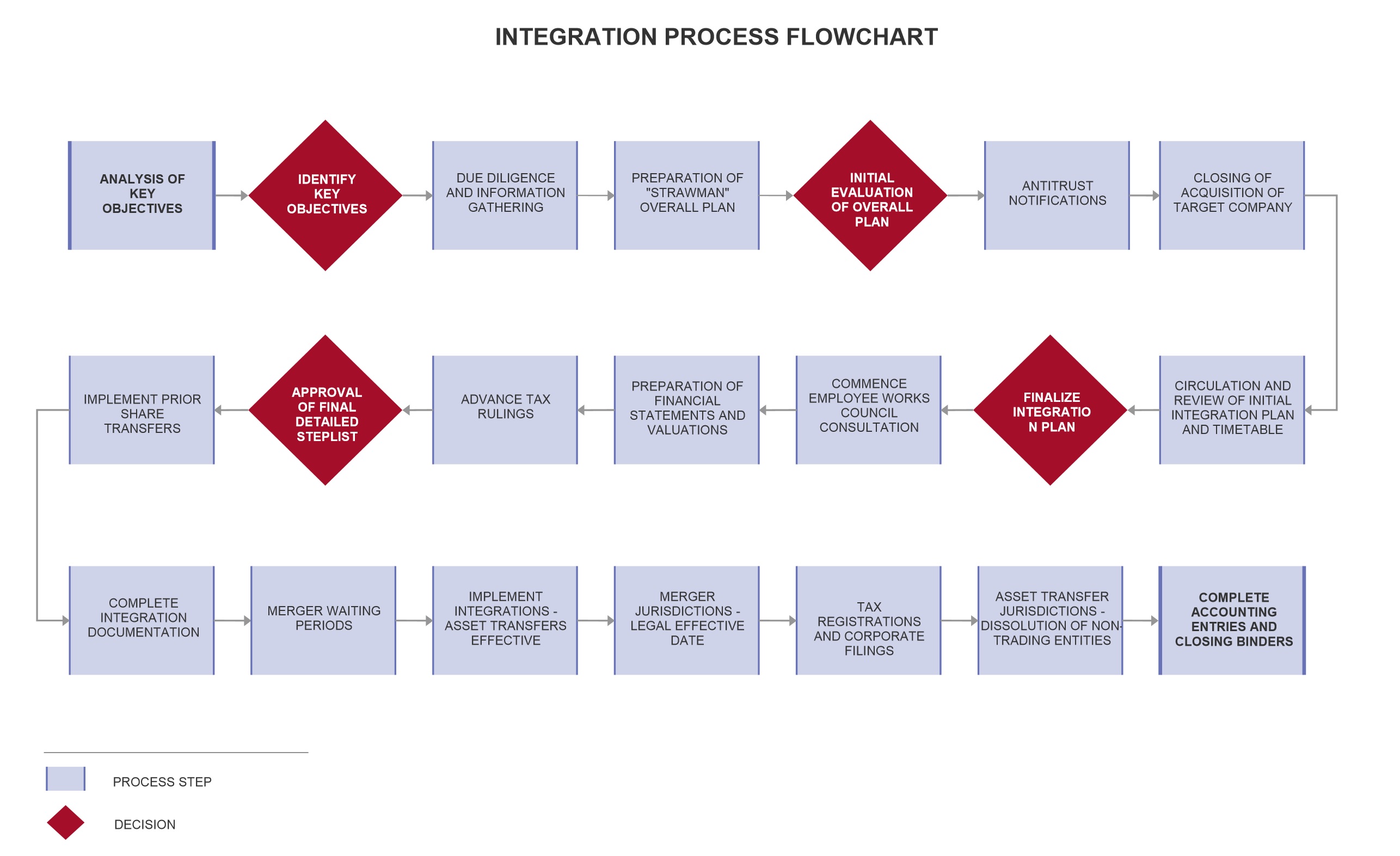
SECTION 3: TAX MATTERS
1. Introduction
1.1 Tax Planning Goals
When planning a post-acquisition integration project it is imperative that management and their advisors consider the tax issues at an early stage to determine the type and magnitude of tax risks and identify tax planning opportunities. Management and the advisors should consider at an early stage how tax planning goals will be balanced with business factors when developing a plan for the structure of the integration.
Many factors influence the tax structuring options available when planning an integration, for example: the existing tax attributes of the companies; tax planning already undertaken; the future strategic plans for the new group; anticipated changes in the local and global tax environment; the tax audit profile of the companies; planned flotations, spin-offs and further acquisitions.
In some situations, management may wish to actively take advantage of tax planning opportunities the integration may create in order to enhance the after tax cash flow. It may, for example, be the stated intention of management to reorganize the shareholding structure of the group to allow for tax efficient repatriation of earnings in foreign subsidiaries to the parent company, to create a global group cash management function, or to minimize the group’s global effective tax rate. In terms of the latter goal, post-acquisition tax planning will, first and foremost, seek to convert and allocate the purchase consideration to tax amortisable asset capitalisation. The second priority will be to push down any leverage incurred in financing the purchase consideration to local entities and thereby reduce their pre- tax earnings.
For planning purposes it is normally straightforward to assess the tax costs of achieving the business objectives of the integration. Tax costs (or tax planning savings) are treated like any other business cost (or benefit) and form part of the cost/benefit analysis that management undertakes when formulating the integration plans.
One difficulty usually experienced by management during the early stage of an integration project is putting a number on the expected tax costs or expected tax planning benefits. It may not be until the fine details of the integration plans are settled that tax issues and costs can be accurately identified. An unexpected tax cost to an integration can be a bitter pill to swallow and emphasizes the need for careful and detailed planning, not only at a local level, but also with a view to global issues.
1.2 Valuable Tax Attributes
In many cases either one or both local subsidiaries may have valuable tax attributes, such as accumulated tax losses (NOLs). Preserving these tax attributes is likely to be an important goal of any integration project. However, it will always be important to weigh the value of tax attributes (taking into account projected profitability of the integrated business and loss expiry rules) against the business costs of preserving the losses. In some jurisdictions, for example, a business lease between the two operating subsidiaries may have advantages over a merger from an NOL preservation perspective, but the lease can be a more difficult structure from an ongoing accounting and business perspective. Which structure is chosen will also depend on the relative value of preserving tax attributes as against the cost of implementing a more cumbersome integration structure.
Where preservation of tax attributes is an important goal, invariably local tax laws contain anti- avoidance legislation which can limit the transfer of the existing NOLs from one group company to another or their use within a group of companies. In the context of a post-acquisition integration project, the operation of these rules must be examined in three circumstances.
First, the original acquisition of the target group by the acquiring group may mean that the existing NOLs have already been lost, are restricted in some way, or cannot be used against profits of the acquiring or a surviving company in the same jurisdiction. In the UK, for example, where a change in the ultimate shareholder of a UK company coincides within three years with a major change in the business of the company, NOLs can be cancelled.
Second, in some jurisdictions share-prepositioning steps can have an impact on tax attributes. In Germany, for example, the transfer of a direct or indirect interest in a German company can (absent a specific relief or exemption) result in the carry forward of NOLs being restricted, or even prohibited. This means that share transfers a long way up the ownership chain that do not involve any German companies directly can impact on the preservation of tax attributes in the German companies. It is therefore crucial, in planning a reorganization, to consider the impact of each step on the integration plan in every jurisdiction. Austria is a good example of a country which preserves losses in most acquisition and integration situations.
Third, in many jurisdictions the manner in which the asset transfer is executed will have an impact on whether the NOLs survive. For instance, in many jurisdictions, the NOLs of the acquiring subsidiary are preserved, but the NOLs of the selling company are restricted. Thus, it may be beneficial to make the company with the NOLs the buying company in the integration. In fact, in many countries, a mere change in the business may be sufficient to restrict or eliminate the NOLs (for example the UK and Australia).
One final point to note in this area is that it is often possible to obtain a binding advance ruling from the relevant tax authority confirming that NOLs will be unaffected by the integration steps (or, where relevant, carry over into the integrated entity. Indeed, in some jurisdictions and circumstances, obtaining a pre-transaction ruling is a prerequisite for NOLs to survive.
The treatment of NOLs in various jurisdictions is summarized at the end of this section.
2. Creation of Branches & Subsidiaries
As explained in more detail in paragraph 2.10 of Section 2, there are a number of advantages to achieving a parent/subsidiary or brother/sister subsidiary relationship prior to an integration. The methods to achieve this relationship include:
- the acquiring company contributing its foreign subsidiaries downstream to the target company;
- the target company distributing its subsidiaries upstream to the acquiring company; or
- the shares of the subsidiaries being sold within the organisation
2.1 Downstream Contributions
The immediate tax consequences of downstream contributions must be considered at three levels. The first level is the tax treatment in the home jurisdiction of the company making the contribution. In many jurisdictions, which include traditional holding company jurisdictions such as Luxembourg and the Netherlands, participation exemptions should allow such contributions to be made tax-free. In other jurisdictions the contribution may have to be structured as a tax-free reorganization either because the jurisdiction does not have a participation exemption or the participation exemption does not apply, where, for example, a qualifying holding period has not been satisfied – which can often be the case in post-acquisition integration projects. Such a tax-free reorganization would usually involve the issue of shares by the company which is receiving the contribution
The next level to consider is the tax treatment for the company receiving the contribution; i.e., is the receipt of the contribution a taxable event? For example, a contribution to a Japanese company without the issue of shares gives rise to a taxable receipt for the Japanese company equal to the fair market value of the shares contributed. In other jurisdictions, for example Switzerland, the contribution may be subject to capital duty.
The third level to be considered from a tax perspective is the tax treatment in the jurisdiction of incorporation of the company being contributed. Is the transfer of legal ownership in the contributed company subject to local transfer taxes, notarial fees and/or registration fees? Does that jurisdiction seek to levy tax on a non-resident shareholder disposing of shares in a company incorporated in that jurisdiction? The taxing rights of the local jurisdiction may be limited under double tax treaties entered into with the jurisdiction in which the company making the contribution is resident, but this is not always the case. Mexico, for example, taxes non-resident shareholders disposing of shares in Mexican companies, and the Mexico-Germany tax treaty allows the Mexican tax authorities to tax gains arising on a disposal of Mexican shares by a German company. Subject to limited exemptions, China, similarly, taxes non-resident shareholders on the disposal of shares in Chinese companies.
2.2 Upstream Distributions
It is usually easier from a corporate law perspective to contribute shares in companies downstream. However, for a variety of other reasons, it may be preferable to distribute shares in companies upstream. From a corporate law perspective, an upstream distribution can be achieved either by declaring a dividend out of distributable reserves, or by way of a capital reduction, the latter being likely to be a more cumbersome, time consuming and costly procedure. Again, tax effects may be seen at three levels. Firstly, is the distribution taxable in the jurisdiction of the company receiving the distribution? Secondly, at the level of the company making the distribution there are two issues to consider, is the distribution subject to withholding tax in the jurisdiction of the company making the distribution and, is the distribution a taxable disposal of the shares? This second issue can be a difficult one as many countries, such as the United States, have complex requirements which must be satisfied for an upstream distribution to be tax free. At the third level the tax consequences in the jurisdiction of incorporation of the company being distributed must be considered (see the issues discussed in paragraph 2.1 above).
2.3 Sale of Stock within the Corporation
The third option is to sell the company directly to another company, which can immediately achieve the relevant parent/subsidiary or brother/sister relationship. This method is sometimes the simplest, especially where a complicated group structure means distributions and/or contributions are impractical. The tax issues discussed above are again relevant.
The sale method can also have other beneficial effects, which can include cash repatriation and the opportunity to leverage local companies with debt.
A company in a particular jurisdiction may be cash rich. This situation may have arisen because current cash generating operations are being used to reduce an earnings deficit on its balance sheet; the parent company has decided not to repatriate cash using dividends because it would become trapped in an intermediate subsidiary that has an earnings deficit (a so-called “dividend blocker”); or it is not tax efficient to distribute profits, either because of the effect of non-creditable withholding taxes or high tax charges in the home jurisdiction of the parent or any intermediate company. The sale of shares in a company or of the underlying business and assets of a company can be used to extract surplus cash out of these types of subsidiaries. In the case of an asset sale, the cash may be further extracted from the company selling the assets either by way of a liquidation, or by utilizing any realized profits on the sale of its assets to declare a dividend.
A sale of shares and/or assets to another company within the group may achieve other benefits. For example, where the original acquisition has been substantially funded by debt, the borrowing company may not have sufficient domestic tax capacity to absorb deductions for the entire financing costs. A primary objective in this situation is to enable maximum tax relief to be obtained for the funding costs in those jurisdictions which have companies with significant tax capacity and this can be achieved by the borrowing company selling shares in subsidiaries (and/or assets) to relevant local subsidiaries with tax capacity.
It is important to examine whether local law will permit a deduction in respect of interest paid in connection with a debt incurred in such a manner. Some countries disallow the deduction in certain circumstances. For example, Singapore does not permit deductions for debts incurred to acquire assets that produce income which is not taxable in Singapore. This includes shares in Singaporean and foreign companies. However, in Singapore it is possible to obtain a deduction for debt incurred to purchase a Singaporean business. In many jurisdictions deductions are not permitted for debt which is incurred for the sole purpose of creating tax deductions. The integration project itself can provide a commercial business purpose for this type of planning.
Other techniques which may be used to create tax deductible interest in a local jurisdiction might include declaring a dividend and leaving the dividend amount outstanding as a debt or undertaking a capital reduction with the payment left outstanding as a debt.
The sale of assets and/or shares across the group also provides an opportunity to rationalize or make more tax efficient the group’s intercompany debt position. For example, a company may assign an intercompany receivable as consideration for the purchase of an asset and/or shares.
3. Tax Issues
3.1 Tax Decrees and Authorizations
Tax authorities in many jurisdictions make provision for binding advance rulings confirming the tax treatment of a transaction in advance of it being implemented. As tax rules around the world become increasingly complex, and the financial reporting requirements associated with the disclosure of uncertain tax positions become more onerous, obtaining certainty as to the tax treatment of a particular transaction as early as possible will often be hugely advantageous. On the other hand, rulings can be costly and time consuming to prepare. Moreover, applying for rulings can lead to audits by local tax authorities, which can impose additional burdens on internal resources that are already stretched by the integration planning and implementation process.
The following factors should be considered in determining whether or not to seek a ruling:
- is an advance ruling necessary to achieve the intended tax result? In France, for example, NOLs will not transfer on a merger unless a prior advance ruling is obtained from the French tax authorities;
- how important is obtaining certainty in advance of the transaction? Groups that are subject to US financial reporting requirements may place a higher premium on certainty than groups that are not;
- is a ruling the only way to obtain the level of certainty required? Where the tax rules relating to a particular transaction are fairly clear, an opinion from third party advisors may provide sufficient comfort on any points of uncertainty;
- how much will the ruling cost? Tax authorities in some jurisdictions (for example Germany) can charge a substantial fee for providing advance tax rulings;
- how long will it take to get the ruling? Tax authorities in some jurisdictions (for example the UK) commit to providing a response to ruling requests within a certain time-frame, whereas others are not obligated to respond at all. This can lead to the ruling process holding up the timing of the transaction as a whole;
- how much disclosure is required? Most tax authorities require that the taxpayer fully disclose all of the details of the transaction before they provide a ruling. Where a new operating or transfer pricing structure is being implemented, the group may feel that early disclosure may result in a less advantageous tax result (for example where the advance agreement will be based on potentially unreliable forecast data); and
- can the ruling be relied upon? Some rulings are more binding than others. In some jurisdictions, a “ruling” is, in reality, merely a written indication of the way in which the tax authorities are likely to view the transaction, which can be departed from on audit.
3.2 Managing Real Estate Tax Transfers
Many jurisdictions impose transfer taxes on the transfer of real estate. Some (for example Germany) also impose transfer taxes on the (direct or indirect) transfer of shares in companies that own real estate in that jurisdiction. As real estate transfer taxes tend not to be deductible for tax purposes nor creditable in the jurisdiction of a parent entity, they generally represent a real out-of-pocket cost to the company.
In many jurisdictions (for example the Netherlands), real estate transfer tax only applies to an indirect transfer of real estate where the company whose shares are transferred is considered “real estate rich”. This can create a tension between commercial considerations, which will sometimes militate towards holding real estate in a separate legal entity to ring-fence liability, and tax considerations, which might suggest holding real estate in an operating entity so that the value of other assets “swamps” the value of the real estate, preventing the company from being considered “real estate rich”.
In practice, exemptions are often available where the real estate (or an interest in the real estate) is transferred within an associated group of companies, which limit the impact of real estate transfer taxes in the context of intra-group reorganizations. For example, the transfer of a company incorporated in New South Wales, Australia is subject to a 0.6% stamp duty, but relief is granted where the transferor and transferee company have been associated for at least 12 months prior to the transfer. However, some jurisdictions (for example Germany) have extremely limited exemptions. In these jurisdictions, it is often necessary to consider bespoke transfer tax mitigation structures to limit the incidence of real estate transfer tax.
3.3 Intellectual Property Migration
Intellectual property represents an important and valuable asset for many groups. Where such assets are owned by entities in high-tax jurisdictions, this can have a significant effect on the group’s overall effective tax rate. Post-acquisition integration often provides a good platform for a reconsideration and rationalisation of a group’s IP holding structure, which in turn can create material tax efficiencies.
Even where IP migration is not an option, it is sometimes possible to structure a merger or business transfer in a way that gives rise to goodwill that can be amortized for tax purposes by the acquiring entity, thus eroding the local tax base post-integration.
3.4 Tax Financial Structure
Post-acquisition integration also often provides an ideal opportunity to rationalize or make more tax efficient the group’s financing structure. For example, a company may assign an intercompany receivable as consideration for the purchase of an asset and/or shares, or may sell assets and/or shares across the group in exchange for debt, as discussed at paragraph 2.3 above. In some cases, it may be possible to make use of “hybrid” instruments in these transactions, the effect of which is that a deduction is available in respect of “interest” paid by the debtor, whereas the return on the instrument is regarded as a tax-exempt return on equity in the hands of the creditor.
In all cases where more tax efficient financing is aimed for, local thin capitalisation limits have to be observed in the planning to avoid “vagabonding” interest i.e. creating interest costs which are not deductible anywhere.
4. Integration Framework for Local Operations
There are two basic methods available to integrate operations in local jurisdictions: either a statutory merger under local law; or the sale of business from one subsidiary to another in the same jurisdiction with a subsequent liquidation of the seller. A summary of these integration methods in thirty three jurisdictions is set out in Section 10.
4.1 Sale, Consolidation, and Liquidation of Business
The simplest approach to achieve the consolidation of operations is often to sell the business of one foreign subsidiary to the other subsidiary in the same jurisdiction. The selling company is subsequently liquidated. In most common law jurisdictions, including the United Kingdom, Australia, South Africa and Singapore, either no simplified statutory merger regime exists or if a regime exists it is, for practical reasons, not commonly used. In these jurisdictions a business sale and liquidation is the only available way to integrate the businesses. The tax goal in carrying out such transactions is to minimize or eliminate any tax charge and if possible to retain any valuable tax attributes of the local seller and the local buyer. To achieve this goal it is usually necessary to have the seller and the buyer either in a group arrangement or consolidated for local tax purposes. In certain jurisdictions this may only be possible if one local company directly owns the other or they are both owned by a common parent company in the same jurisdiction. In the United Kingdom and Australia the tax rules allow for common ownership to be traced through foreign corporations, which can eliminate the need to undertake any share restructuring prior to the consolidation.
When transferring assets from one company to another it is likely that the assets will be treated for tax purposes as being sold for their fair market value unless the asset can be transferred from one group company to another on a tax-neutral basis pursuant to local tax group or consolidation rules.
Management should always consider whether they wish to take advantage of these regimes or whether a better result can be achieved by ensuring that the rules do not apply. The tax impact of the sale of assets out of the country, in particular if IP and/or goodwill/customer relations etc. are included, has to be carefully considered from the perspective of exposure to “transfer of functions” taxation under OECD principles and even tighter local rules, such as those applicable in Germany.
The transfer of trading stock and work in progress from one company to another company in the same jurisdiction will normally give rise to a revenue profit. Local tax rules may allow for such assets to be transferred at their original acquisition cost, although consideration should always be given as to whether existing NOLs within the selling company might be used (always subject to local minimum taxation rules, if any) to set off against any profits arising from a sale at fair market value. This allows the buying company to achieve a step-up in its tax base cost in these assets and is a useful technique if the transfer of NOLs from the local selling company to the local buying company is not possible.
The selling company may have been depreciating its capital assets for tax and accounting purposes. The effects of any intercompany sale upon tax depreciation claims should be considered. In some jurisdictions, opportunities exist for pre-acquisition tax depreciation allowances to be disclaimed and deferred to a post-acquisition period. This can be useful to help mitigate the loss of NOLs, which can occur as a result of the original acquisition or the post-acquisition integration. In some situations companies may not want NOLs or other tax attributes to transfer as part of an asset sale to the identified surviving company, for example a US parent company may have been utilising in the US the NOLs of a foreign branch. If the foreign branch NOLs transfer to a foreign subsidiary of the US parent company as a matter of local law, the US parent may be faced with the recapture of the US tax savings generated as a result of using its foreign branch’s NOLs in the US.
In most jurisdictions the sale of assets from one company to another will be subject to value added tax or a similar tax. Usually such tax charged by the selling company to the buying company is creditable to the buying company, however, this can give rise to a cash flow disadvantage to the group when carrying out such transactions in a large number of jurisdictions. In many jurisdictions, and this is certainly true for EU member countries, transfers of businesses as a going concern are ignored for VAT purposes.
Stamp duties can considerably add to the cost of a local asset sale, especially when valuable real estate is being transferred from one company to the other. Fortunately, reliefs are usually available. Any such reliefs may dictate the manner in which the sale takes place, for example it may be structured as an assets-for-shares sale or the sale may have to be delayed until a particular group relationship has been in place for a relevant holding period.
4.2 Local Statutory Merger
When available, the recommended approach is often to use a statutory merger under local law. Such a transaction will typically (though not always) be tax-free from a local tax perspective, although post merger conditions may also apply. Depending upon the jurisdiction, the tax attributes of the target or absorbed company may or may not carry over. In particular, in a number of jurisdictions the future availability of the NOLs of the absorbed company will be restricted or lost entirely. In such jurisdictions, it is often preferable to make the company with the NOLs the survivor, if possible within the objectives of the integration and under local law.
Real estate transfer taxes are still chargeable on mergers in many jurisdictions, and these costs may dictate that the company with no real estate or the least valuable real estate is the disappearing company in a merger.
Again the local tax treatment of a merger is just one consideration. The tax treatment on a global level should always be considered. When two local companies merge whilst in a brother/sister relationship, or a local parent company merges downstream and into its local subsidiary, any foreign shareholder is likely to be treated as disposing of its shares in the disappearing company for foreign tax purposes. It may be that there is no foreign tax charge because of a relevant participation exemption, the application of the EU Merger Directive, foreign tax laws classifying the merger as a tax-free reorganization, the utilisation of existing NOLs by the foreign company, or simply because the foreign shareholder has a base cost in the disappearing local entity equal to its market value as a result of the prior transfer to it of the shares in the disappearing company as part of the integration planning.
In many jurisdictions, a merger will have a retroactive effective date for tax or accounting purposes. A retroactive effective date can allow for earlier consolidation and utilization of favorable tax attributes, such as NOLs.
The desirability of utilizing merger regimes from a tax perspective must be weighed against operational objectives, which sometimes can be frustrated by the merger process. Merger regimes often require the preparation and filing of recent balance sheets or full accounts of at least the absorbed company and in many cases these accounts will need to be audited. The time required to prepare such accounts, combined with mandatory waiting periods to protect creditors after a public notification has been made can frustrate the operational need to combine the local business of the target company with that of the acquiror quickly so that business efficiencies and management control are achieved.
Finally, a comparatively recent development is the EU cross-border merger which can be used to simplify corporate structures in the EU and economize on compliance costs. In this scenario, a company in one member country can be merged cross-border into another company, leaving behind a branch, for tax purposes a permanent establishment, with the assets and liabilities of and the business as formerly conducted by the merged entity. In most cases such merger can be conducted without realisation of taxable income, although other tax attributes such as NOLs may not remain available in some countries (for example Germany), although they remain available in others (for example Austria).
4.3 Alternative Approach to Business Consolidation & Merger
Many jurisdictions have some form of group or consolidated tax regime that can be used as an alternative to a tax-free asset sale or merger (for example UK group relief, French consolidation, and German Organschaft). Essentially, this approach allows the two operations to share NOLs and to obtain the benefits of consolidation from a tax perspective, but it does not consolidate activities on a business and operational level. Thus, this approach is not recommended where an actual consolidation is desirable and can be completed. This method can be effective if there are limited overlapping activities or redundancies, structural tax constraints or costs preventing operational consolidation.
Another alternative to an actual consolidation is a lease by one company of its entire business to the other company. This approach does allow the parties to consolidate on an operational level. For transfer pricing purposes the lessor must earn an arm’s length profit on the leased business.
This structure may be useful in two particular circumstances. The first situation is where the surviving company in a jurisdiction wishes to use the assets of the disappearing company in its business, but cannot immediately acquire them. This may be because permits, licenses, or leases cannot be assigned without consent, or the companies are not yet in the optimum structural relationship from a tax perspective to consummate a business sale.
In France, Germany, Austria, and certain other jurisdictions the business lease is a method used to prevent the company which is identified as the disappearing company prematurely being treated as disposing of its assets to the surviving company as a result of the surviving company utilizing such assets in its business prior to their legal transfer.
Such a deemed disposal of assets can have unfortunate tax consequences if the companies are not in the correct relationship at the time and negate the benefit of a subsequent tax-free merger.
The second scenario is where trading NOLs in the disappearing company will not transfer to the surviving company. It may be possible to use these NOLs effectively by claiming a deduction for the leasing expense in the surviving company and off-setting the NOLs in the disappearing company against its leasing profits.
5. Conclusion
As the above discussion demonstrates, the steps for integrating duplicate entities are similar and follow established patterns. The patterns are relatively well known and thus planning typically focuses on the preparatory steps to the integrations. These preparatory steps should allow the taxpayer to maximize the benefit of the domestic and foreign tax attributes, avoid unnecessary costs such as stamp taxes, and take advantage of one-time benefits. More importantly, this process allows the group to structure itself in a tax efficient manner that yields benefits for years to come. Although every integration project involves some new and unique planning issues, this chapter should serve as a road map for approaching the process, identifying the opportunities, and avoiding the pitfalls.
Analyzing Its Retroactive Effects and Tax Losses
When one multinational company acquires another company and its international subsidiaries, a key aspect of the integration of the two multinational groups is to consolidate duplicate operating companies so that there is only one operating company in each country. The following summary of integration methods has been prepared on the following assumptions.
(1) Each company is a 100% subsidiary of the same parent company or one is a 100% subsidiary of the other (subject to any mandatory minority shareholding interests).
(2) The surviving company of the integration will be one of the original operating companies, not a newly incorporated company. Alternate methods are available in many jurisdictions and this summary should not be relied on instead of obtaining specific legal advice.
1. AMERICAS
Brazil

Canada
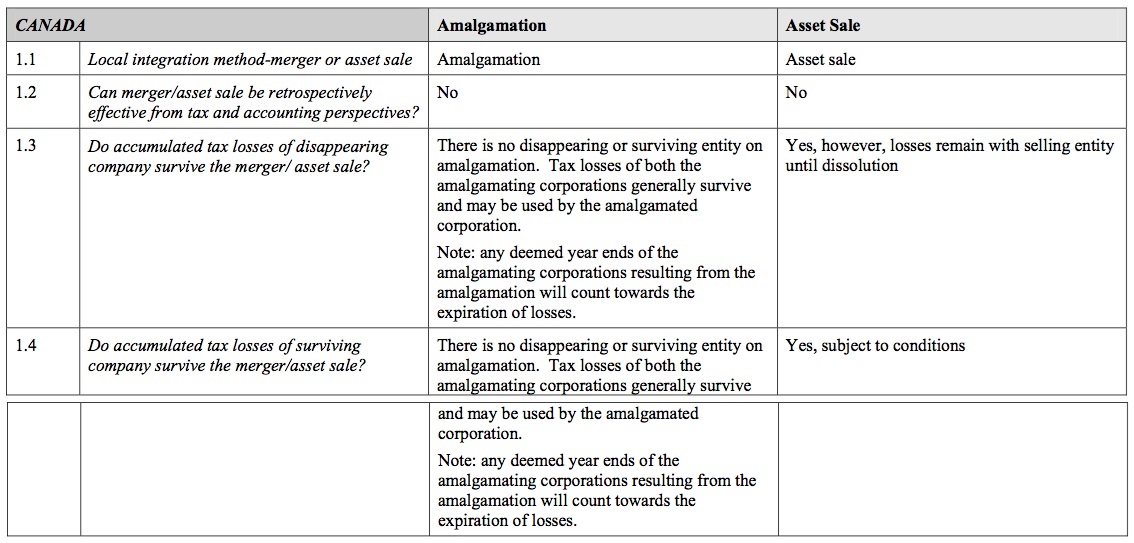
Chile
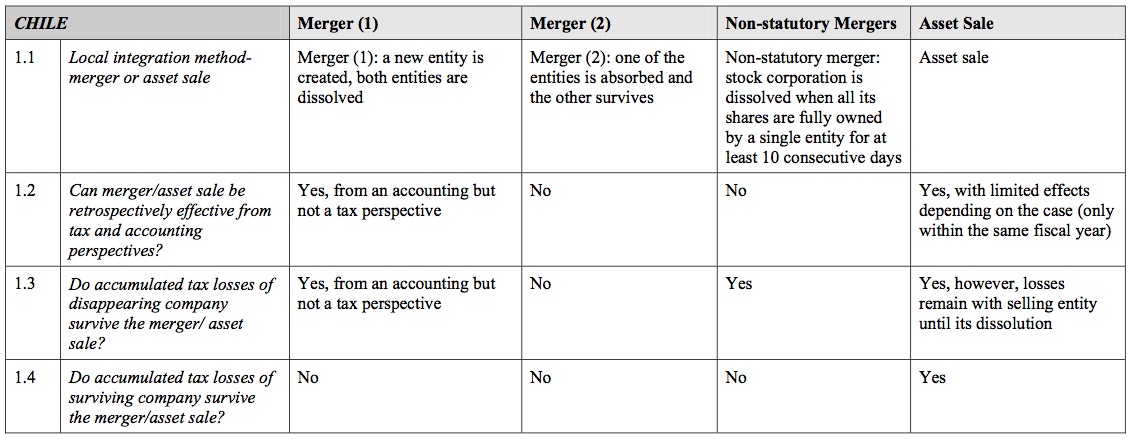
Colombia
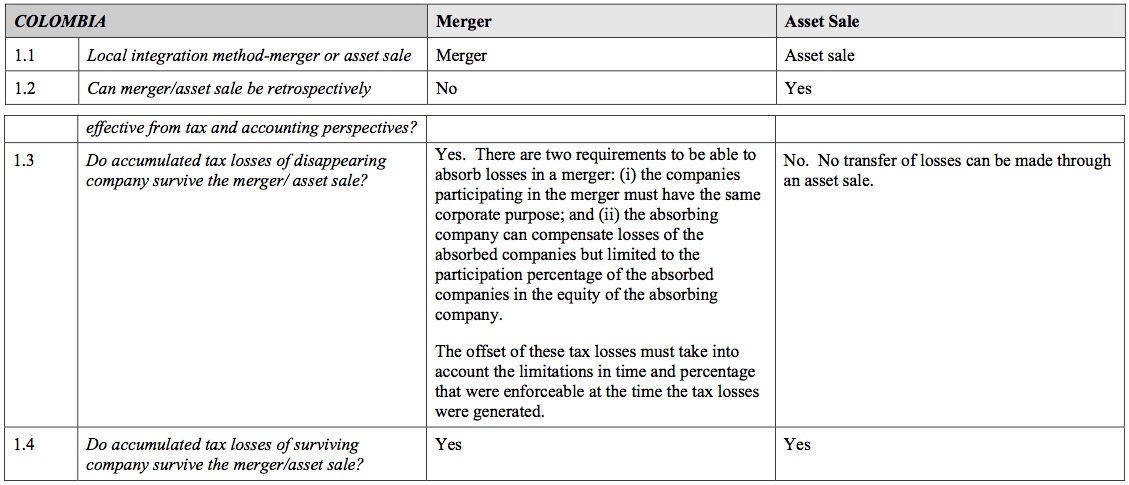
Mexico

Venezuela

United States
2. ASIA PACIFIC REGION
Australia

China

Hong Kong
Indonesia

Japan

Malaysia

Philippines
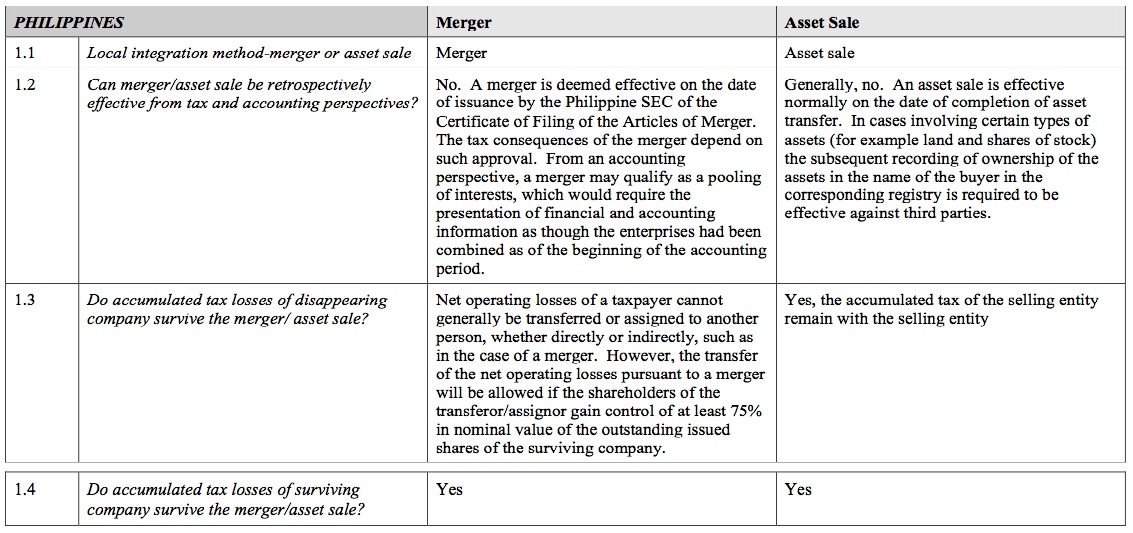
Singapore

Taiwan
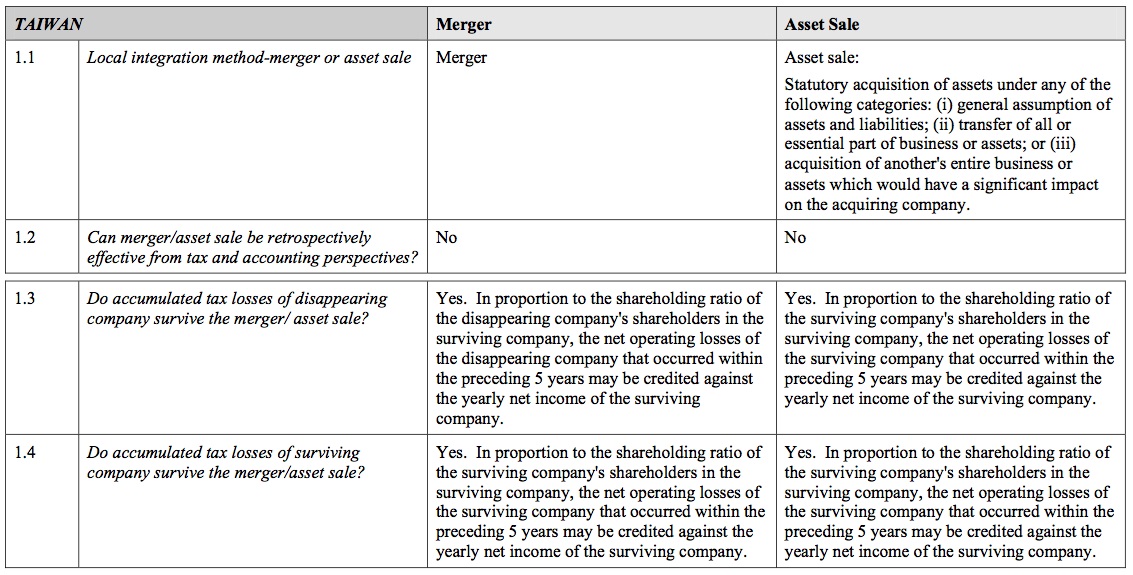
Thailand

Vietnam

3. EUROPE, MIDDLE EAST AND AFRICA
Austria
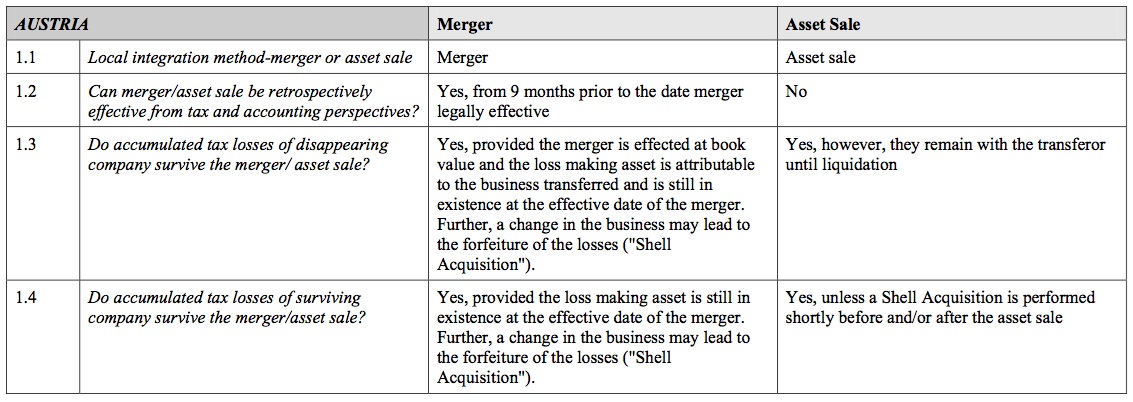
Azerbaijan
Belgium
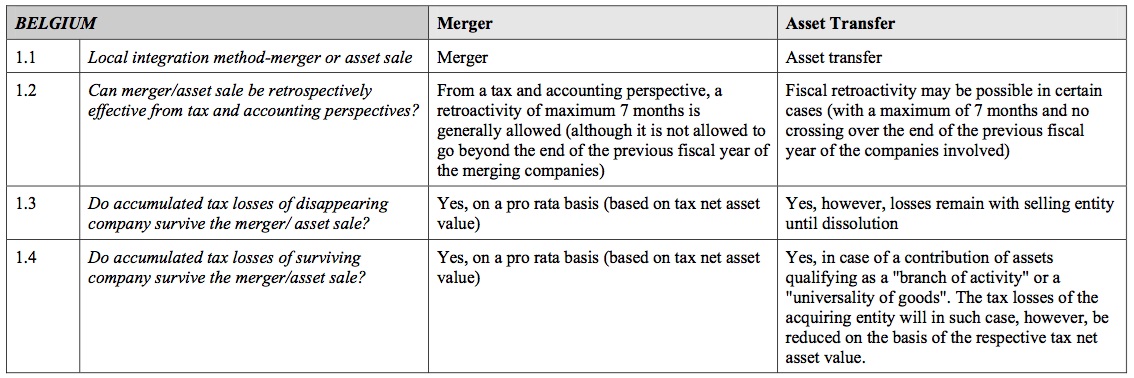
Czech Republic

Egypt

France
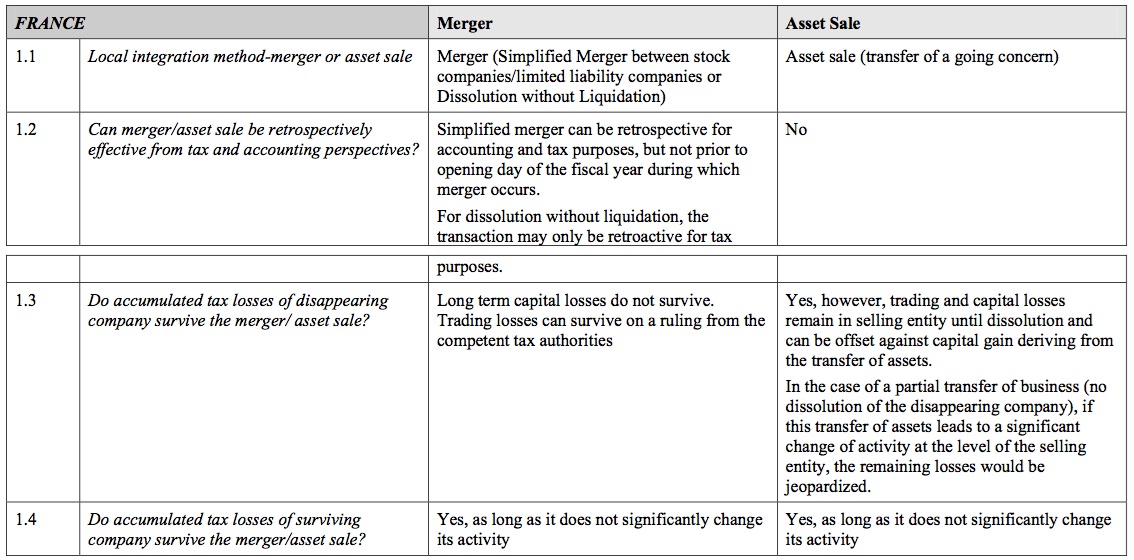
Germany

Hungary

Italy
Kazakhstan

Luxembourg

Netherlands
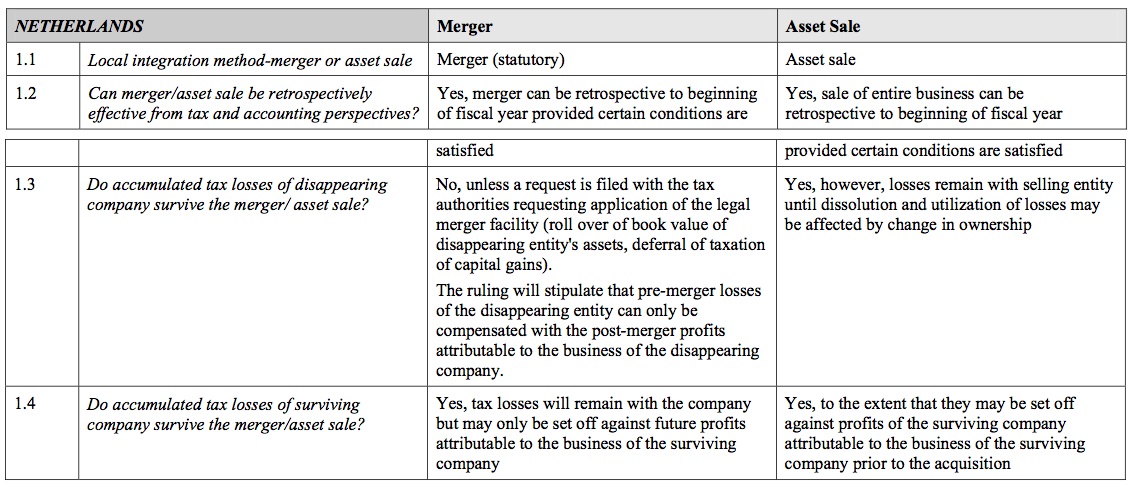
Poland

Russia

Saudi Arabia

Spain

Sweden

Switzerland
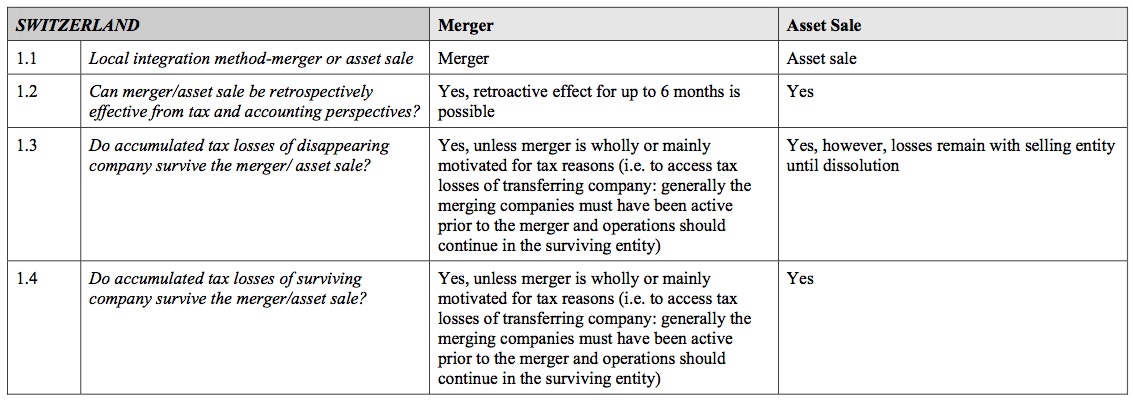
Ukraine

United Arab Emirates
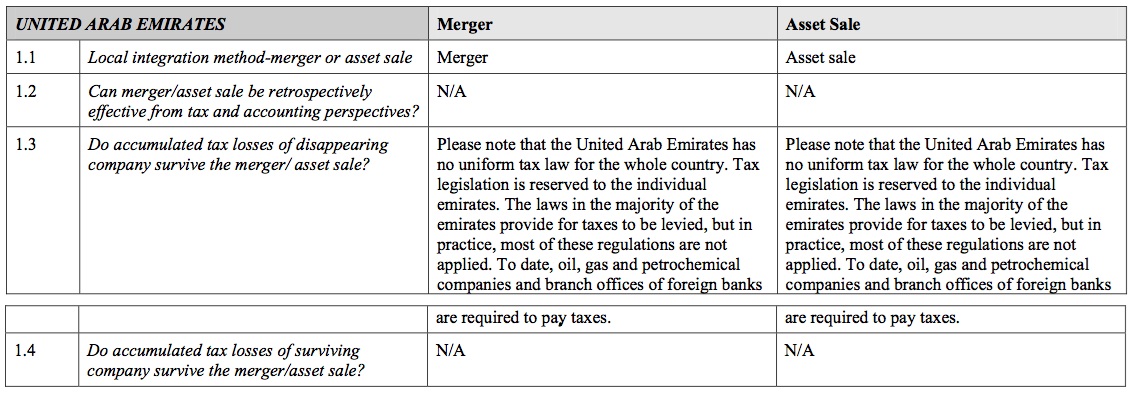
United Kingdom

SECTION 4: A COMPREHENSIVE INTEGRATION CHECKLIST
A. Data Collection Phase
1. Identification of Strategic and Key Objectives
1.1 What are the company’s business goals?
1.2 What are the company’s priorities?
1.3 What are the company’s plans for employee transfers and reductions in workforce?
1.4 What are the company’s timing and sequencing priorities?
1.5 Are there entities that should not be integrated, or should the integration method be driven by isolation of liabilities considerations (for example, environmental)?
1.6 What are the constraints to moving assets, entities and people?
2. Key Information Gathering
2.1 What countries do the businesses operate in?
2.2 Where are the revenues being earned?
2.3 Where are the taxes being paid?
2.4 Where are the tax attributes (for example, accumulated tax losses, tax credits, tax holidays)?
2.5 Where are the tangible assets?
2.6 Where are the intangible assets?
2.7 What are the company’s and the newly-acquired target’s current operating models and transfer pricing policies?
3. Local Due Diligence Review
3.1 Following the identification of the high level strategic objectives and characteristics of the group, the next stage is a more detailed information gathering phase.
3.2 Identify information obtained as part of the due diligence process conducted for the original acquisition of the target’s parent company.
3.3 Company information (see Exhibit A at the end of Section 4 for detailed checklist).
3.4 Branch and Representative/Liaison Offices information (see Exhibit B at the end of Section 4 for detailed checklist).
3.5 Details of any works council/union/employee representation, including regional forums such as European Works Councils, and any employee change in control/severance plans that may trigger benefits on an integration.
4. Technology
4.1 Audit and evaluate IT systems and the requirements of the participating entities, including impact on supply chain and financial reporting.
4.2 Carefully plan IT integration.
4.3 Prepare the groundwork to ensure that the Enterprise Resource Planning (ERP), invoicing and accounting IT systems are capable of and are properly configured to begin processing transactions for the newly integrated entities, for example:
- if the acquired subsidiaries are using a different order processing and invoicing software, ensure that after the integration the acquired company products can be properly invoiced under the pre-existing order processing and invoicing software.
4.4 Ensure that IT systems are configured to accommodate any changes in the order flow or other intercompany commercial arrangements that may be planned as part of the integration, for example:
- switching to a commissionaire structure from a buy-sell distributor arrangement.
5. Regulatory and Antitrust Issues
5.1 Does the integration require any merger control notification or approval?
5.2 If merger control approval was obtained prior to closing of acquisition, does it cover post-acquisition integration?
5.3 If information will be exchanged prior to closing and/or during a merger control suspension period, is the information to be exchanged:
- permitted information;
- controlled information; or
- prohibited information?
(See Section 8 for further details.)
5.4 Does integration require any foreign investment approvals or registrations? For example:
- registration of new shareholders.
5.5 Does integration require any exchange control notices or approvals?
5.6 Do local laws require the surviving entity to obtain:
- general;
- asset-specific; or
- industry-specific governmental permits, licenses or approvals to continue the merging/transferring entity’s business, for example:
- general laws and regulations governing general business licenses and permits, transfer of intellectual and real property, or industry-specific laws and regulations covering areas such as defense, media, food and drug, health, safety, pharmaceutical, utilities, brokering, banking, securities.
5.7 Has the merging/transferring entity received any governmental subsidies, grants or other incentives?
- if so, does the integration require notice to or approval by the relevant government agency?
6.1 Review, integrate and update corporate compliance programs for example:
- Sarbanes-Oxley (including auditor independence, certification and reporting, directors’ loans, ethics, whistle blower protection and document retention issues);
- Foreign Corrupt Practices Act;
- boycott;
- export controls;
- bribery/corruption;
- money laundering;
- antitrust/competition;
- corporate governance.
B. Strategic Integration Mapping
7. Integration Method
The information gathering phase will allow planning to commence on the local integration methods.
7.1 Identify local integration method:
- does local law provide for a statutory merger; or
- will the integration have to be accomplished by means of a business/asset transfer with subsequent dissolution?
7.2 Identify surviving entity after careful consideration of all relevant factors, for example:
- preservation of tax attributes;
- liabilities of participating entities;
- impact on employees and employee representative bodies;
- internal operational and “political” considerations.
7.3 What is the preferred pre-integration structure? Should the entities to be integrated be structured as:
- brother/sister; or
- parent/subsidiary prior to the integration?
7.4 What documentation is required to effect the proposed integration? for example:
- notarial deeds;
- asset sale agreements;
- registrations with the commercial registry or trade register, amendments of share registers.
7.5 Will the chosen integration method require the establishment of new entities?
- if yes, consider the impact on timing, as in some jurisdictions, the establishment of a new entity may take several months and may also require new VAT registrations.
7.6 Will the chosen integration method require the registration of new branches, as in the case of a merger, branches of the merging entity may not automatically transfer to the surviving entity?
- if yes, consider the timing of local branch registrations in some jurisdictions. For example, in China, the establishment of a branch requires: 1) name reservation (in most cases); 2) registration with the Administration for Industry and Commerce; 3) post-registration procedures (for example application for ancillary certificates); 4) register home recordal (can be done concurrently with step 3), which may take between 2-3 months in total. If the branch carries out manufacturing or production activities, the branch may need also to apply for an environmental impact assessment which can take up to 6 – 8 weeks. Further, a branch may require additional pre-approvals if operating in certain industries, for example, retail or logistics.
7.7 What is the approximate timeline for the chosen integration method, from the initial instructions or from the date on which all information including financial statements become available, to the effective date of the integration?
7.8 With regard to mergers, can the merger be made effective retrospectively for tax and accounting purposes?
- if so, what is the deadline for filing the merger application? For example. in Germany, 8 months after date of merger accounts.
8. Financial
8.1 What financial statements or independent valuations are required for any share transfers and the chosen integration method?
8.2 Are there audit or valuation requirements?
8.3 Will the auditors of the target companies be changed? If yes, how will this impact the timetable for preparation of accounts required for integration?
8.4 Are they imposed on both entities?
8.5 What is the proposed basis for calculating the purchase price for asset transfers?
8.6 Have any assets, such as plant and machinery or shares in subsidiaries been provided as security to any financial institutions?
8.7 How will the integration impact pre-existing cash pooling or other group treasury services?
9. Transferring Assets
9.1 What types of assets will be transferred? For example:
- tangibles;
- intangibles;
- contracts, including leases;
- real property;
- automobiles.
9.2 What documents/steps are required to transfer each type of asset?
- is inclusive wording in a general asset or business transfer agreement sufficient; or
- is an additional form or deed and/or recordation/registration required, for example notarial deeds to transfer title to real property?
9.3 What, if any, are the consideration requirements under local law? For example:
- is there a need to reflect a cash purchase price or other consideration, or a currency requirement?
9.4 Does the consideration need to be allocated amongst assets? For example:
- for exchange control purposes;
- for income tax purposes;
- for V A T purposes;
- for stamp duty/transfer tax purposes.
9.5 Do any of the contracts (for example office leases, equipment leases, service agreements, distributor agreements, customer agreements, licenses, supplier agreements, utility and telephone accounts) contain:
- notice; or
- approval requirements, for example change of control provisions?
9.6 Do governmental or regulatory licenses/permits transfer automatically or do local laws require prior governmental or regulatory approval, license, or registration?
9.7 Are transfer or real estate taxes payable? If yes,
- are intra-group exemptions available?
- if not, can the real estate or transfer taxes be minimized?
10. Employment
10.1 Consider
- local employment laws;
- employment agreements (or forms thereof);
- employee policies;
- works councils, collective bargaining or other labor agreements;
- requirements for notice, consultation or other steps in relation to employees and their representatives and to consider mechanism for transfer (see 10.6).
10.2 Identify effect of employment law requirements and confirm impact on timing of chosen integration method.
10.3 If workers’ representatives, works councils or other employee collective bodies exist, determine whether prior notification, consultation or approval is required.
- if so, analyze any notice and waiting periods required by law or collective bargaining agreements.
10.2 Identify effect of employment law requirements and confirm impact on timing of chosen integration method.
10.3 If workers’ representatives, works councils or other employee collective bodies exist, determine whether prior notification, consultation or approval is required.
- if so, analyze any notice and waiting periods required by law or collective bargaining agreements.
10.2 Identify effect of employment law requirements and confirm impact on timing of chosen integration method.
10.3 If workers’ representatives, works councils or other employee collective bodies exist, determine whether prior notification, consultation or approval is required.
- if so, analyze any notice and waiting periods required by law or collective bargaining agreements.
10.4 Determine whether the integration method will result in any changes of employment relationships.
10.5 If employees will be transferred from one entity to another:
- does the employment transfer automatically on the same terms and conditions; or
- is an offer and an acceptance by the employees, termination and rehire or a tripartite agreement required?
10.4 Determine whether the integration method will result in any changes of employment relationships.
10.5 If employees will be transferred from one entity to another:
- does the employment transfer automatically on the same terms and conditions; or
- is an offer and an acceptance by the employees, termination and rehire or a tripartite agreement required?
10.6 If an offer and acceptance, termination and rehire or tripartite agreement is required,
- when;
- how (nature of written offer and any termination/resignation requirements);
- and upon what terms (for example is a severance payment mandatory in any event);
must offers be extended?
10.6 If an offer and acceptance, termination and rehire or tripartite agreement is required,
- when;
- how (nature of written offer and any termination/resignation requirements);
- and upon what terms (for example is a severance payment mandatory in any event);
must such offers be extended?
10.7 If employees do not accept any new offer of employment, object to the transfer of their employment, or are to be terminated, what are the:
- local notice requirements;
- severance/termination indemnities payable?
10.7 If employees do not accept any new offer of employment, object to the transfer of their employment, or are to be terminated, what are the:
- local notice requirements;
- severance/termination indemnities payable?
10.8 Identify opportunities for planning redundancy terminations to minimize notice and severance liabilities and maximize the deductibility of such costs.
10.9 Is any prior information and consultation with works councils, employees representatives or trade unions required?
- if so, what are the notice and waiting periods required by law or works councils or collective bargaining agreements?
10.10 If there is no entity (or registered branch) present in a jurisdiction, determine which entity will be the employer of the assumed or hired employees.
10.11 Determine whether local law requires a local employer;
- if so, contemplate incorporation of new subsidiary or registration of branch or other legal presence in such jurisdictions.
10.12 Confirm payroll transfer requirements and whether the new employer of the assumed or hired employees has to register as an employer, for example:
- tax authorities;
- social security registrations.
10.12 Confirm payroll transfer requirements and whether the new employer of the assumed or hired employees has to register as an employer, for example:
- tax authorities;
- social security registrations.
10.13 Confirm whether the change in employer impacts any visas and works permits and timing of the transfer of such visas and work permits.
10.14 Confirm whether there are any independent contractor or outsourcing agreements and determine impact of the post-acquisition integration on such agreements
11. Employee Benefits/Equity Awards
11.1 What are the employee benefit/equity award considerations in connection with employee transfers? For example:
- treatment of outstanding equity awards;
- integration and harmonisation of employee benefit plans.
11.2 Identify all employee benefit and equity plans covering employees involved in the integration and the person with authority to take action with respect to the employee benefit plans.
11.3 What are the required annual employer contributions, if any?
- are such contributions current?
11.4 What are the required annual filing and reporting requirements, if any?
11.5 Have assets been set aside to fund or finance the employee benefit plan obligations?
- are such plans fully funded?
- do such assets appear on the balance sheet of the business?
11.6 Will the integration trigger any funding obligation? For example, in relation to pensions schemes which are in deficit.
11.7 Will there be a transfer of assets or insurance policies to fund or finance the employee benefit plan obligations?
11.8 Which benefit plans will be consolidated or terminated at the closing of the local reorganization?
- what action is necessary to effect the transfer of the underlying assets?
- identify and assess any contractual impediments (for example notice requirements, early termination penalties, negotiated benefits) as well as any tax or regulatory requirements (for example regulatory filing and reporting requirements).
- consolidate or terminate overlapping employee benefit plans which provide benefits which are otherwise covered by existing plans.
11.9 What terms apply to outstanding equity awards?
- how do these terms differ from the company’s other equity grants?
- ensure that different terms can be administered appropriately.
11.10 Are tax/regulatory filings in any countries required with respect to outstanding awards?
- were outstanding awards subject to tax-qualified status and can such status be preserved in the integration?
- are additional regulatory filings required?
12. Intellectual Property
12.1 What is the current intellectual property:
- ownership structure (legal and beneficial); and
- licensing structure?
12.2 What is the desired intellectual property:
- ownership structure; and
- licensing structure?
12.3 Evaluate availability of tax planning opportunities arising in connection with restructuring intellectual property holding and licensing structure.
12.4 Analyze intercompany license and other intellectual property agreements for overlap and inconsistencies and reconcile the same.
12.5 Where appropriate, transfer existing trade marks and other intellectual property to reflect the integration and record transfers, if required.
12.6 Are any third party consents required for the contemplated transfers?
12.7 Consider the availability and protection of new trade marks.
13. Director, Officer and Other Management Positions
13.1 What director or officer resignations or new appointments will be required?
- confirm any nationality, residency and/or qualifying share requirements under local law.
13.2 Have any of the directors, officers or other signatories left or will any of them leave the organization following closing?
13.3 What are the employment issues, if any, related to any changes in position and/or scope of authority as a result of the realignment of management (for example constructive termination)?
- if so, evaluate the need to replace such directors, officers or other signatories to ensure that authorized signatories are available for the execution of the restructuring documentation.
13.4 Identify updates to D&O insurance policies and consider update to any contractual indemnities.
13.5 Review all existing powers of attorney and other delegations of authority to see if changes are required.
14. Claims and Litigation
14.1 Review claims and litigation of the participating entities and identify the impact of the assignment of claims (by operation of law in the case of a merger or otherwise) on ongoing litigation.
14.2 Identify notification requirements with regard to the opposing side and, in litigation, relevant courts, arbitrators or mediators.
14.3 Make appropriate notifications of changes to notice provisions in contracts to which merging/transferring entities are a party.
15. Banking and Finance
15.1 Review credit agreements and documentation to determine whether notice of or approval for the proposed integration is required.
15.2 Do any of the credit agreements provide for mandatory waiting periods?
15.3 Update security arrangements where required.
15.4 Anticipate and plan for the required funding of costs of integration.
16. Data Protection
16.1 Is personal data (for example customer accounts, employee records, marketing databases) held by the target entity to be integrated with that held by the existing entity?
- if yes, are the existing entity’s uses of personal data broader than those of the target entity or vice versa?
To the extent that the merging/transferring entities are subject to the data protection laws of EU countries, the following issues will be relevant (although each EU country will have its own specific requirements based on these general points):
16.2 Will post-integration uses of personal data by each entity be lawful, by reference to the limited justifications available?
- if processing has previously been justified by obtaining consents from individuals, are the consents sufficient to cover additional uses of the data following integration (for example marketing of new affiliates’ products or services?)
16.3 If, prior to the acquisition, express consents were considered unnecessary due to the limited uses and disclosures of personal data, re-consider the position in the light of any wider uses or disclosures following the integration.
16.4 Irrespective of the issue of consents, have individuals whose personal data is processed by each entity been provided with sufficient information (including information about any new uses or disclosures) to ensure that the processing is lawful?
16.5 Is personal data transferred outside the European Economic Area (“EEA”) by either entity?
- if so, obtain revised individual consents, to include new recipients of data outside the EEA (for example new parent company in the US); or
- if new consents are not obtained, target entity should only transfer data outside the EEA if transfers can be justified without consent (for example safe harbor, intra-company agreements, adequacy of recipient jurisdiction).
16.6 Update data protection registrations with regional/national authorities. (In countries outside the EU the laws governing data protection vary greatly.)
16.7 Where consents are required or are appropriate these should be obtained or updated to the extent personal data is going to be processed for different purposes, by different entities and/or in different locations than the subjects of the data might reasonably have expected, or specifically consented to, when they first disclosed the data.
17. Third Party Trading Model and Relationships
17.1 Review structure of current trading relationships with third parties of both businesses:
- identify common relationships;
- identify conflicts and inconsistencies.
17.2 Consider key commercial contracts and identify potential impact of integration on these relationships.
17.3 Decide upon trading relationship structure of combined group.
- terminate any redundant existing third party suppliers;
- review and update third party contracts.
17.4 Identify:
- business name of combined group;
- transition period for branding changes;
- whether value in acquired name and if it should be trademark protected.
17.5 Identify changes to:
- invoices and other trading disclosures;
- customs applications prior to transfer, otherwise goods may be held up at borders if paperwork defective;
- packaging and sales materials.
18. Intercompany Trading Model
18.1 Review existing intercompany trading models and determine future trading model. For example:
- commissionaire;
- distributorship;
- commission agency.
18.2 Review intercompany agreements and identify renewal or termination requirements of intercompany agreements, for example:
- notice or renewal period;
- termination compensation under local law.
18.3 Prepare or update intercompany agreements implementing the chosen trading model.
18.4 Identify and plan the implementation of operational changes, for example:
- accounting;
- VAT transactions;
- customs and exports;
- sales documentation, including order forms, invoicing, etc.
19. Real Estate
19.1 Evaluate the need for local real estate and leased office, manufacturing, warehouse and other space.
19.2 Will integration result in the physical integration of the operations and relocation of employees?
19.3 If so, review local leases to determine which leases will need to be terminated and identify:
- timing of the termination;
- notice requirements for termination;
- costs of termination.
19.4 Plan ahead for physical moves of people, offices, equipment, etc.
19.5 Review leases of all local entities to identify landlord consent requirements triggered by integration (for example change of control, assignment of lease).
C. Execution of the Integration Plan
20. Pre-Integration Share Transfers
20.1 If share transfers are necessary to achieve the desired integration structures, how will the shares be transferred?
- contribution;
- distribution or dividend; or
- sale;
- and, how will the purchase price or transfer value be determined (for example valuations, net book value, shareholder carrying value)?
20.2 What documentation is necessary to effect such share transfers? For example:
- share transfer forms;
- notarial deeds;
- endorsements of original share certificates;
- amendments of articles;
- registrations with the commercial registry or trade register;
- notices to the company.
20.3 If shares are represented by share certificates:
- where are the share certificates located?
- must the share certificates be endorsed?
- must new share certificates be issued?
- is a power of attorney needed?
20.4 Consider corporate law requirements of:
- transferor;
- transferee;
- target; in relation to:
- statutory and fiduciary duties of directors;
- unlawful returns of capital to shareholders;
- financial assistance for the acquisition of shares;
- corporate benefit.
20.5 Consider tax implications for:
- transferor;
- transferee; and
- target.
20.6 Consider accounting treatment of transactions in:
- management accounts; and
- local statutory accounts.
21. Corporate Approvals
21.1 What corporate approvals are necessary to effect the integration? For example:
- shareholders’ approval;
- board resolutions;
- works councils, union;
- audit committee resolutions; and
- management board approvals.
21.2 If the articles of association or by-laws restrict the integration method, can corporate approvals be simplified by amending the articles of association or by-laws ?
22. Dissolutions
22.1 List dormant, non-trading or otherwise excess entities.
22.2 Identify any reasons to retain and not to dissolve dormant, non-trading or excess entities.
22.3 Prepare dissolution timetables for excess entities.
22.4 Identify compliance and audit requirements for period until dissolution.
Exhibit A: Consolidation of Companies – Merger or Business Transfer
Initial Information Request
The following information is required to analyze the commercial and tax issues involved in consolidating local subsidiaries. Information will also be requested which will be necessary to advise on how best to structure the commercial relationships with the local entities after the consolidations.
1. Fundamental Corporate and Legal Information
The purpose of collecting this information is to ensure that the documentation necessary to achieve all of the corporate reorganizations can be completed accurately, efficiently, and in accordance with the legal entity’s existing organizational documents.
1.1 Organizational chart.
1.2 Corporate name, address, purpose, business activity, and date and place of incorporation.
1.3 Corporate documentation (for example articles of incorporation, by-laws, resolutions of shareholders and directors).
1.4 Current corporate officers and directors, including their present location and employer.
1.5 Details of all intellectual property rights owned: third party licenses, development agreements.
1.6 Commercial agreements: sales agreements, distribution agreements, customer support agreements, non-disclosure agreements.
1.7 Leases: real property leases, personal property leases, including information regarding leases to be terminated.
1.8 Loan agreements and financing documents.
1.9 Licenses, court decrees, or other legal restrictions which affect flexibility of reorganization.
1.10 List of each shareholder or quotaholder, number of shares held by such shareholders or quotaholders, and whether nominee or other minority shareholders exist.
1.11 If nominee shareholders exist, copies of nominee or trust agreements.
1.12 Copies of other agreements, if any, relating to the shares of the company (for example option agreements, shareholders’ agreements, pledge agreements, etc.).
1.13 Confirmation whether the company is party to any dispute or legal proceeding and whether there are any pending claims or causes of action.
1.14 List of any outstanding liabilities that have not been discharged in full, including any guarantees and indemnities.
1.15 Confirmation whether the company has any foreign or domestic branches, representative offices or other separate business registrations.
1.16 Service provider currently responsible for corporate records and maintenance
2. Tax Considerations
A. Information Relating to Preservation of Tax Attributes
A significant aim of the consolidation planning will be to ensure the preservation and efficient utilization of any valuable tax attributes in the local entities, such as loss carryforwards, research or other credit carryforwards, and the like. To the extent that restructuring costs might result in a current year loss, the incidence of those losses must be planned in order to ensure that they fall in the appropriate legal entity, so that the restructuring costs result in the greatest tax benefit, including, possibly, via deductions in the parent company. The following questions principally relate to the disappearing and surviving foreign entities, but 2.6 should also be addressed for the parent country entities.
2.1 Local net operating loss carryovers.
2.2 Local tax credits (including V A T).
2.3 Other tax attributes: tax holidays, incentives, grants, rulings, etc. (please provide copies of documents relating to such tax attributes).
2.4 Expected taxable income/loss in current year.
2.5 For any entity that is insolvent on a book basis, whether assets have value in excess of book value.
2.6 Expected restructuring charges (for example employee termination costs, lease termination costs).
B. Pre-consolidation Dividend Planning
The purpose of developing this information is to determine whether dividends should be declared prior to the consolidation. If one of two entities has a materially higher effective foreign tax rate, a dividend distributed immediately prior to the local legal entity merger may bring relatively more foreign tax credits to the parent company’s return than a dividend declared immediately after the merger. An analysis of deferred revenue and expenses is necessary here in order to determine whether any deferred revenue, for example, should be accelerated in order to increase the effective pool of taxed earnings to be distributed.
2.7 Tax earnings and profits (including deficits) of each entity.
2.8 Effective tax rate.
2.9 Where US parent, Section 902 foreign tax credit pools.
2.10 Where US parent, expected Section 904 limitation of the parent for the current year and the amount of excess (if any) in potential carryback years.
2.11 Deferred revenue and expenses, including mismatches between parent company and local tax accounting treatment.
C. General Information
2.12 Most recent tax return for both disappearing and surviving entity.
2.13 Taxable year (for example calendar year, June 30, etc.) for parent and all local entities.
2.14 Financial statement tax reserve workpapers.
2.15 Status of any tax audits.
D. Coordination with Acquisition
Example: some transactional routes to combine foreign entities require the liquidation of the target parent company, which could be inconsistent with the basis on which the original acquisition was tax-free, for example if the acquisition of a US target parent company were a section 368(a)(2)(E) merger.
2.16 Provide tax analysis of acquisition transaction.
2.17 Identify any representations made to selling shareholders as to continued existence of target parent.
E. Operational Information
2.18 The purpose of this information is to develop a strategy for establishing the commercial relationships among the entities after the reorganization.
2.19 Description of current commercial functions (for example distributor vs. commissionaire).
2.20 Intercompany agreements and nature of transactions.
2.21 Intercompany transfer pricing studies.
2.22 Intercompany debt.
3. Financial Information
3.1 Financial statements for the prior fiscal year and year to date.
3.2 Revenues, assets, market shares for anti-monopoly or regulatory notification requirements.
3.3 Details of any security interests over assets.
4. Human Resources Information
4.1 This information is necessary in order to analyze the employment law implications of the merger. This information is also necessary to determine whether works council or other employee representative group participation will be necessary to achieve the reorganization or whether a works council or other employee representative group will be required in the future due to the increased size of the local entity after the merger. Details of the employee benefits programs should be analyzed in order to integrate the various benefit plans.
4.2 Employee headcount.
4.3 Employee benefits programs (including pensions and funding status) and insurance contracts.
4.4 Stock option/employee stock purchase plan participation by employees.
4.5 Existence of works councils or other employee representative groups.
4.6 Collective bargaining agreements.
4.7 Standard employment agreements, employee offer letters and employee policies.
4.8 Employee invention and non-disclosure agreements.
4.9 Projected redundancies or terminations due to reorganization.
4.10 Details of ex patriate employees and employee work permits, visas or similar immigration status that may be affected by a change in employer.
4.11 Any employees providing services to an entity other than their employer.
4.12 Details of any third party arrangements which may be impacted, for example if any outsourced services may be terminated, and if so what liabilities may be triggered under local law or the commercial agreement.
5. Information Relating to Surviving Entity
The purpose of this set of information requests is to determine whether there are corporate preferences, other than the tax and commercial aspects on which we will advise, which will determine the ultimate corporate structure and surviving entity.
5.1 Corporate name and address of surviving entity.
5.2 Any preference as to which entity should survive.
5.3 Any preference as to the type of consolidation that should be used (for example merger or amalgamation or asset transfer/liquidation).
5.4 Corporate officers and directors of the surviving entity.
5.5 Description of proposed commercial functions of surviving entity (for example distributor vs. commissionaire).
5.6 Whether target parent legal entity will be liquidated.
5.7 Any preferences as to which entity is the holding company for the international subsidiaries.
Exhibit B: Branch, Representative Office or Liaison Office – Asset or Business Transfer
Initial Information Request
The following information is required to analyze the corporate, commercial and tax issues involved in transferring branch or representative office assets to a related company or branch. For simplicity, representative offices and branches are both referred to as branches below.
1. General Corporate and Legal Information
The purpose of collecting this information is to ensure that the documentation necessary to achieve the transfer can be completed accurately, efficiently, and in accordance with the legal entity’s existing organizational documents.
1.1 Corporate and branch name, registered address, purpose, business activity, and date and place of incorporation/official establishment of the corporation and its branch.
1.2 Corporate documentation (for example articles of incorporation, by-laws, resolutions of shareholders and directors) of the corporation which has established the branch (the “Company”).
1.3 Branch documentation (for example copy of the registration certificate or commercial extract evidencing the official registration of the branch). Please include any secondary branch documentation if there is more than one registered branch office in the jurisdiction.
1.4 Current Company directors (and officers, if applicable), including their present location and employer.
1.5 Current branch managers or other legal representative(s).
1.6 Details of all intellectual property rights owned by the branch that are to be transferred, including any third party licenses and development agreements.
1.7 Commercial Agreements: sales agreements, distribution agreements, customer support agreements, non-disclosure agreements to be transferred or assigned. Note that agreements not being transferred or assigned should also be reviewed to make sure that they do not contain terms that are triggered by the proposed branch asset disposition.
1.8 Leases: real property leases, personal property leases, including information regarding leases to be terminated.
1.9 Loan agreements and financing documents entered into by the Company and branch, or entered into by affiliates that may be secured by Company/branch assets or that contain terms triggered by a Company/branch asset disposition.
1.10 Licenses, permits, court decrees, or other legal restrictions or privileges which affect the flexibility of the asset disposition.
1.11 Confirmation whether the Company or branch is party to any dispute, legal proceeding or application process, and whether there are any pending claims or causes of action.
1.12 List of any outstanding branch liabilities that have not been discharged in full, including any guarantees and indemnities.
1.13 List any intra- or inter-company arrangements or accommodations that may be affected by the asset transfer (for example arrangements to provide general and administrative services to the branch by the head office or a parent company).
1.14 Confirmation whether the Company has any other foreign or domestic branches, representative offices or other separate business registrations.
1.15 Location(s) of, and person(s) presently responsible for, Company and branch records.
2. Tax Information
A. General Information
2.1 Most recent tax returns for involved subsidiaries and their branches.
2.2 Taxable year (for example calendar year, June 30, etc.) for parent and all local entities.
2.3 Branch financial statements and asset lists.
2.4 Financial statement tax reserve workpapers.
2.5 Status of any tax audits in parent jurisdiction or overseas.
2.6 Tax earnings and profits.
2.7 Tax earnings and profits of involved subsidiaries.
2.8 Existence of NOLs of foreign branches of parent company.
B. Operational Information
The purpose of this information is to develop a strategy for establishing the commercial relationships among the entities after the reorganization.
2.9 Description of current commercial functions (for example marketing agent) and any limits or restrictions on the nature or scope of the local activities.
2.10 Intercompany agreements and nature of transactions.
2.11 Intercompany transfer pricing studies.
2.12 Intercompany debt.
C. Information Relating to Preservation of Tax Attributes
A significant aim of the corporate restructuring is to ensure the preservation and efficient utilization of any valuable tax attributes in the local entities, such as loss carryforwards, research or other credit carryforwards, and the like; for instance, to the extent that restructuring costs might result in a current year loss, the incidence of those losses must be planned in order to ensure that they fall in the appropriate legal entity, so that the restructuring costs result in the greatest tax benefit, including possibly via deductions in the parent entity. The following questions principally relate to disappearing and surviving foreign entities, but 2.18 should also be addressed for the parent country entities.
2.13 Local net operating loss carryovers.
2.14 Local tax credits (including VAT).
2.15 Other tax attributes: tax holidays, incentives, grants, rulings, etc. (please provide copies of documents relating to such tax attributes).
2.16 Expected taxable income/loss in current year.
2.17 For any entity that is insolvent on a book basis, whether assets have value in excess of book value.
2.18 Expected restructuring charges (for example employee termination costs, lease termination costs).
D. Pre-transaction Dividend Planning
The purpose of developing this information is to determine whether a dividend should be declared prior to the transaction. For example, where a parent company of one of two entities has a materially higher effective local tax rate, a dividend distributed immediately prior to a local legal entity merger may bring relatively more foreign tax credits to the parent company’s return than a dividend declared immediately after the merger. An analysis of deferred revenue and expenses is necessary here in order to determine whether any deferred revenue, for example, should be accelerated in order to increase the effective rate in the pool of earnings to be distributed.
2.19 Tax earnings and profits (including deficits) of each entity.
2.20 Effective tax rate.
2.21 Where US parent, Section 902 foreign tax credit pools.
2.22 Where US parent, expected Section 904 limitation of the parent for the current year and the amount of excess (if any) in potential carryback years.
2.23 Deferred revenue and expenses, including mismatches between parent company and local tax accounting treatment.
3. Financial Information
3.1 Branch financial statements for the prior fiscal year and year to date.
4. Human Resources Information
This information is necessary in order to analyze the employment law implications of the asset sale. This information is also necessary to determine whether works council or other employee representative group participation will be necessary to achieve the reorganization, or whether a works council or other employee representative group will be required in the future due to the increased workforce after the asset sale. Details of the employee benefits programs should be analyzed in order to determine how they will be transferred or assigned.
4.1 Employee headcount.
4.2 Employee benefits programs including pensions and funding schemes.
4.3 Stock option/employee stock purchase plan participation by employees.
4.4 Existence of works councils and other employee bodies.
4.5 Collective bargaining agreements.
4.6 Standard employment agreements, employee offer letters.
4.7 Copies of all employee invention and non-disclosure agreements.
4.8 Projected redundancies or terminations due to reorganization.
4.9 Details of ex patriate employees and employee work permits, visas or similar immigration status that may be affected by a change in employer.
4.10 Any employees providing services to an entity other than their employer.
4.11 Details of any third party arrangements which may be impacted, for example if any outsourced services may be terminated and if so any liabilities triggered under local law or commercial agreement.
SECTION 5: POST-ACQUISITION INTEGRATION ROADMAP
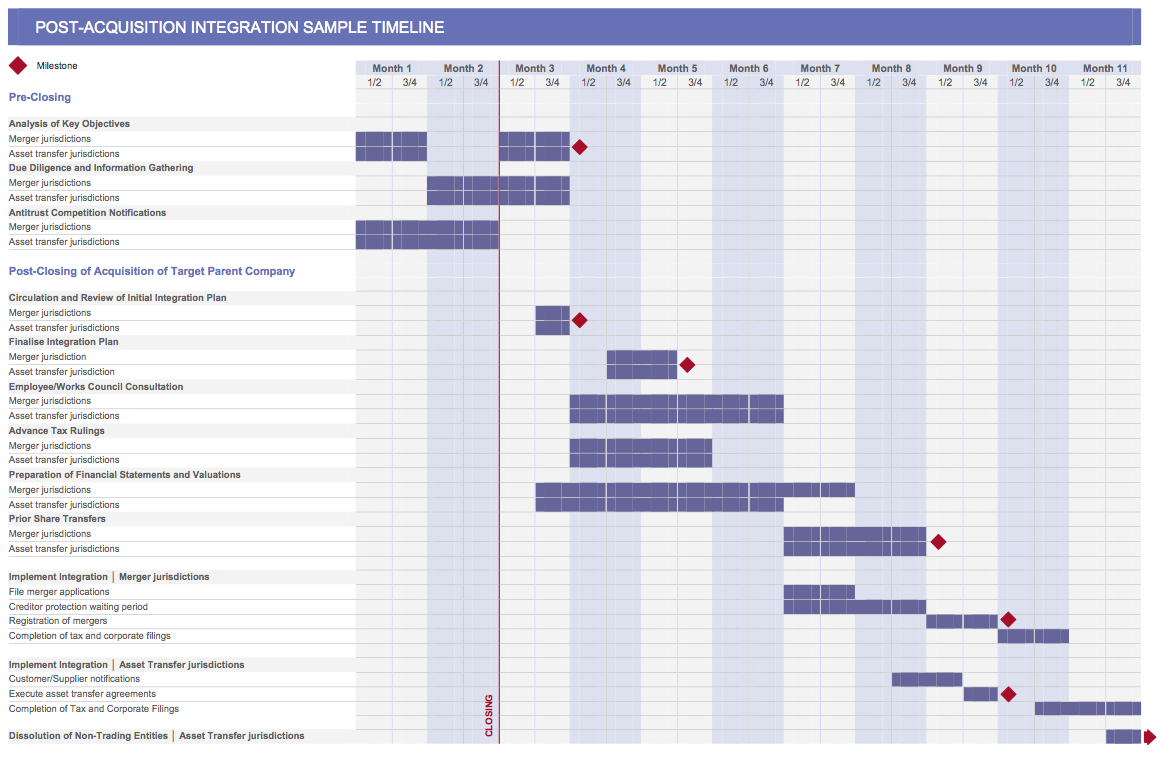
SECTION 6: WORKFORCE RESTRUCTURING
The management of human resource issues is almost always a key element of the integration of a newly acquired business, as the new owners will need to deal with the concerns of both existing and new staff following the acquisition, and resolve the legal and operational issues which arise out of any integration, subsequent restructurings and reductions in workforce. There are many legal considerations which should influence, and be incorporated into, the integration plan, both in respect of what can realistically be achieved and in respect of timing. This is particularly true of many countries outside of the United States. Some desired changes may be legally impossible or create unacceptable risks. Others may be difficult to achieve without careful preparation and an awareness of the industrial relations climate in the relevant jurisdiction.
In addition to the legal issues outlined below, operational matters need to be addressed, such as: how can key individuals be retained in the relevant jurisdictions; how can the different cultures of the acquiring entity and the acquired entity be integrated so as to achieve stability and maintain good morale? Such issues are often critical to the success of post-acquisition integration.
Common post-acquisition measures taken by an acquiring company include merging two or more businesses following an acquisition, downsizing and/or restructuring its workforce and/or harmonizing the terms and conditions of its new and existing staff. Below are some of the key considerations which should be taken into account when considering such measures in the European Union, the Americas, or Asia Pacific.
1. THE EUROPEAN UNION
The European Union has 27 Member States. Ten new members (Cyprus, the Czech Republic, Estonia, Hungary, Latvia, Lithuania, Malta, Poland, Slovakia and Slovenia) joined on 1 May 2004 and two new members (Bulgaria and Romania) joined on 1 January 2007.
1.1 Asset Transfer Plans After Acquisition
Following an acquisition, the purchaser will often wish to integrate, in each local jurisdiction, the new subsidiaries into its existing subsidiaries, or all its subsidiaries into a new company. This can be achieved by way of an asset transfer or, in some jurisdictions, a statutory merger procedure. Any such merger or transfer within the European Union will often trigger the “Acquired Rights Directive” (“ARD”) (or, strictly, the implementing legislation passed by the relevant Member State pursuant to the ARD).Whether or not the ARD applies to a particular consolidation will depend upon the structure of the proposed business transfer and the applicable detailed rules, which can differ between Member States. Where it applies, the ARD will have significant implications for the acquiring company.
1.1.1 Understanding Employee Transfer Regulations
If the ARD applies, all of the employees assigned, immediately before the transfer, to the business (or part of business) being transferred will automatically transfer by operation of law to the transferee entity. Where parts of subsidiaries are being transferred, care needs to be taken to ensure that the correct employees transfer to the correct entities. Difficulties can occur with employees who have responsibilities in relation to more than one business and they should be looked at carefully. In most jurisdictions, the ARD applies only to employees (as defined by each Member State). Consequently, businesses which engage a-typical workers such as direct contractors and agency staff need to consider separately how their transfer will be achieved.
1.1.2 Employees Rights & Liabilities After Transfer
Employees transferring automatically pursuant to the ARD transfer on their existing terms and conditions. All rights and liabilities in respect of their employment also transfer, as do any existing collective agreements. The ARD places strict limitations on the ability to vary terms and conditions to the employees’ detriment following the transfer and, although the extent of the restrictions varies between jurisdictions, these create obstacles to harmonizing terms and conditions. If changes to terms and conditions are crucial, advice should be taken prior to the acquisition and integration to establish the feasibility of making the changes. If the harmonization has the effect of improving terms and conditions overall, it may be that from a practical point of view it can be implemented without provoking objections from employees notwithstanding the strict letter of the law. In other circumstances it may be preferable to delay the merger (potentially by a number of years) and make the relevant changes whilst the companies are separate legal entities. Particular problems can arise in respect of: certain employee benefits which are difficult or impossible to replicate following the transfer, for example, stock options; collective agreements (where the different subsidiaries recognize different unions); and restrictive covenants (which may lose their meaning on transfer).
Most rights under occupational pension schemes do not transfer automatically under the ARD. However, some pension rights do transfer, for example in relation to early retirement benefits. This will depend on the terms of the scheme. Country specific advice should be obtained to address specific pensions issues.
1.1.3 Employee Consultation & Obligations
Before an ARD transfer takes place, both the transferor and the transferee are required to inform, and in some cases consult with, representatives of any of their employees who will be “affected” by the business transfer. This requirement should be built into the planning process and will have a timing impact. Jurisdictions differ as to how long before the transfer the information and consultation process should take place, but if consultation is required, it must be long enough for genuine consultation to occur before the transfer is effected. The appropriate employee representative body will normally be the recognized union(s) or existing works council(s), if any exist. Otherwise, a body may need to be established, generally through an election process, adding further time to the process. If the group has an established European Works Council, there may be a separate requirement to consult with that body. This will depend on the terms of the relevant agreement and the number of countries impacted. In some jurisdictions, a failure to consult can render the transfer void or give rise to a criminal offence, while in others the sanctions are limited to financial penalties and/or compensation for the employees concerned.
1.1.4 Employee Protection Against Dismissal
The employees who are transferred pursuant to the ARD are in a protected category. They cannot be dismissed (either before or after the transfer) solely because the business has been transferred unless the dismissal is for an “economic, technical or organizational” reason which entails a change in the workforce. The way that expression has been interpreted by courts in different Member States varies to some degree, and the relevant local restrictions must be considered before commencing a dismissal process before or after a local integration.
1.2 Workforce Downsizing
If, following the acquisition of the new business, the acquiring company plans to downsize its workforce part of the business, for example, close down a plant, four key employment law issues need to be considered:
- the legal justification for the dismissals;
- the consultation and other procedural requirements (both collective and individual);
- the selection criteria for redundancy which can and should be used; and
- termination payments.
In addition, if the redundancies occur before or after a business transfer which triggers the ARD (as explained above), additional consideration must be given to the dismissal protection provisions of the local ARD legislation (see further above).
1.2.1 Legal Justification for Termination
In some countries a high standard of justification is required in order to carry out dismissals. In others, employers have considerable discretion. Country specific advice should be sought.
1.2.2 Consultation and Procedural Requirements for Collective Redundancies
As a result of the EU Collective Redundancies Directive, each of the Member States has enacted legislation which requires an employer to consult with employee representatives prior to effecting a collective redundancy. As the time periods for the consultation procedures can significantly delay local post-acquisition integrations, it is very important that the scope of any potential downsizing is identified when the key objectives of the integration are considered at the start of the planning process. The extent of the employee representatives’ powers to delay the process varies from country to country.
The requirements are triggered when the number of contemplated redundancies exceeds a specified threshold over a specified time period. The threshold differs between jurisdictions, but can be triggered in some jurisdictions when the number of contemplated redundancies is as low as 2 employees over a period of 30 days.
The matters to be covered in the consultation process will include: the possibility of avoiding collective redundancies or reducing the number of workers affected and of mitigating the consequences, for example by recourse to accompanying social measures aimed at helping redeploy or retraining workers made redundant. The consultation must begin in good time prior to the redundancies taking effect and certain jurisdictions lay down specific time-frames, which can be three months or more depending on numbers of impacted employees. In some countries, this may require negotiation of a social plan. The rules in the specific jurisdiction should be checked. In addition, the employer has an obligation to provide certain information to the employee representatives, such as the numbers and categories of workers involved and the proposed selection criteria. The employer must also notify “the competent public authority”.
Generally, the appropriate body to consult with (as with consultation in respect of ARD business transfers described above) will be the recognized union(s) or the existing works council(s), if there are any in respect of the affected employees. Otherwise, arrangements may need to be made to elect a representative body. If it is anticipated that collective consultation will be required in relation to both an ARD transfer and a collective redundancy, representatives can be elected with a remit to cover both processes in order to avoid duplicative election processes.
In some jurisdictions, a failure to consult can render the redundancies void; in others the sanctions are limited to financial penalties and/or compensation for the employees cornered.
As well as collective consultation requirements, the majority of Member States impose additional procedural requirements on employers making redundancies, even where a single redundancy is being effected. Rules differ significantly and should be taken into account for the relevant jurisdictions. There may also be company-specific contractual requirements which the acquiring company inherits from the seller.
1.2.3 Criteria for Selection
Many Member States have rules about what type of selection criteria an employer may reasonably apply when selecting candidates for redundancy. Some jurisdictions, such as the United Kingdom, give considerable scope to the employer, others are very formulaic and will strictly apply, for example, a “last in, first out” rule. A number of jurisdictions require employers to take social factors into account, such as whether the employee is the sole earner and whether he/she has children or other dependents, or protect certain categories from dismissal, for example Works Council members.
1.2.4 Severance Payments
Most Member States require employers to make severance payments to employees who are dismissed for reason of redundancy. The formulae for calculating the level of payments vary significantly. In addition, most employees will also have the right to a minimum period of notice of termination of their employment, either under their employment contracts or under local legislation. Again, there may also be company-specific contractual severance pay entitlements which the acquiring company inherits from the transferring company.
1.3 Employee Term Harmonization
Following an acquisition, an employer will often wish to harmonize the terms and conditions of its new employees with those of its existing employees, for commercial and efficiency reasons and to integrate the new employees into the established working culture of the acquiring organization. However, employees in EU Member States are afforded significant protection of their contractual rights which limits the extent to which any employer can impose variations to their terms and conditions. Generally, the consent of the employees will be needed to achieve the variation. Otherwise, the employees will frequently have the right to claim breach of contract and/or constructive dismissal/discharge (and enforce the local employment protection legislation against the employer). Strategies for the implementation of such changes should be developed by the employer in the context of the local legislation. Again, forward planning is a crucial part of the process, as such strategies can sometimes involve effecting theoretical collective redundancies (which will trigger the collective consultation requirements described above) and/or giving the employees such notice of the variations as they would be entitled to if their employment was being terminated.
In those jurisdictions where the employer has recognized a union or works council, harmonization may require consultation, or even agreement, with the relevant employee representatives, which can result in protracted negotiations.
The employees’ protection is even greater when the harmonization takes place in connection with a business transfer which triggers the ARD (as explained in paragraph 1.1 above). In some jurisdictions, their terms and conditions simply cannot be changed for the worse, even if the employees give their consent, if the change is related to the business transfer (which it often will be in the context of harmonization). Even if consent is, ostensibly, obtained, in some jurisdictions such as the UK employees may subsequently be able to challenge the variation and insist that the terms that applied immediately before the transfer continue to apply. In other jurisdictions there is a specified period of protection which needs to expire before changes are made. Again, appropriate strategies need to be developed in the context of the relevant local legislation. It may sometimes be advisable for the acquiring company not to merge the relevant businesses, but to retain the entities purchased, thereby preventing the complications which arise from the ARD.
1.4 Workforce Restructuring and Relocation
Restructuring the workforce can involve any or all of the measures described above.
The restructuring of the functions within a business will often be treated as resulting in redundancies under the legislation of Member States. Whilst overall, the number of employees required by an employer may remain the same, or even increase, the fact that the specific job for which an employee was engaged is eliminated will be sufficient to constitute a redundancy. The employer would, therefore, need to follow the relevant redundancy procedures for the relevant jurisdiction (both individual and collective procedures where necessary) referred to above.
Similarly, relocations can constitute redundancies in Member States where the relocation is out of the immediate area of the existing location of employment, triggering the obligations described in 1.2 above. Even where an employer seemingly has a contractual right to relocate, local legislation may place limits on the exercise of that right, to the extent that certain relocations may need consultation or even consent. Again, in jurisdictions where there are recognised unions or established works councils, an employer will often need to consult or agree proposed relocations with the union/works council.
2. THE AMERICAS
United States
In the United States, employment is governed by contract and federal, state and local laws. These laws, along with any contractual obligations (for example, employment contracts/offer letters, severance plans, policies, practices or programs, change in control agreements, etc.) will govern any post-acquisition restructuring, downsizing, and/or harmonization of the terms and conditions of employment for existing employees.
The majority of employees in the United States are employed “at will” and, consequently, changes to the identity of their legal employer (in the case of a post-acquisition merger) can normally be achieved easily through a termination and rehire of those employees. Generally, employers can also unilaterally change the employees’ terms and conditions of employment for purposes of harmonization or otherwise.
Downsizing may also be relatively straightforward, although there are a number of steps employers may need to take to ensure any layoffs are lawfully implemented depending on the number of employees involved, and whether any employees impacted by the layoffs are in a protected category (for example, age, gender, race, religion, sexual orientation (in certain states), etc. all need to be considered). However, some of the key issues which should be considered in each case are described below.
2.1 Dealing with Employee Transfers
In the United States, employees transfer automatically in a merger, unless the merger results in a change of the employer for the impacted employees (as for example in the case of a forward merger).
If the merger results in a change to the employer, then whether employment transfers automatically depends on the application of successor-in-interest rules under applicable state law.
In an asset sale, employees “transfer” through a termination and re-hire (which requires a payout of the employee’s final wages by the Seller, and re-hire by the Buyer on new terms and conditions of employment).
2.2 Transition of Employees – Notice & Consultation
Given that the majority of employees in the United States are employed “at will”, there are generally no statutorily required notice and consultation obligations in connection with a change in their legal employer, harmonization of terms and conditions of employment, and/or downsizing (or otherwise). The exceptions being if WARN (see below) is triggered or if contractually required (for example, collective bargaining agreement for union employees, etc.).
2.3 Employee Downsizing and Restructuring
As noted above, in the United States, because employment is presumed to be “at will” the termination process generally does not require notice, consultation or severance payments, unless WARN (see below) is triggered or if contractually required (for example, collective bargaining agreement for union employees, severance plans, policies, programs or practices, change in control agreements, etc.).
2.3.1 WARN and other Notice Requirements
The federal Worker Adjustment and Retraining Notification Act (WARN) requires employers to provide advance notice if they employ 100 or more people and intend to dismiss at least 50 employees (or 1/3 of its US workforce if greater), which may include employees working overseas. Federal WARN does not apply in the sale of business. Some states also have similar laws, but the thresholds are often lower and there may not be the same exceptions as under federal WARN.
As well as applying to downsizing situations, WARN can apply in other restructuring scenarios. For example, if the relevant thresholds are met, a reduction in individual employees’ work hours of more than 50% during each month of any six-month period can fall within its scope.
There are other notification requirements which may arise under state or federal law in the event of dismissal, such as the obligation to notify employees of their rights to obtain unemployment insurance benefits or to purchase health insurance under COBRA.
2.3.2 Employees’ Contractual Rights
Although the majority of employees in the United States are employed “at will”, some employees will have certain contractual rights. Those contractual rights need to be considered in the context of the proposed integration process. Some employees (particularly officers) will have contracts of employment which give them the right to a specified period of notice and/or a severance payment in the event of a termination, including “transfer” occurring through a termination and re-hire. The contract may also contain a change of control clause requiring payments to be made in the event of an acquisition or restructuring.
If the employer has a collective bargaining agreement with any trade union relating to the affected employees, the collective agreement is likely to impact on any proposed restructuring. Collective agreements may also include provisions governing redundancy selection criteria, notice and severance. In addition, if its workforce is unionized, the employer should ensure that its actions are consistent with the National Labor Relations Act.
2.4 Harmonization of Terms and Conditions
Since employees in the United States are generally employed “at will”, employers may impose new terms and conditions on employees, provided that they do not do so in violation of any applicable federal, state, or local laws (for example, governing discrimination or harassment, wages or working hours, etc.).
Canada
In Canada employers are governed either by federal or provincial employment law, depending on the nature of their business. Below is a discussion of the main issues which should be considered in the context of a post-acquisition integration process in Canada, but the specific rules may differ. Broadly speaking, Canadian employment legislation can be seen as a hybrid of the European Union and US approaches.
2.5 Dealing with Employee Transfers
Like the US, Canadian law (other than Quebec) does not provide for the automatic transfer of employees upon the transfer of a business and the transfer of employees is achieved by way of termination and re-engagement. Unlike the US, however, all employees have the right to notice of termination and the employer must give the appropriate notice or make a payment in lieu of notice if the employee will not agree to the new terms. Where the employees do accept the transfer, Provincial laws generally provide that continuity of employment is transferred in relation to certain statutory rights, such as vacation, maternity leave and severance pay. Quebec does provide for the automatic transfer of employees where there is a transfer of a distinct business or enterprise.
The position is different in respect of unionized businesses, where in all Provinces the terms of any collective agreement will bind an acquiring company on the transfer of all or part of a business. The union will also retain its bargaining rights and the acquiring company cannot vary the terms of employment without the union’s consent.
2.6 Transition of Employees – Notice & Consultation
There is no statutory obligation to notify or consult with employees or their unions about the transfer of a business. The relevant employment contracts and collective agreements should be checked for contractual requirements.
2.7 Employee Downsizing and Restructuring
The laws relating to downsizing in Canada are similar to the laws in the EU, although less burdensome. Employers are required to notify employees in advance and, in some Provinces, to notify state authorities. There may also be consultation requirements in applicable collective agreements. As with the US, the employer should use valid and objective selection criteria in order to avoid suggestions of discrimination. There are also certain protected classes of employee who cannot be dismissed, such as those on maternity leave, or are the subject of a garnishee order. As well as the right to notice (or pay in lieu), employees have the right in certain Provinces to a severance payment if they are dismissed without cause.
2.8 Employee Term Harmonization
Since employees in Canada are not employed “at will”, employers are unable to impose new terms and conditions on employees without risking a claim by employees that they have been constructively dismissed (creating liability for termination/severance payments as described above). Strategies for the implementation of any changes to the terms and conditions of employment of affected employees should therefore be developed in advance of such changes.
Latin America
2.9 Dealing with Employee Transfers
In most Latin American jurisdictions, employees transfer automatically in a merger. This is the case, for instance, in Argentina, Brazil, Chile, Colombia and Venezuela (though in Venezuela the employees have the right to object to the transfer if they consider it harmful to their interests). Typically, employees receive a merger notification letter or employer substitution notice to confirm their transfer to the surviving entity. Notices in some cases must also be given to several other persons or entities (for example, the competent Labor Office, the Social Security Administration, etc.). In Mexico, the transfer of employees will depend on the specifics of the merger.
In an asset sale, how employees transfer depends on the jurisdiction where the employee is located. Generally speaking, in most Latin American jurisdictions, in an asset sale, employees transfer either through employer substitution or (where permissible) termination and rehire. In Mexico, for instance, the employer can transfer employees through employer substitution (which would require terms and conditions of employment to remain unchanged) or through termination and rehire (which would require a payout of any employee rights in connection with the termination, but would permit engagement on new terms and conditions of employment). Similar rules apply in Brazil, where employees can be transferred in an asset deal if the assets sold encompass a business. All terms and conditions of employment must be maintained. Benefits can change but the economic value must be maintained. Likewise, in Chile, the employees will transfer automatically without the consent of the employees, the labor authority, the union or any other institution.
In Argentina, employees can transfer in an asset sale only with employee consent. No consent is required for the transfer of employees in a share sale, but harmonization of salaries and other compensation is required. This cannot be achieved by terminating employees and rehiring them the next day, as this may be viewed as a fraudulent maneuver. The employer must therefore either increase levels of salaries/compensation or dismiss the employees and hire unrelated new employees. In either case, there is no need for consultation with unions and/or works councils, and no need to serve prior notice on employees to be transferred.
2.10 Transition of Employees – Notice & Consultation
In most Latin American jurisdictions, corporate restructuring does not trigger any statutory notice or consultation obligations (unless the restructuring involves downsizing or reduction of existing benefits or conditions, or employees are transferred, in which case certain notice and/or consultation requirements apply). That said, in various Latin American jurisdictions, while there is generally no concept of works councils like in the EU, employers are often subject to industry-wide or regional labor unions, and the post-acquisition integration may trigger notification or consultation obligations with the unions. For instance, in Brazil, all employees are represented by a labor union, and applicable collective agreements should be reviewed for any obligations triggered in this regard. For instance, labor union fees have to be paid to the appropriate labor union, and various benefits are set out in collective agreements, so it is important to confirm the applicable collective agreements, and their impact on the post-acquisition integration.
2.11 Employee Downsizing and Restructuring
Like in the EU, any downsizing in connection with a post-acquisition integration needs to address the following three key employment law issues:
- consultation and other procedural requirements, restrictions and prohibitions;
- selection criteria; and
- termination payments.
As to consultation procedures and procedural requirements, applicable collective bargaining agreements should be reviewed for any union consultation requirements. Also, in some jurisdictions, termination agreements or releases need to be signed off before the labor authorities or unions (for example, in Argentina, Brazil or Mexico). In certain countries, collective or mass dismissals are prohibited or may be stopped by the labor authorities (for example, Venezuela), and thus amicable negotiations with the unions or employees may be necessary to implement the personnel reduction. In addition, certain employees are protected against dismissal, in which case amicable negotiations for the employees to voluntarily resign from employment may also be required. In Chile, this protection extends to pregnant women, certain union officials, and employees on sick leave.
In the Latin American jurisdictions, mandatory selection criteria are less widespread than in the EU jurisdictions, and instead, any objective criteria can be used. That said, various Latin American jurisdictions protect certain types of employees from termination. For instance, in Colombia, there are termination protections related to union membership, collective dismissal, disability, illness and maternity. In Brazil, pregnant women, union representatives, employees on sick leave, etc. all enjoy job stability. In Argentina, pregnant women or mothers, as well as recently married employees, among others, may be entitled to special severance indemnities. As indicated above, in these cases amicable exit negotiations are recommended.
As to termination payments, in most Latin American jurisdictions terminations due to redundancy are treated as “without cause” terminations, triggering often generous notice and severance requirements. For instance, Mexican employees terminated due to redundancy are entitled to: (i) 3 months’ salary; (ii) 20 days’ salary per year of service; and (iii) a seniority premium of 12 days’ salary (capped at twice the minimum wage) per year of service. Brazilian employees terminated without cause are entitled to 50% of the funds in their severance fund account (the FGTS), plus a supplemental FGTS payment, amongst other entitlements. In Chile, terminations due to a company’s restructuring or downsizing are treated as dismissals by reason of “company needs”. In these cases, the employer must make a statutory severance payment (broadly, 1 month per year of service capped at 12 months’ pay or CLF90 (approximately US$5,000)) and either provide the employee with 30 days’ notice of termination, or make a payment in lieu of notice.
Finally, if the company does not anticipate making employees redundant, but instead wants to otherwise restructure its workforce (for example, through change in reporting structures or relocations), it carefully needs to analyze whether such proposed restructuring measures constitute changes to terms and conditions of employment that may not be permissible, or can be deemed as tantamount to a redundancy, thus triggering the related redundancy obligations.
2.12 Employee Term Harmonization
Harmonization of terms and conditions of employment can be a challenging topic in many of the Latin American jurisdictions, due to two conflicting concepts: (i) the requirement to transfer employees on the same terms and conditions of employment, at least if employees transfer automatically or through employer substitution in connection with a merger or in an asset sale; and (ii) the equal pay principle, requiring equal pay for work of equal value.
As to the former, in many Latin American jurisdictions, terms and conditions of employment cannot be changed to the detriment of the employee, even if the employee’s consent is obtained. This is the case, for instance, in Argentina, Brazil and, in some circumstances, Mexico. In Chile, any change to the contract can be made with the written consent of the employee. Sometimes (for example in Chile), it may be possible to circumvent this requirement by transferring employees through termination and rehire (on new terms), or by paying out partial severance (for example, in exchange for a salary reduction). In Colombia, parties to the employment contract are free to agree different terms of compensation provided that legal minimums are respected.
As to the latter, many Latin American jurisdictions have equal pay for work of equal value requirements. What this can mean in connection with a post-acquisition integration is that, if one group of employees has beneficial terms, and (since detrimental changes cannot be made to employees’ terms and conditions) all employees have to be provided with the better terms. The simple fact that some employees may have been acquired through a transaction typically does not constitute sufficient grounds for unequal pay. In Colombia, the employer will have to amend employment contracts by mutual consent and structure payments to raise some benefits and lower others in order to comply with the principle of equal pay for work of equal value.
However, there may be exceptions to the above principles, and a case by case review of these issues is, as in all the aspects referred to, advisable. For example, in Venezuela, labor court rulings have allowed certain changes of existing conditions to the detriment of the employee (provided applicable minimum mandatory benefits and standards are met), if the changes are justified on the grounds of a force majeure or a supervening event such as a merger.
Any benefits harmonization in Latin American jurisdictions needs to be carefully planned and implemented, and strategies developed to mitigate risk, all to be analyzed and determined on a case by case basis.
3. ASIA PACIFIC
3.1 Dealing with Employee Transfers
The position will depend on the jurisdiction of the employer. However, as a general rule, and unlike the countries in the European Union, there is no concept of “transfer” of employment in most Asia Pacific countries, even when the old and new employers are within the same group, or when the employees are meant to be transferred as a part of a larger transaction such as the sale of a particular business. There are limited exceptions, such as under Singapore law, but the exceptions will not apply in every case.
Unless one of the limited circumstances of automatic transfer applies, an employer may not force an employee to change employers and transfer is achieved through termination and rehire. In some jurisdictions, such as Hong Kong, there are statutory procedures in place to help employers avoid making certain termination payments to employees who agree to transfer to the new owner.
However, as there are strict restrictions on termination in some jurisdictions (such as Korea, Japan and Indonesia), many employers adopt a “resign and rehire” approach. This avoids having to justify the dismissals or risk later disputes.
3.2 Transition of Employees – Notice & Consultation
It is possible to dismiss by giving notice or making payment in lieu in almost every jurisdiction in Asia save for the Philippines (where payment in lieu of notice is not allowed) and Indonesia (where there are strict procedures that preclude termination by notice or payment in lieu in most cases). In other jurisdictions, such as China, Korea and Japan, termination by notice is permissible but is subject to general requirements that the dismissal be justifiable in accordance with the relevant laws and procedures.
In jurisdictions where termination on notice is allowed, the minimum notice period is usually one month, but can vary from one day to eight weeks. In some jurisdictions, such as Australia, India, Malaysia and Singapore, the legislation applies only to specified categories of staff and the rights of senior employees are governed by the relevant contract of employment. In Vietnam, senior staff are entitled to “reasonable” notice which can depend on age, rank, industry practice and years of service.
It is not generally necessary to consult with employees prior to termination, but certain countries require local labor authorities to be notified if more than a certain number of employees will be made redundant. In some countries, unions and/or employee representatives must be notified or consulted prior to termination.
The level of unionization varies across Asia. Unions are much stronger in Indonesia and Korea than they are in Hong Kong and Singapore, for example. In all countries, if there is any collective bargaining agreement in place and that agreement requires union consultation before termination, the requirement will be upheld.
3.3 Employee Downsizing and Restructuring
The rights of employees who are laid off or made redundant vary significantly across Asia. Given the disparity in legal systems and employee rights among Asia Pacific jurisdictions, reducing one’s workforce can be a significant task that should not be approached lightly. For example, unlike the US, where the termination process is straightforward and “employment at will” allows employers to downsize without incurring significant costs, labor laws and market practice in many Asian countries require employers to make significant payments and/or comply with strict procedural requirements when carrying out terminations.
In countries such as Korea and Japan, layoffs can be extremely problematic and employers may be required to prove “just cause” for the termination or make large payouts. In China, downsizing must meet statutory requirements to be justifiable. Restructuring in other countries such as Hong Kong and Singapore is relatively straightforward in comparison.
In almost every Asian jurisdiction, employees will be entitled to the following: notice or payment in lieu, accrued but unpaid wages, and annual leave and expenses incurred on behalf of the employer. Some jurisdictions also require a pro-rata payment of any contractual bonus. Entitlement to, and the amount of, any severance payment will vary depending on the jurisdiction, employee’s length of service, terms of employment, and, in China, the type of legal entity of the employer (such as a Foreign Investment Enterprise or Representative Office).
Employers in many countries prefer to adopt the “voluntary redundancy” approach, meaning the employer solicits resignations from employees. This method of downsizing is particularly recommended in those jurisdictions where it is otherwise very difficult to terminate employees, including China, Indonesia, Japan and Korea, or where termination procedures are particularly cumbersome, such as India. Employers who are conducting a multi-jurisdictional exercise may therefore wish to adopt this approach throughout the region though care should be taken to ensure the method of soliciting the resignations does not, in itself, lead to further liabilities.
3.4 Employee Term Harmonization
As in the EU and elsewhere, a new owner will generally wish to rationalize the terms and conditions of the “old” and the “new” employees as soon as possible. While in most Asian countries there is no legislation which protects employees’ terms and conditions automatically as there is in the EU, the real issue in Asia is that this will constitute a variation of the contract for the employees affected. In most jurisdictions in Asia Pacific, this will require the employee’s consent. If the employee does not consent and the employer implements a salary cut, the employees can claim damages for breach of contract. They will, at minimum, be entitled to the difference between their old salary and the new. In some jurisdictions, such as Hong Kong, the employees can claim that they have been constructively dismissed. In this case, the employer may be liable for other termination payments, such as long service payment or a termination payment for dismissal without a valid reason.
SUMMARY OF ISSUES ON EMPLOYMENT TRANSFER
This summary is based on the following assumptions:
(1) Each company is a 100% subsidiary of the same parent company or each other (subject to any mandatory minority interests).
(2) The surviving company of the integration will be one of the original operating companies, not a newly incorporated company.
Alternative methods are available in many jurisdictions and situation specific circumstances may exist. This summary should not be relied on instead of obtaining specific legal advice.
1. AMERICAS
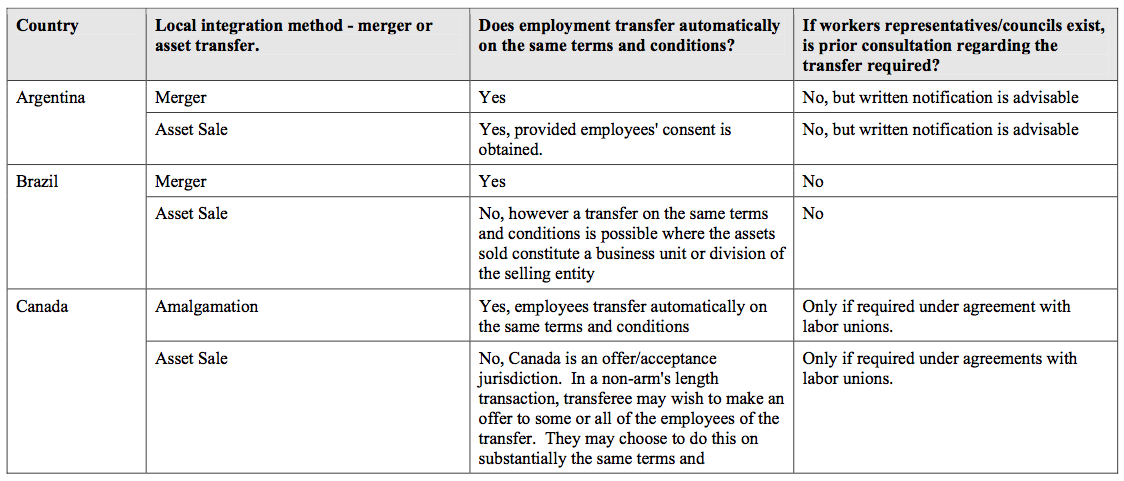
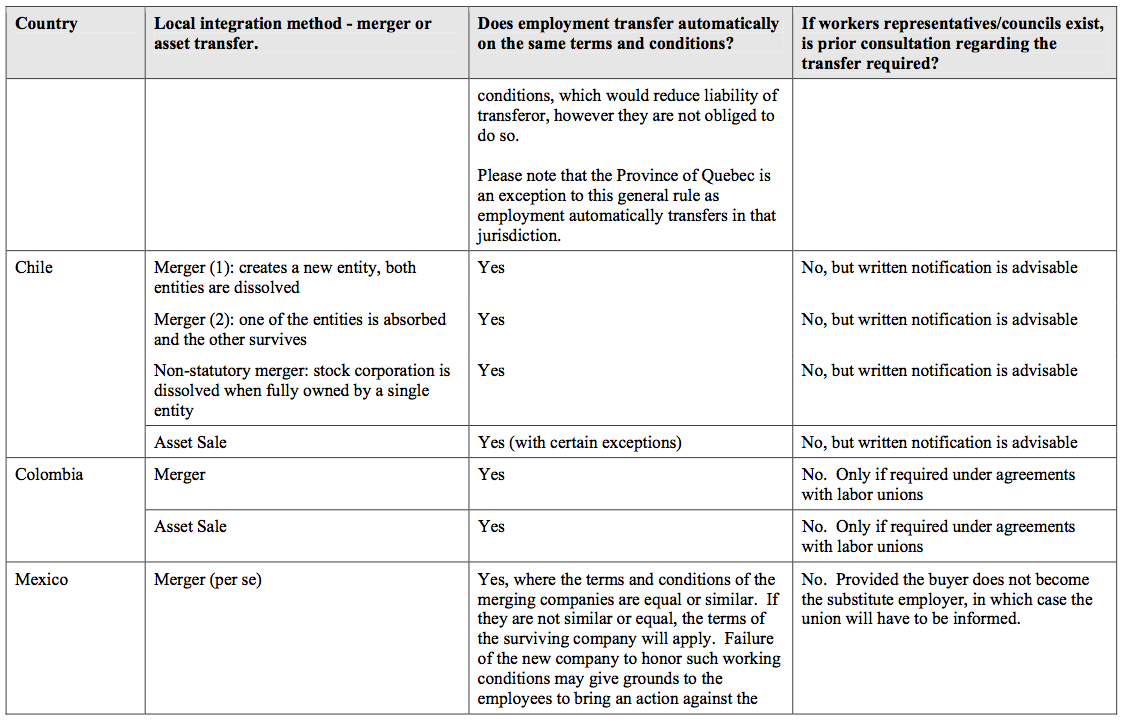


2. ASIA PACIFIC REGION
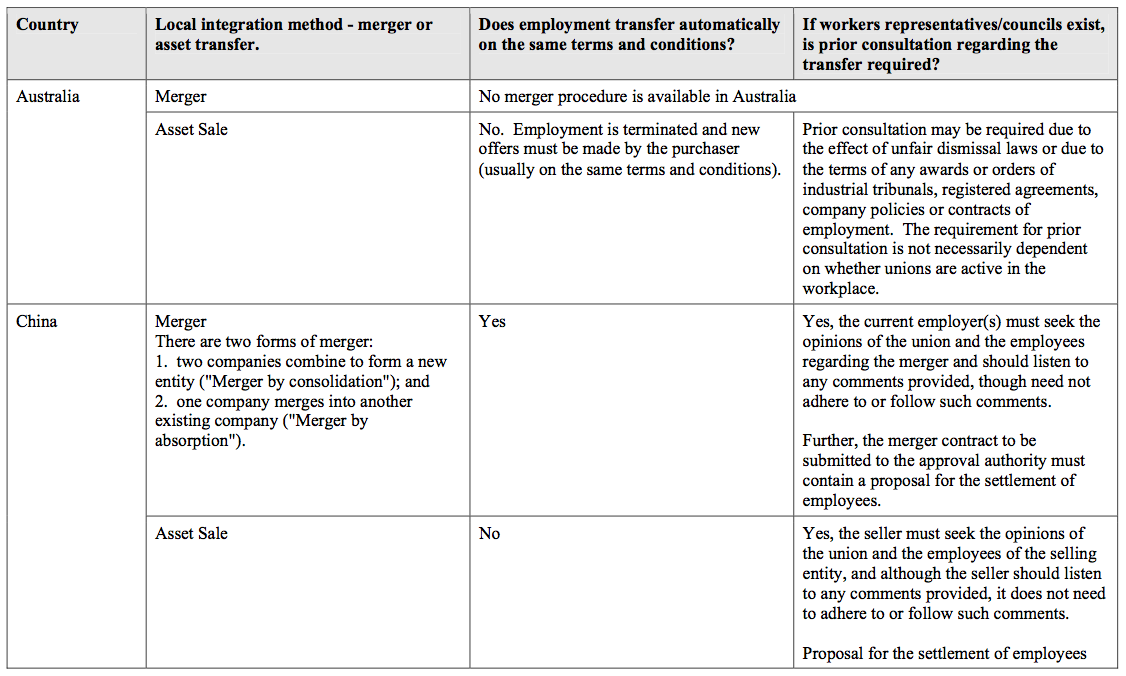
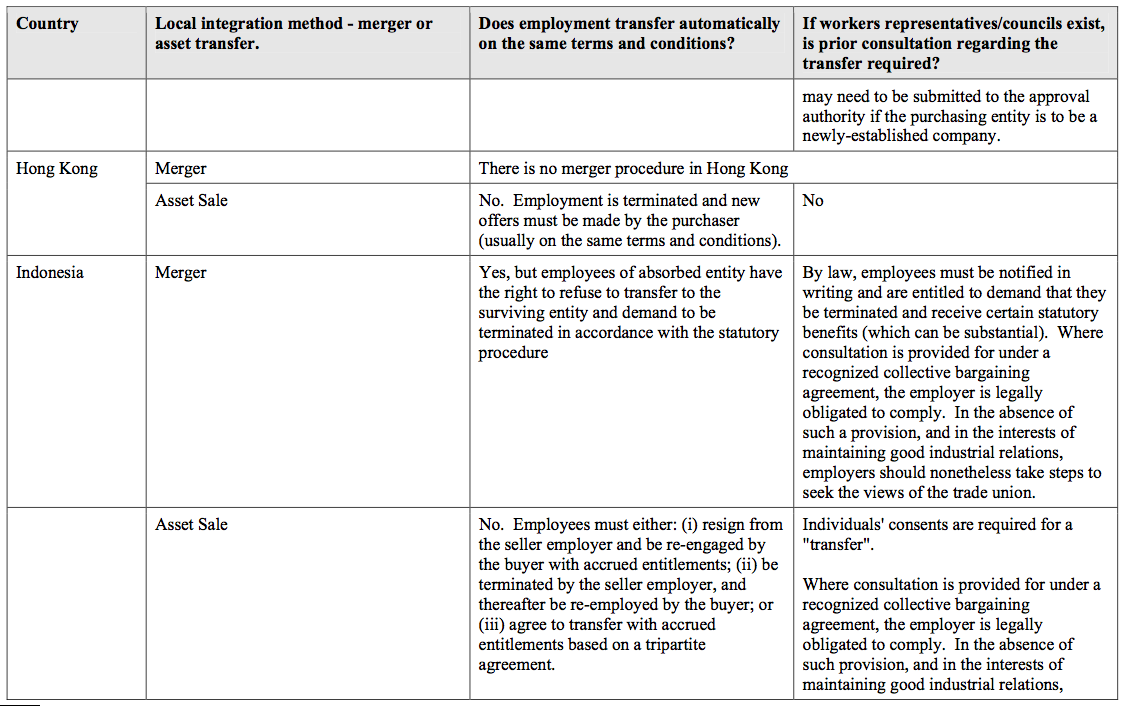
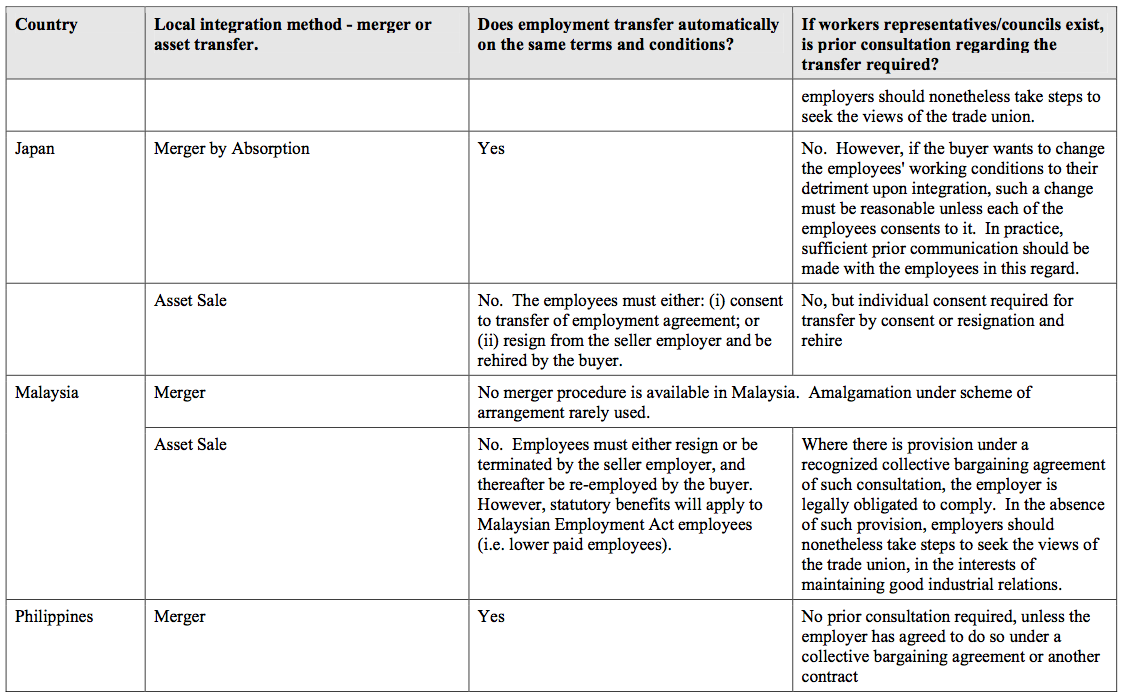
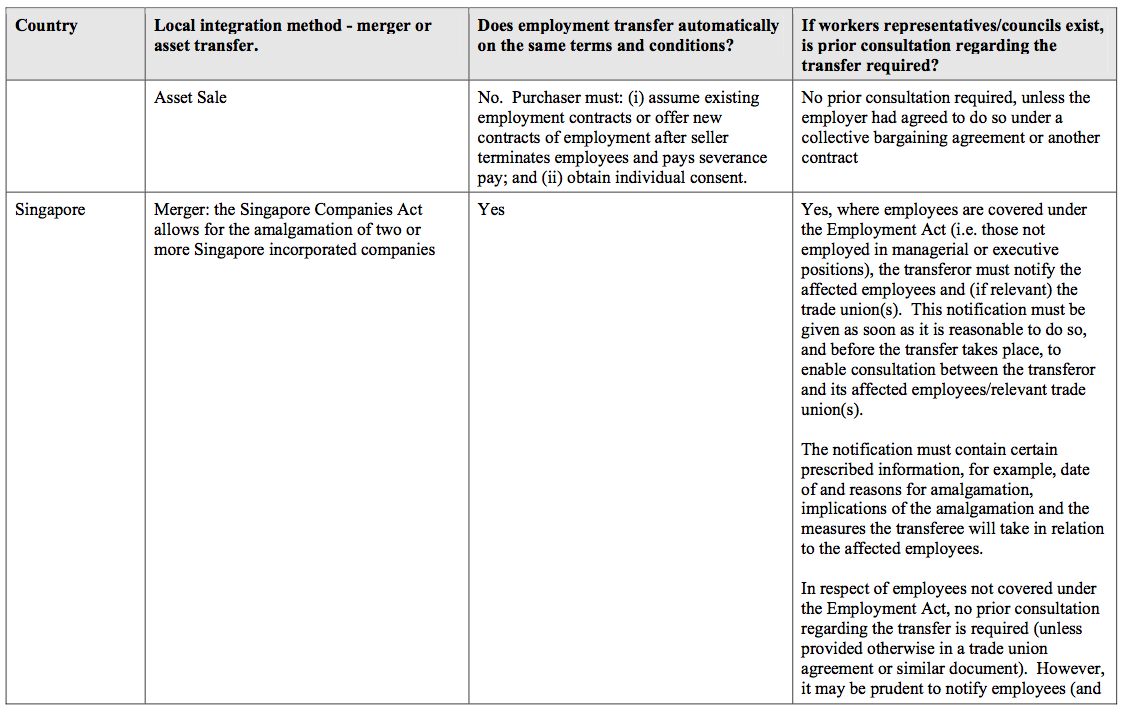
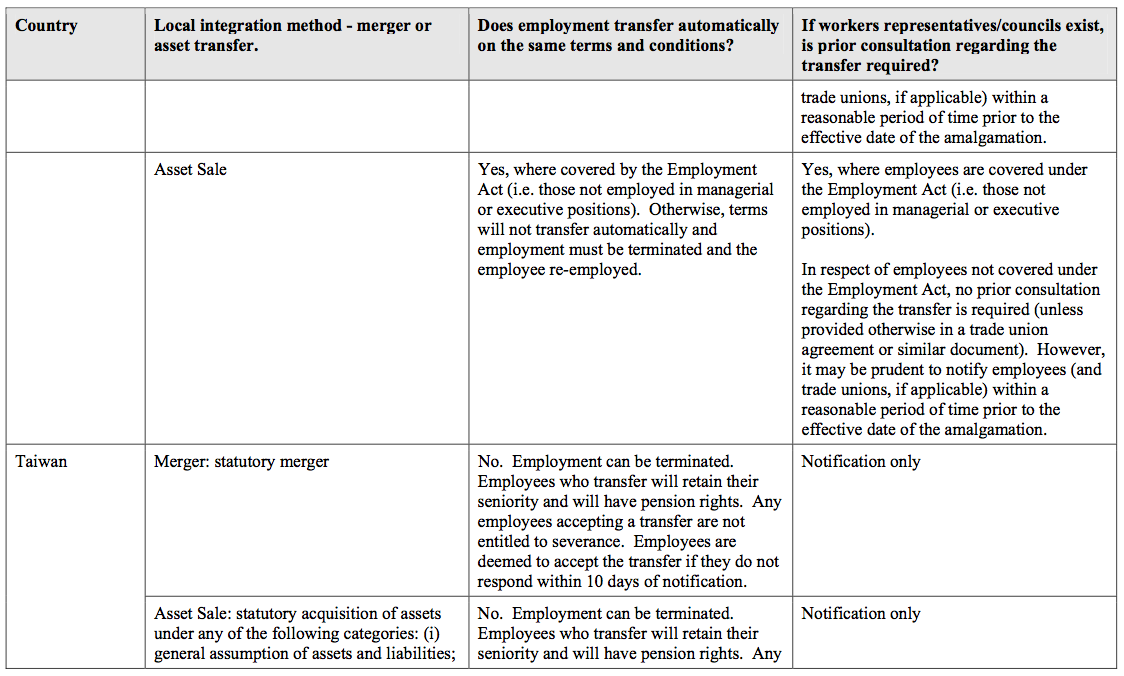
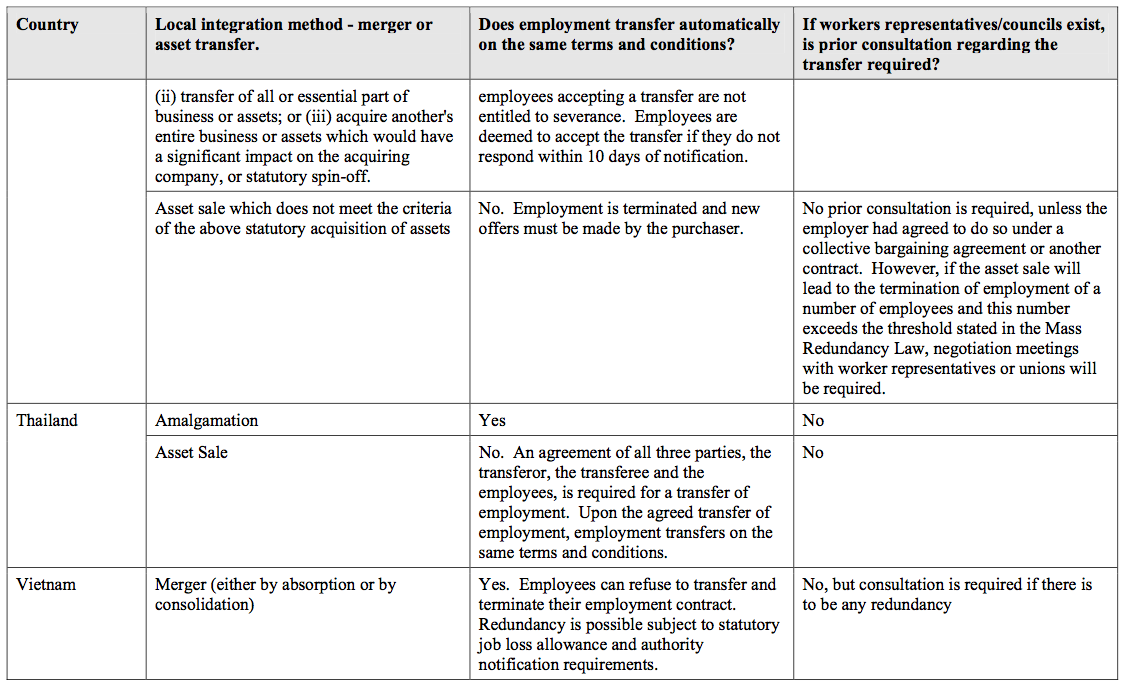

3. EUROPE, MIDDLE EAST AND AFRICA

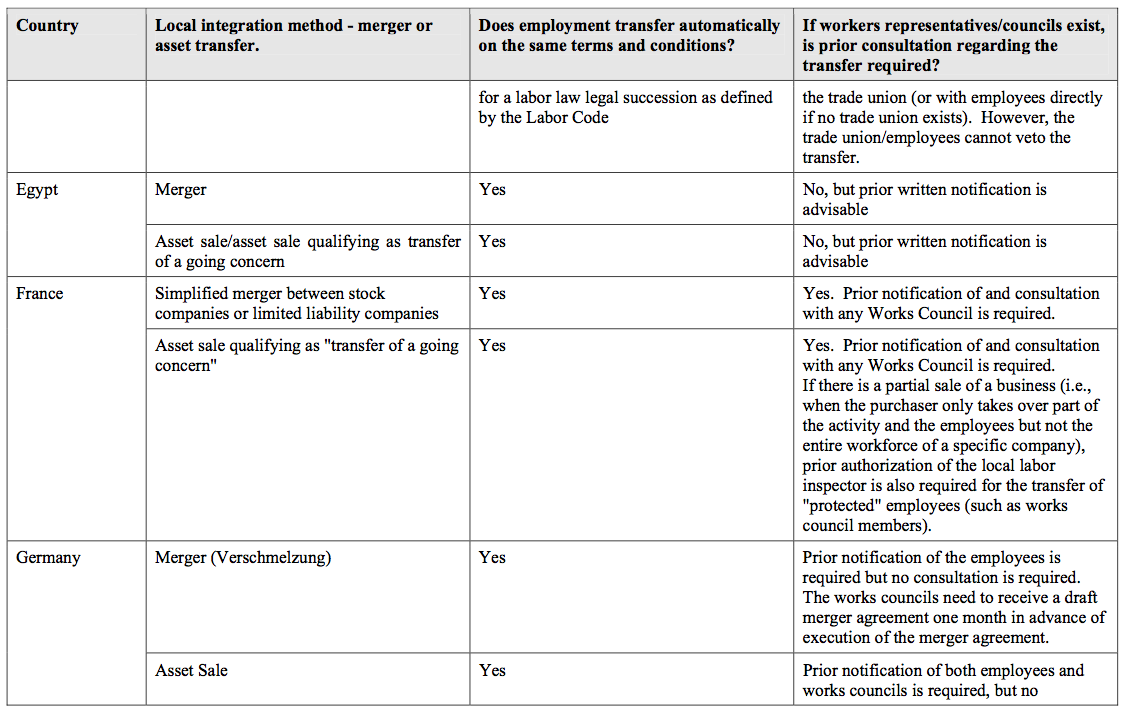
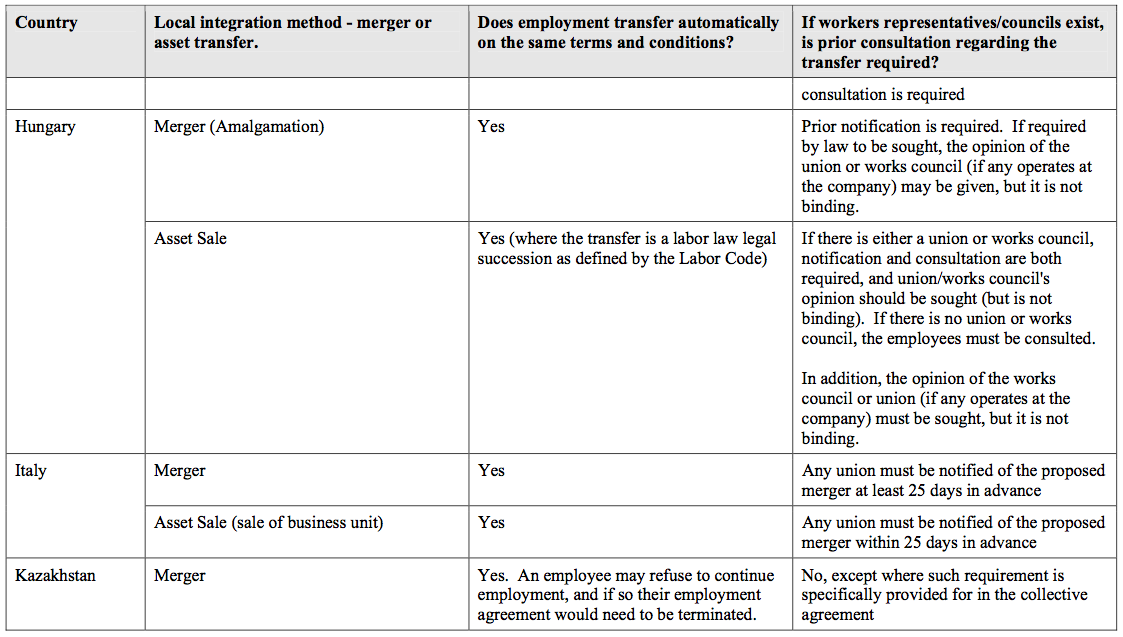
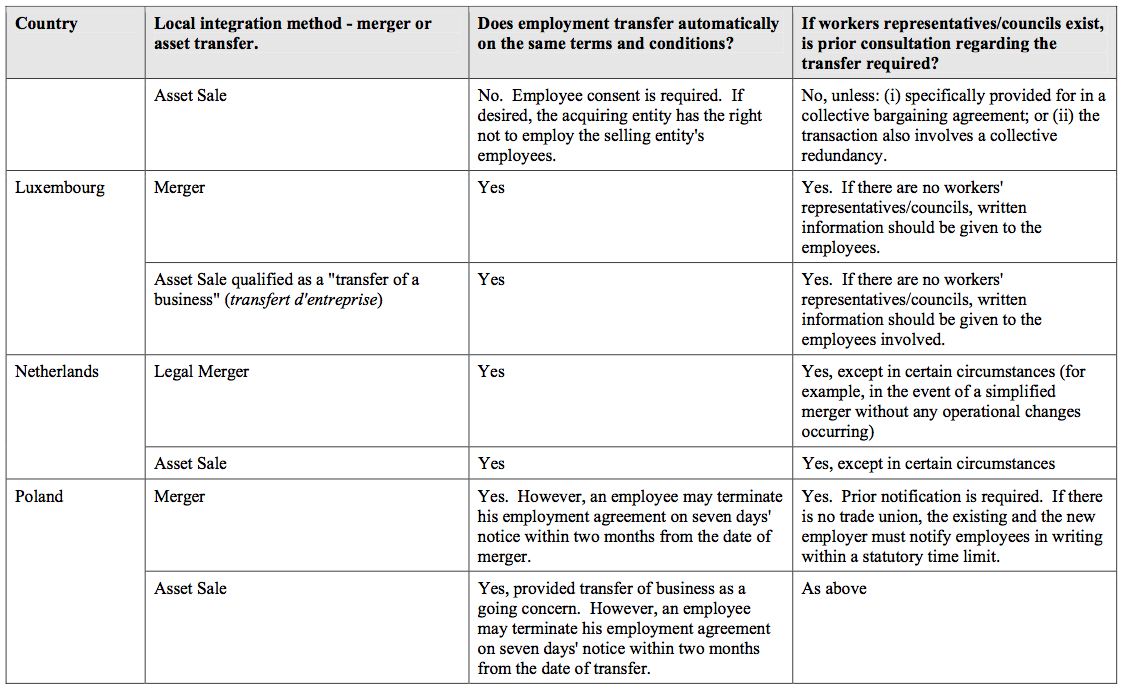
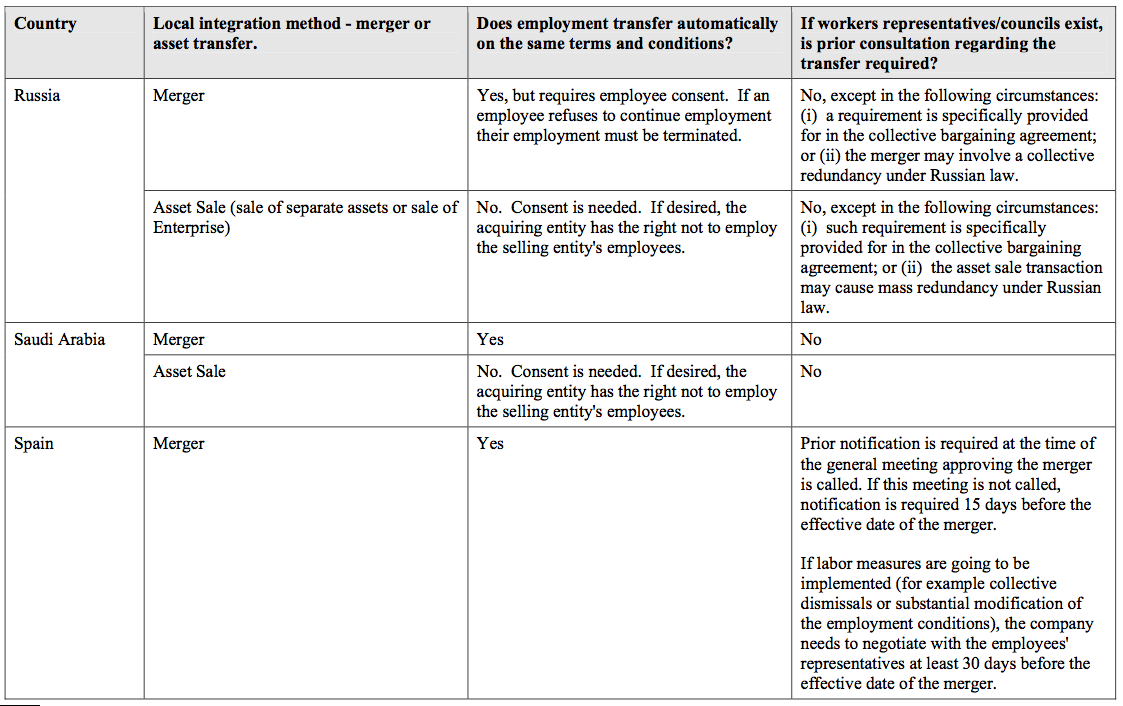
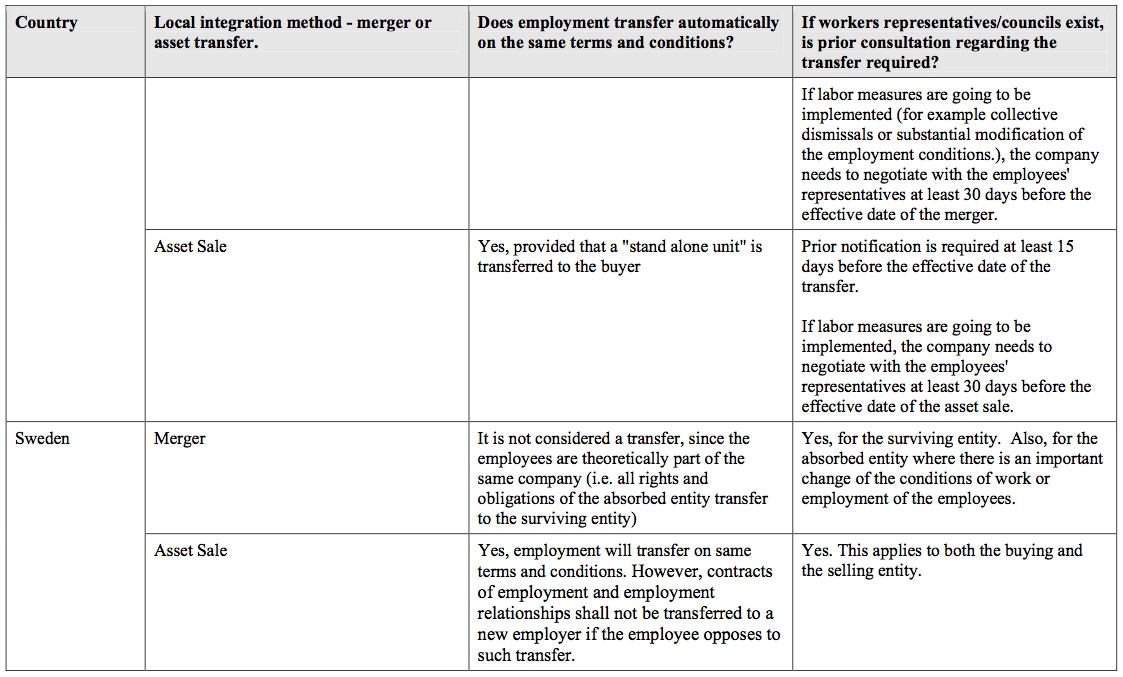


SECTION 7: WELFARE & RETIREMENT BENEFITS OF EMPLOYEES
The term “employee benefits” covers a wide range of benefits which may be provided to employees, such as retirement benefits, cash bonuses, car entitlements, beneficial loans and healthcare. In certain countries, particularly the United States, retirement benefits and other so called welfare plans (for example, medical, dental, disability insurance, life insurance, etc.) are generally provided by the employer rather than the State. In jurisdictions where the employer has the primary responsibility for providing employee benefits, due diligence and financial analysis is essential to determine the impact of the transaction on liabilities, costs and cash flow as well as the effect on employee morale. This section focuses on those benefits that are most directly affected by an acquisition and subsequent integration, i.e., retirement and welfare benefits. In addition, this section discusses the impact of an acquisition and subsequent integration on outstanding employee equity awards (for example, employee stock options). A detailed analysis of the employee benefits and employee equity award issues to be considered in the planning and due diligence stages of the acquisition is outside the scope of this Handbook.
1. Employee Equity Awards
Equity awards held by employees are usually over shares in the parent company, and so will be directly affected by an acquisition of that company. To the extent that awards will remain outstanding after the acquisition, these rights will need to be altered in some way to reflect the resulting change in ownership. Awards that could be affected include employee stock options, restricted shares, restricted stock units, and any other share-based awards (even if ultimately settled in cash).
The impact of the acquisition on equity awards should be considered in the structuring and planning leading up to the acquisition, as briefly commented on below. Following the acquisition, further work to ensure compliance with all applicable laws and, to the extent deemed necessary, to integrate these awards with the acquiring group’s equity plans is required.
1.1 Planning and Due Diligence
Although equity awards should be one of the aspects considered in the structuring of an acquisition, such awards are rarely a central focus even though they can have a significant impact on the transaction, if they are widely held by employees of the target group.
As a starting point, the terms on which the awards were granted and the rules of the equity plan should be considered as these may contain provisions dealing with a change of control of the company over whose shares the awards were granted. For example, many US equity plans provide for the assumption/conversion of awards on a change in control into awards over shares of the acquiring company. However, in the UK, a typical plan may provide for the exercise of vested options or vesting of shares prior to the acquisition being completed, with any awards that remain outstanding then lapsing following completion. A UK “approved” plan may permit the exchange of options on an approved basis, provided certain requirements and processes are complied with.
If any awards will remain outstanding following the acquisition, the acquiring company will need to have a process in place for administering these awards, especially if the terms of the awards are different from the acquiring company’s regular equity awards. In addition, the company will need to ensure that any necessary tax and/or compliance filings are made for the awards in all relevant jurisdictions, given that any assumed/converted awards will be considered as “new” awards in many countries. This can be an issue especially if awards are held by employees residing in countries that are new to the acquiring company.
1.2 Post-Acquisition Steps
As discussed above, consideration should have been given to the treatment of equity awards prior to the acquisition taking place and various actions should already have been taken, such as the making of any necessary regulatory filings, and possibly the obtaining of consents. On this basis, the post- acquisition steps outlined below are mostly aimed at supporting the pre-acquisition work which may already have been completed in affected jurisdictions.
This list of post-acquisition steps is a general guide to the main issues which may need to be considered, and the focus and relevance in any particular integration depends on whether and the extent to which these issues were considered prior to completion of the acquisition.
- if existing awards were converted on completion into awards over the acquiring company’s shares, the company will need to communicate with the employees (to the extent this has not already been done) and information regarding the details of the converted awards (for example, new exercise price, number of shares subject to the award) will need to be provided to the new employees.
- if the awards are not converted, there may be a general employment obligation on the employer to provide benefits of similar value. This would involve considering whether the plans already operated by the acquiring company are sufficient for this purpose, and possibly setting up new plans for this purpose.
- a thorough review (to the extent not already done) should be undertaken of all equity- based plans operated by the new group, including local variations and standalone plans. It will be necessary to ascertain whether the documentation being used is sufficiently comprehensive to comply with the requirements of the various jurisdictions in which the plans operate (by reference to securities, tax, employment, exchange control and data protection laws) and amend where appropriate. In addition, the number of shares authorized under each equity plan should be re-evaluated in light of increased employee numbers.
- an understanding of how the acquired company structured its equity awards to accommodate local laws will be important. If the structuring differs from the acquiring company, two different procedures for complying with local rules may be necessary.
- in addition to regulatory filings which may have been needed before the acquisition, further filings may be needed following completion. The availability of local exemptions should also be reviewed as the change in corporate structure and size of the local entities may impact this.
- the actions required for compliance with legal requirements worldwide, such as securities laws, data protection, taxation, exchange control and employment laws, should be ascertained. This should include a summary of any available exemptions or “safe harbor” provisions under securities laws, and the conditions which need to be satisfied in order to qualify for them, the various filing and reporting requirements which are needed on an ongoing basis and the entity responsible for each. The company should ensure that sufficient procedures are in place to monitor and maintain compliance and undertake necessary reporting and filings on a timely basis.
- if the awards were structured to be tax beneficial, consider whether anything can be done at this stage to retain the necessary approvals etc. It should also be considered whether the time, costs and effort involved in maintaining such approvals is worthwhile and also whether this is consistent with how the company decides to structure its equity plans going forward. If the tax-favoured treatment will be lost upon the close of the acquisition, then employees should be informed so they can act prior to the completion of the transaction.
- the extent to which the equity awards are administered globally or locally should be determined. The company may also wish to consider whether the extent and complexities of the equity plans means that the administration may need to be outsourced to a third party provider, or whether additional people should be given this responsibility internally.
- sufficient communication procedures need to be established between the various entities and functions, such as the stock plan administrators, HR and payroll, to ensure that the appropriate people are aware of the equity plans and activity within them. For example, to ensure that on an option exercise, the appropriate taxes are withheld within the appropriate timeframes, where necessary.
The discussion above focuses on equity awards such as employee stock options or restricted stock units; a similar review must be conducted for employee stock purchase plans. For example, US companies offering a global employee stock purchase plan (“ESPP”) will need to consider how to integrate employees of the acquired group into the ESPP including, if necessary, completing corporate formalities to bring new subsidiaries into the plan. Terminating an acquired company’s ESPP may raise securities or labor law issues.
In addition, a change in structure of the group may be an opportune time to reconsider the nature of equity awards offered by the company, subject to any restraints which may be imposed by employment laws.
The company may wish to have a “global” equity plan which is integrated across the group worldwide or it may prefer that awards are structured at a more regional level, according to what is appropriate for that section of employees. The extent to which regional variations are to be permitted or indeed encouraged should be considered: this may depend, for example, on whether the company wishes to amend plans to obtain tax relief or to avoid unnecessary regulatory filings. In the UK, share option plans can be amended by way of a sub-plan for approval by the local tax authorities so that options can be granted in a tax beneficial manner.
Further, changes in tax or accounting rules might lead to the nature of the awards being provided as remuneration being reconsidered. Generally, companies seek to incentivize or reward staff by a combination of cash (by way of bonuses) and share based plans. Share based plans are much more common in the case of companies whose stock is listed on a stock exchange, due to the lack of marketability of shares in private companies. Nonetheless, many private companies have established equity plans and often permit senior managers to acquire shares directly.
Finally, it should be noted that restricted shares have tax disadvantages in some countries, because employees may be taxed when they first receive the shares and may be unable to claim the tax back if they forfeit the shares before they vest. As a result, some companies grant restricted stock units or “RSUs”. RSUs involve a promise to transfer shares to the employee in the future if the employee remains employed during the vesting period of the award and generally do not carry voting or dividend rights. RSUs are usually taxed only if and when the shares are issued at vesting.
2. Retirement Benefits
Retirement benefits for employees may be provided by the State, the employer or the individual. Employer provided retirement benefits are usually voluntary arrangements and are generally structured as defined contribution or defined benefit plans. In most countries, tax relief is granted to retirement arrangements that meet the specified requirements of the governing tax authorities.
Under defined contribution plans, the final benefit at retirement is not known. These plans may be funded by contributions made by the employer, by the employees or both the employer and the employees. The annual contribution may either be discretionary or a fixed predictable amount which is then allocated to the accounts of the participating employees. The ultimate retirement benefit depends on both the rate of contribution and the investment experience of the amounts contributed (in other words, the employee bears the risk of loss and enjoys the gain on investments). In contrast, defined benefit plans provide a guaranteed benefit at retirement determined by a formula that typically takes into account a specific percentage of an employee’s compensation or a flat dollar amount multiplied by his years of service with the employer. These plans are typically non-contributory (i.e., the employees do not contribute because the employer is the sole source of the retirement fund), as in the US, but are contributory in the UK and it is the employer that bears the risk of investment loss. Hybrid arrangements are also available. Hybrid arrangements combine the account structure of a defined contribution plan with guaranteed benefit of a defined benefit plan. Retirement plans may be unfunded or pre-funded. In the US, for example, tax-advantaged plans are required to be funded through a trust or insurance and the funding levels are a key aspect of the pre-acquisition due diligence.
In order to have a smooth post-acquisition integration it is essential to identify the type of retirement benefit plans that will be assumed and terminated in each jurisdiction. Once the review is complete, the financial, tax, securities, legal and labor implications of maintaining, modifying or terminating the plans must be considered. For example, the company should identify which of the retirement programs are tax-advantaged. For a company whose shares are traded on a US exchange or subject to the reporting requirements of the US Securities and Exchange Commission it is essential to determine whether the retirement plans hold company stock. The company should also assess whether it will assume funding obligations under each plan, and whether funding or other liabilities will arise if the retirement plans are modified or terminated. This is a particular issue in the UK where the pensions regulator has punitive powers to ensure that defined benefit plans are properly funded and employers cannot walk away from their liabilities. Specific legal advice should be sought where there is a defined benefit plan in the UK. Further, the company should apply its benefits philosophy when evaluating the future of the acquired plans. For example, will the company strive to impose a standardized global benefits package or do local considerations (such as being competitive in the local market) factor into the renewal process?
2.1 Post-Acquisition Steps
Following the acquisition it is important to understand what retirement benefits apply to the acquired employees and what obligations the employer has with respect to maintaining these benefits. The legislative, tax, securities, labor and plan specific requirements will vary from jurisdiction to jurisdiction. Additionally, if the retirement plan is funded by a trust, in many countries the plan administrator will have fiduciary obligations to consider the best interests of the plan participants when making investment choices and administrative decisions. Further, in efforts to provide a streamlined process for communicating retirement benefits, electronic distribution of materials is becoming quite common. However, the use of electronic communication and enrolment must be assessed under the data privacy and electronic commerce requirements of each country to avoid an inadvertent violation.
Therefore, as part of the post-acquisition integration the acquiring company should:
- attain a proper understanding of the existing retirement arrangements;
- evaluate any potential restrictions on terminating existing retirement arrangements (for example, negative tax implications, negotiated benefits, early termination penalties);
- identify the service providers for the retirement programs and decide whether to retain or replace the current vendors;
- review each retirement benefit arrangement to determine whether changes need to be made and whether such changes would be permitted under local law (for example, there may be vested rights, tax qualification or labor law issues);
- assess and account for any employer funding obligations under the retirement plans;
- communicate any changes sensitively and clearly with affected employees and any employee representative bodies;
- consider translation into the local language if it is either mandatory or recommended to ensure employees comprehend any changes;
- analyze the requirements of local data privacy laws and electronic delivery laws and institute compliance procedures;
- establish a calendar of required compliance, reporting and notice obligations for each jurisdiction;
- review any funding issues for retirement plans and consider whether there is a need to educate fiduciaries, develop an investment policy, and develop a list of preferred providers to provide economies of scale.
3. Welfare Benefits
In many jurisdictions, welfare benefits (for example health, disability, life insurance etc.) are provided wholly or partially by the State (typically through social insurance contributions) and these State – provided benefits can be supplemented by the employer. In these jurisdictions, the acquiring company should assess any withholding and funding obligations with respect to such benefits. In other jurisdictions, such as the United States, an employee typically receives his or her health, life, and disability and severance benefits from the employer pursuant to an insurance contract between the employer and the benefits provider that may be subject to constraint with regard to changes. Where collective bargaining units and works councils are involved, changes may need to be negotiated with or accepted by the employee representatives.
An acquiring company sometimes continues participation in the target group’s welfare plans for a transitional period after the acquisition has closed. Such an arrangement is often put in place to allow time to review and if necessary establish new welfare arrangements in foreign jurisdictions. Any transitional services arrangements should be reviewed to ensure such an arrangement is permissible in all jurisdictions. For example, in some countries, while any party may provide supplemental benefits, only the employer may provide “mandatory benefits”. Additionally, entering into such transitional services arrangements for welfare benefits may subject an acquiring company to increased liability with regard to its pre-existing employees; for example in jurisdictions with equal pay legislation, the original employees may have a discrimination claim if better benefits are provided to the new employees during the transitional period.
SECTION 8: RISK MANAGEMENT & LEGAL COMPLIANCE
1. Introduction
A review of key rules applicable to post-acquisition integration would be incomplete without a discussion of the broad risk management and compliance issues that transactions can trigger. With the high level of enforcement and the increasing size of penalties being imposed on companies for violations of areas such as antitrust/competition law, export controls and trade sanctions, and notable developments in anti-bribery and corruption laws, risk management and compliance are firmly on the radar of companies and their boards.
In practice, it is often the case that many violations (and subsequent fines) arise due to the acquisition of a non-compliant target. It is therefore advisable to carry out a compliance audit as soon as possible after a transaction has completed. This is because it is possible that violations of law may not always be flushed out in the due diligence process, and it is possible that they may continue post-completion if the relevant conduct is not identified and corrected. Relevant warranties may not necessarily be included in the purchase agreement and, even if they are included, may not be effective and are usually limited in time. The scope and content of any regulatory warranties offered or required will depend upon the extent to which regulatory due diligence has been carried out or has been possible. For example, the purchaser of assets, as well as shares, of a target involved in anti-competitive conduct or trade violations can, in certain circumstances, be liable for the infringement in some jurisdictions, even if the purchaser was not itself involved. If an infringement is discovered during a post-acquisition audit, the purchaser should take immediate steps to end the infringement.
The merged business will therefore need to think about steps to take in order to ensure that an effective culture of compliance is in place in the new entity, and to root out any possible infringements. Issues to consider include:
- risk assessments – these are carried out in order to understand the target’s approach to compliance generally, and to identify potential areas of risk in the business as, without proper risk assessments, valuable resources can be wasted in addressing areas where the exposure is of lesser magnitude or at least less time critical;
- compliance audits – these are often developed in response to the increasing realization by businesses that regulatory risks can be avoided, or at least minimized, by taking pro-active steps to detect infringements upfront (rather than developing a reactive approach to mistakes). They are a necessary complement to a company’s compliance policies and training in that they put these to the test and help uncover infringements that may exist despite a company’s best efforts on compliance;
- a compliance audit will need to be tailored to the company and the nature and scope will very much depend on the size of the company, whether it operates globally or locally, the level to which the company is exposed and practical realities such as available time and budget;
- how to integrate the target into the purchaser’s existing compliance regime; and
- how to handle any violations uncovered and consideration of potential remedial steps, such as disclosure to the relevant authority and applying for leniency in the case of a cartel.
In this section, we refer briefly to some of the key risk management issues that post-acquisition integration can raise in the areas of antitrust/competition, export control and trade, customs and anti- bribery and corruption laws.
2. Guidelines for Antitrust/Competition
2.1 Antitrust & Competition Compliance
Frequently, significant global acquisitions necessitating subsequent post-acquisition integration will be subject to merger control approvals. These requirements raise issues which should be considered as part of the integration planning process. It is important to note that competition law is not just an issue in the more developed economies (such as the EU, the US, Canada, Australia and Japan); there are now competition law regimes (including merger control) in force in many jurisdictions around the world, including some of the emerging economies such as Brazil, China, India and Russia.
Where the global transaction is subject to merger control approvals, the parties are well advised to ensure that any merger control approvals obtained address the subsequent integration steps at the local level (for example integration of local subsidiaries). A separate and subsequent antitrust notification for the local integration measures would result in unnecessary additional cost and could potentially delay the integration process.
Where a suspension period between signing and completion of an acquisition is a necessity as the parties await approvals (for example, merger control, tax, shareholders, etc.), the purchaser is often keen to commence the integration planning process as soon as an acquisition agreement is signed in order to achieve the earliest possible business integration.
However, it is absolutely essential that parties to transactions that are subject to a suspension period between signing and completion comply with all applicable competition laws in the context of the integration process and in particular:
- if the transaction is subject to a suspension period under merger control rules, “gun jumping” issues;
- if the parties to the transaction are competitors, the guidelines on exchange of competitively sensitive information.
(a) “Gun Jumping” Issues
Most merger control laws worldwide (although some notable exceptions include the UK and Australia) require parties to suspend the conclusion and implementation of a transaction prior to approval or the expiry of a waiting period.
Competition authorities worldwide are increasingly pursuing procedural violations of the merger control rules. The US antitrust authorities, in particular, have fined companies for unlawful activities prior to the expiration of the waiting period under the Hart-Scott-Rodino Act. A similar pattern is developing in Europe: in 2009 the European Commission fined Electrabel EUR 20m for acquiring control of Compagnie Nationale du Rhône without prior merger clearance. The German competition authority has also recently fined a number of companies for completing transactions before receiving the requisite regulatory approvals.
Although the parties are entitled to take integration steps during any suspension period, these should fall short of de facto implementation of the transaction. The parties should therefore avoid:
- the acquisition of legal title in shares with sufficient voting rights for one party to have decisive influence over the other (this definitely occurs where a buyer acquires the ability to exercise over half of the voting rights in the target, and can occur at lower thresholds too);
- the acquisition of legal title by one party over the other’s assets (in the case of an asset transaction);
- the acquisition and exercise by one party of the right to appoint members to the other’s board of directors, administrative board or other bodies controlling the other party;
- the acquisition by one party of the right to veto strategic decisions (such as adoption of an annual business plan or budget or the appointment of senior management), although this does not prevent the imposition of obligations to ensure that the acquired business operates “in the ordinary course” during the interim period but without otherwise restricting pricing, marketing, customer relationships or product development;
- one party beginning to manage the other’s business on a de facto basis, including de facto integration, joint marketing, integration of sales forces etc.;
- employees being transferred or seconded between the parties. It would, however, be permissible for an employee to apply for a position properly advertised in the ordinary course of business;
- the parties jointly contacting customers or suppliers to discuss price or future terms of supply (even if such discussion is initiated at the request of the relevant customer or supplier). Joint customer or supplier contact which is limited to explaining the transaction and future operations of the business is acceptable.
(b) Guidelines on Exchange of Competitively Sensitive Information
The integration process will invariably involve the transfer (whether orally, electronically or in written format) of information between the parties to the transaction. Where the parties are actual or potential competitors it is always important to ensure that such information transfers comply with applicable competition laws.
One of the overriding purposes behind the existence of a competition law regime is to ensure that the entities engaged in transfers of information, for whatever legitimate purpose, remain fully in competition with one another until the conclusion of the project in question (or, in the event that the project discussions do not succeed, in the future).
These guidelines are designed to highlight the need to distinguish between the different categories of information and the competition law prohibitions or restrictions on the exchange of sensitive information falling within each category.
Information can generally be divided into three categories:
- permitted;
- controlled; or
- restricted.
Before exchanging any information, the parties to the transaction should always consider and determine what category each item of information falls into. Only then can they protect themselves and their officers, employees and staff from any allegations that the project negotiations facilitated either:
- the transfer of sensitive data between the entities concerned; or
- the coordination of their competitive behaviour.
These are generic guidelines and their application and interpretation will depend upon the particular facts and circumstances in each case.
(i) Permitted Information
The following data can be freely transferred:
- publicly available information (including information on overall capacity utilization in the market and published projections concerning general and specific market trends);
- information relating to the integration of the parties’ computer systems;
- information relating to the integration of the parties’ accounting, treasury and
- information management methods;
- facility descriptions, including capacity utilization;
- environmental information;
- announced capital expansion plans;
- personnel information (but not detailed cost or salary information);
- published financial statements of the target; and
- corporate structure and shareholding investments.
The following data can be exchanged in the appropriate format:
- historic (i.e. more than one year old) regional sales by volume and product type (but not broken down by customer);
- aggregate (i.e. not broken down by product/supplier) costs of inputs, supplies and facilities;
- aggregate profit margin information; and
- aggregate expenses and overhead charges.
(ii) Controlled Release Information
It may be possible to release some of the following to a limited number of designated recipients for the purposes of integration. Generally speaking, the likelier it is that the transaction will complete (i.e. because pre-closing conditions have been fulfilled), the more controlled release information can be shared.
- marketing plans and strategies;
- historic (i.e. more than one year old) pricing data and customer information;
- historic individual (i.e. non-aggregated) product margin information;
- historic individual costs of input, supplies and facilities;
- regional sales information and projected revenues by volume and product type (but not broken down by customer) provided that this is used by the parties solely for integration purposes;
- unannounced capital expansion/closure plans; and
- proprietary technical know-how and data.
(iii) Prohibited Information
Subject to the use of independent third parties and “clean teams” (see paragraph 2.1 (iv) below), there must be no transfer of the following information between the parties until the transaction has closed:
- current pricing data and customer information;
- future pricing intentions;
- future customer strategy;
- current individual product margin information; and
- current individual costs of input, supplies and facilities.
(iv) Use of Independent Third Parties and Clean Teams
The use of independent consultants, accountants and lawyers may alleviate concerns over the exchange of otherwise prohibited information between the companies concerned. A third party may be able to review the sensitive information and devise integration strategies whilst providing the receiving company concerned with a non-confidential summary of any data used (for example, by aggregating data, or by removing price or customer information).
Likewise, the parties may set up “clean teams” (a limited number of individuals not involved in the day-to-day operations of the company) who will be able to receive information subject to confidentiality obligations and for the sole purpose of planning and facilitating the integration process.
2.2 Post-Completion Merger Notifications
In the event that the requisite merger filing thresholds are met, certain countries require parties to submit a post-completion merger notification to the relevant national competition authority within prescribed time limits. Examples of such jurisdictions include Japan (share acquisitions), Republic of Korea, Greece, Indonesia and Russia. A failure to make a post-completion merger notification can result in substantial fines so it is important to be aware of such requirements and plan accordingly.
3. Ethical Conduct & Bribery Regulations
When making an acquisition, it is important to ensure that the businesses or companies being acquired comply with bribery and corruption laws and that any bribery or corruption issues identified in the due diligence process are fully addressed. Under the bribery laws of some jurisdictions, where a subsidiary of a parent company engages in corrupt conduct, criminal liability may result not only for the subsidiary company but also for the parent company. Some jurisdictions such as the United States also impose “successor liability” on acquirers of businesses that have engaged in corrupt conduct in the past, even in the case of asset acquisitions. Ensuring that the companies or businesses acquired are being managed in accordance with ethical laws should be a key priority in the post-acquisition integration phase.
An acquirer should carry out a risk assessment of the newly acquired businesses from a bribery perspective and, ideally, as part of the acquisition due diligence process, the target’s compliance procedures should be examined. Failing this, the review should happen as soon as possible after closing. If necessary, group-wide codes of ethics or codes of conduct should be extended to cover the newly acquired business. Where corruption is uncovered, this should be fully investigated and consideration should be given as to whether any protective disclosures to enforcement authorities are required.
An acquirer should carry out a risk assessment of the newly acquired businesses from a bribery perspective and, ideally, as part of the acquisition due diligence process, the target’s compliance procedures should be examined. Failing this, the review should happen as soon as possible after closing. If necessary, group-wide codes of ethics or codes of conduct should be extended to cover the newly acquired business. Where corruption is uncovered, this should be fully investigated and consideration should be given as to whether any protective disclosures to enforcement authorities are required.
3.1 Anti-Bribery Program Measures
It will be important to ensure that anti-bribery compliance measures are applied appropriately to all companies or businesses that have joined the corporate group, as well as to other parties who act on behalf of any such companies or businesses. A parent company may ultimately be held accountable for the actions of subsidiary companies as well as agents, distributors, suppliers and other third parties that act on their behalf. When considering the scope of the compliance program required, it is important to consider which bribery laws may be applicable to the acquired business or the enlarged group as a whole as a result of the acquisition. It is important to bear in mind that laws in some jurisdictions prohibit bribery in a commercial or private sector context, as well as bribery of public officials.
3.2 Bribery Risk Evaluation
An important initial step to be taken following the acquisition is to carry out a risk assessment of the bribery risks faced by the companies or businesses acquired and integrate such assessment into the assessment of risks across the business of the enlarged group. Many organizations choose to devise risk matrices by grading their business lines, counterparties, business partners and joint ventures, as well as third parties or intermediaries that they use, into “low”, “medium” or “high” risk, for instance. Relevant risk factors in relation to a newly acquired business would include:
- country risk (the level of corruption in the country in which the newly acquired business is located, or in countries in which the newly acquired business has operations or uses intermediaries);
- transaction risk (the level of risk posed by particular transactions that the newly acquired business or company is involved in, for example, because it is involved in transactions which are of particularly high value, includes a public authority, involves the use of intermediaries, or political contributions); and
- partnership risk (for example, risks posed by distributors, agents, joint ventures or other third parties with whom the newly acquired company does business but has limited control).
3.3 Senior Management Oversight for Compliances
The purchaser will need to ensure that there is senior management commitment within the newly acquired business to the group’s compliance program, and that this commitment is communicated both internally and externally through a public statement of commitment. A senior manager or sub-committee of the Board of a newly acquired company should be appointed with overall responsibility for implementation of the group’s compliance program within the new business and reporting on it to the Board.
3.4 Anti-Bribery Policies & Procedures
The enlarged group should ensure that the newly acquired business has clear anti-bribery policies and procedures in place, including:
- Code of Ethics/Code of Conduct setting out prohibitions on bribery and other types of unlawful or unethical conduct;
- Compliance Manual providing information on the legal requirements imposed by the group’s anti-bribery procedures and any applicable anticorruption laws, in particular the US Foreign Corrupt Practices Act and the UK Bribery Act. Given the scope of the manual, this would provide more detailed guidance for employees than the Code of Ethics, in particular, for example, in relation to gifts and hospitality, facilitation payments, and interacting with government officials and third parties. The manual should also address political and charitable donations, in the event that any group company will make such donations;
- escalation processes – for employees to report suspicions either to management or to confidential “whistleblowing” services (prior to implementing whistleblowing procedures, legal advice should be obtained in all relevant jurisdictions);
- operational procedures – financial and auditing controls to prevent access to company accounts by unauthorized personnel, for example, and to detect unusual payments;
- disciplinary procedures – breach of relevant codes of conduct should be a serious disciplinary matter; and
- training – procedures should be put in place for training of relevant employees and third parties (this training should be tailored to the recipient’s role).
It may be appropriate to extend group policies to cover newly acquired businesses. In other cases, it may be appropriate to retain or enhance existing procedures that already apply to the acquired business. Whether the latter approach is appropriate may depend, for example, on the nature of the business undertaken by the newly acquired company and its connection with the existing business of the acquirer’s group.
3.5 Managing Third-Party Risks & Due Diligence
If the newly acquired company or business uses intermediaries or other third parties, it is important to ensure that proper due diligence is carried out on those third parties in order to identify the risks associated with such relationships. It may also be appropriate to carry out due diligence on counterparties such as suppliers or customers. Whilst counterparties who do not act on an organization’s behalf will not pose such a high bribery risk as an agent, for example, involvement with counterparties who you know or suspect engage in corrupt or other unlawful activities may give rise to money laundering as well as bribery issues, for example, and it is therefore advisable to carry out due diligence on those persons prior to entering into relationships with them and during the relationship, as circumstances may change over time. As part of that due diligence, the nature of third parties’ bribery compliance measures should be examined.
For third parties who act on behalf of a newly acquired company, due diligence should be more stringent and can be tailored further in accordance with the risk categorization assigned to that third party. Third parties who act on the company’s behalf should be required contractually to abide by anti-bribery laws. For higher risk third parties, you should consider including monitoring and audit rights in relation to those third parties’ books and records. Breach of anti-bribery laws by the third party should give rise to a right to terminate the contract with the third party. If a third party has less stringent procedures than those required under applicable laws, you should consider requiring the third party to comply with aspects of your policies and procedures when they act on your behalf (for example, in relation to interaction with government officials, agents, or with regard to gifts and hospitality). Contractual provisions with such third parties should require the third party to undertake to comply with your policies when acting on your behalf.
3.6 Implementation of Compliance Training & Programs
The compliance program will be effective only if it is properly implemented, with responsibility for key functions assigned to competent individuals (for example, internal audit), and if employees and other parties are properly trained and made aware of their responsibilities. Ideally, suitable management personnel at different levels of the organization should be charged with acting as compliance “champions” to assist with any cultural change towards compliance.
Training will be an important part of ensuring effective implementation. The nature of the new business’s existing training programs, if any, should be evaluated. The acquirer may then take the approach of providing high level training for all employees (for example, through an online training tool), and providing enhanced training to senior management and higher risk third parties/intermediaries (such as those operating in higher risk jurisdictions). Records should be kept of training that is carried out. (Online training tools should be able to record the date on which an employee completed training, and whether the employee passed any relevant tests set as part of the training). For senior managers, a member of the legal department or external advisor could record the fact that the training took place and, for high risk agents, it would be advisable to take minutes of the training session. The challenge with training is to avoid a “tick the box” approach, hence the importance of education and implementing through, for example, the use of “champions” within the organization.
3.7 Financial Monitoring & Auditing
Existing internal controls relating, for example, to financial monitoring and auditing should be of a nature and robustness that can effectively identify irregular payments or potential weaknesses in internal controls from an anti-bribery perspective. Mechanisms should be in place for the reporting of irregularities to the Board, Audit Committee or equivalent body.
Anti-bribery procedures should be subject to ongoing review and, where failures or difficulties are identified, these should be reported to the person with overall responsibility for the program, and up to the Audit Committee, Board or equivalent body if appropriate. Reports on the effectiveness of policies and procedures should, in our view, be prepared at least annually (for example, as part of the internal audit).
3.8 Addressing Previous Miscounduct & Breaches
Where historic corrupt conduct is uncovered, the acquirer should take steps to address the misconduct. This should involve investigating the matters fully (in a way which ensures that legal privilege is protected, by ensuring that investigation reports, for example, are prepared by internal or external lawyers). Consideration should be given as to whether any disclosures of the activities are required by law enforcement or government bodies, or whether there would be any merit in making a voluntary disclosure of the historic misconduct in order to mitigate the risk of criminal or regulatory liability. Appropriate disciplinary measures against employees of the business found to have been involved in the conduct should also be considered.
4. Export Controls And Trade Sanctions
The application of export controls and trade sanctions is an important consideration as regards post- acquisition integration, in particular to minimize risk related to past or continued breaches of relevant legislation. Violations of export control and trade sanctions legislation can attract significant criminal and civil penalties in a broad range of jurisdictions worldwide. In a share purchase, liability for past violations of export controls and trade sanctions will typically transfer with the target. Moreover, in certain jurisdictions, liabilities for past violations can also transfer with the acquisition of assets (this is the case under US law).
Broadly speaking, export controls relate to the “what” and the “what for” i.e. controls on the export of specified items (for example, military or dual-use1 goods, software or technology), and on the export of any items that can be put to a specified sensitive end-use (for example, a military or weapon of mass destruction end-use). An export may be either a tangible or intangible transfer of such a controlled item from one jurisdiction to another. However, in certain circumstances export control legislation can also apply to transfers within a country.2
In contrast, trade sanctions generally relate to the “where” and the “who” i.e. dealings with certain sanctioned countries (for example, an embargo on trading military or other specified items with a certain country), or dealings with certain persons (for example, a prohibition on financial or other dealings with certain designated parties). Trade sanctions commonly reflect international and/or national security concerns, and are typically strictly enforced by the authorities.
4.1 Thorough Risk Assessment After Acquisition
Pre-acquisition due diligence may not uncover all breaches of export controls and trade sanctions. Thus, upon acquisition, a thorough risk assessment is recommended, including: (i) an in-depth review of potential risk areas from both an export control and trade sanctions perspective; and (ii) a comprehensive audit of the target’s compliance processes and procedures, in order to integrate these with those of the existing business and to ensure compliance in the future.
Review of risk areas
An in-depth review of the target’s product portfolio, the licenses it holds, and the countries and parties with which it does business is advised in order to determine risk areas from both an export controls and trade sanctions perspective.
(a) Export Controls
- a detailed review of the target’s product portfolio should be carried out, screening against relevant international and national lists of controlled items. Particular caution should be exercised when dealing with military goods. Where there is doubt, clarification of whether an item is controlled may be sought from some national authorities;
- in parallel, a review of the export control licenses held by the target is recommended, to determine whether appropriate licenses are held. Any licenses required should be identified and obtained as swiftly as possible, with the exports of controlled items blocked until the necessary licenses are obtained. In many jurisdictions, licenses may not transfer automatically as part of an asset deal, or licenses may contain change of control provisions triggered by a share sale;
- the extra-territorial application of certain export control legislation should also be considered; most notably, US export controls have broad extra-territorial application;
- in addition, the target’s involvement in brokering transfers of controlled items between third countries must be considered, as a company’s involvement may be subject to brokering controls; and
- if past violations are discovered, the voluntary disclosure of any breaches may mitigate any potential penalties.
(b) Trade Sanctions
- a thorough audit of countries to/from which the target transfers items, both directly and indirectly, should be undertaken to determine whether any trade restrictions are applicable;
- moreover, the thorough screening of the target’s business partners as against all relevant national and international lists of designated persons is essential, including the screening of related parties such as directors; and
- again, extra-territorial application of trade restrictions should be considered, in particular US trade sanctions.4 And, as with export controls, if past violations are discovered, voluntary disclosure may be considered.
4.2 Review of Target Compliances, Processes, and Procedures
A thorough review of the target’s compliance processes and procedures should be conducted, in order to bring these in line with the existing businesses and to ensure compliance with the relevant legislation going forward. Amongst other things, the following key elements to a business’s compliance processes and procedures should be considered:
- culture of compliance, with commitment from top level management down: this commitment should be impressed upon employees of the target business being acquired;
- clear allocation of responsibility within the business for compliance with export controls and trade sanctions: the appointment of an officer responsible for compliance within the target business might be considered here;
- clear compliance policies and procedures: these may need to be tailored to apply to the target business;
- training and raising the awareness of issues: staff transferred with the target should be appropriately trained and given clear information on existing compliance processes and procedures; and
- regular internal audits: the target business should be added to the internal audit cycle.
5. Customs Issues
The acquisition of any business, or assets from a business, which moves products across international borders will require some consideration of the import implications of the transaction. For example, acquiring a business which imports goods into the European Union (either for direct sale to a third party or to another company within the same group) will require the purchaser to: (i) assess the previous customs compliance of that business pre-acquisition; and (ii) assess customs treatment going forward, both from a pure compliance perspective and also from a revenue stream viewpoint.
5.1 Historic Issues
A share acquisition of a business will broadly entail the purchaser assuming the liabilities of that business. This includes any issues arising from poor customs compliance pre-acquisition. Following the acquisition of a business which imports goods, therefore, best practice would be to conduct a thorough audit of the acquired business’ customs records and relationships with external stakeholders, such as customs authorities, freight forwarders and customs brokers in order to pick up issues not identified during the pre-acquisition due diligence process.
If the business has made errors in its customs declarations (for example, by incorrectly classifying goods when they are imported), this may lead to duty consequences for the business which are likely to be assumed by the purchaser on acquisition. Customs authorities can, in general, go back a number of years to reclaim unpaid duty (in the European Union, Member State authorities can recover duties and penalties over a three year period) which can lead to very significant liabilities.
There are numerous advantages to performing a customs audit on acquisition. Firstly, the purchaser remains in control of the process and can ascertain liabilities, if they exist, independently of the customs authorities. Secondly, in most jurisdictions, if duty has been overpaid, the importer will be able to claim this back from the customs authorities. As such, a customs audit not only gives peace of mind but may also lead to significant windfalls for the acquiring company. Thirdly, in many jurisdictions, an importing business which discovers errors can make voluntary disclosures to the customs authorities. Again, this has a number of advantages as the importer retains some control over the process, develops a reputation as a compliant company and (perhaps most importantly) may avoid or reduce any penalties which customs authorities can impose for such violations.
5.2 Standardize Integration Process
Following the acquisition of a business which imports goods, and following any customs audit, there are a number of actions which the purchaser may wish to take to ensure that the acquired business is properly integrated from a customs perspective.
Firstly, it is imperative that the newly-acquired business, if it imports products which are similar to those of the purchaser, applies customs procedures in a consistent manner with the rest of the purchaser’s business. As an example, if the purchaser imports bolts and the acquired business imports bolts, but the businesses classify their bolts under different headings with different tariff duty rates, customs authorities will naturally want to ensure that this different treatment is justified. If the products are very similar, this will act as a red flag to the authorities.
Secondly, the newly-acquired business may have import licences or permits which have behavioral conditions attached, and which will need to be respected by the purchaser going forward. For example, the EU’s Authorised Economic Operator (“AEO”) program and the US’s Customs-Trade Partnership Against Terrorism (“C-TPAT”) program, which both allow an importer to take advantage of certain import incentives as a result of the supply chain security demonstrated by the business, require the importer to maintain certain levels of security and can be lost if these levels are not respected post-acquisition. The target may also have rulings (such as binding tariff information rulings for particular products) which may remain binding post-acquisition and which will need to be complied with.
Thirdly, the purchaser may wish to standardize the acquired business by incorporating it into its own customs arrangements. A particular focus, and an area in which the purchaser may be able to significantly cut costs, is the relationship between the acquired business and its agents. Putting in place arrangements with freight forwarders, customs brokers and other agents on a company-wide basis, as opposed to ad hoc arrangements as and when imports arise, allows the business to negotiate from a far stronger position, as well as defining the terms of the relationship up front. Purchasers will also want to look at issues such as the origin and valuation of particular products to assess whether there are any standard procedures which could result in a reduction of duty liabilities.
5.3 Asset Acquisitions
Many, although not all, of the issues above relate primarily to the share acquisition of a business. Acquisition of assets by a purchaser tends to be less of an issue from an import perspective, simply because assets themselves do not tend to have outstanding customs liabilities or compliance issues going forward. However, there are other considerations which should be taken into account from an import perspective on an asset integration.
Most importantly, if the purchaser wishes to move the acquired assets across borders, this will give rise to customs implications. Movement of high-value assets may expose the purchaser to significant duty costs (as well as other expenses such as transport costs). The purchaser may therefore wish to consider the need to move the assets, or imposing conditions upon the seller regarding the liabilities which arise from the asset movement.
SECTION 9: EU MERGERS – UNDERSTANDING CROSS-BORDER CORPORATE STRATEGIES
1. Corporate Aspects of Cross-Border Mergers
1.1 Background and Benefits
Since being introduced across the EU, the cross-border merger procedure has become an increasingly popular tool for transferring businesses, on a true merger basis, between Member States of the European Economic Area (“EEA”) i.e. the 27 countries of the EU plus Iceland, Liechtenstein and Norway. It offers a new, simplified approach to cross-border integrations and is particularly effective in the area of corporate reorganizations.
The legal framework for cross-border mergers is set out in the Cross-Border Mergers Directive (2005/56/EC) (the “Directive”). It is important to bear in mind that although the Directive provides a framework within which cross-border mergers are implemented, the process for effecting a cross- border merger is not the same in each country; each EU Member State has its own regulations setting out the procedure for merging companies incorporated in that jurisdiction. This means that there are local differences in process, for example in relation to time periods for the filing of documents and the length of time it will take to implement the merger.
The key effect of a cross-border merger is that all assets and liabilities (including employees) are transferred automatically to the transferee company. This automatic transfer means that counterparty consent to the movement of contracts to the transferee is not required (unless a particular contract stipulates otherwise). This may be a particularly helpful benefit where the business involves a large number of counterparties or a particularly high volume of contracts. Transferors should bear in mind, however, that it is not possible to choose which assets and liabilities are to transfer. Accordingly, any items not intended to be held by the transferee will need to be transferred elsewhere in advance of the cross-border merger.
A further effect of a cross-border merger is that the transferor company will cease to exist without needing to be put into liquidation. Consequently, there will be no need to appoint a liquidator, or to take any other steps that would normally be required in relation to the dissolution of a company. This aspect of the process may offer the merging companies certain time and cost savings when compared to a “traditional” integration. However, where the transferor company has business operations in its country of domicile prior to the merger, it is likely that steps will need to be taken to ensure that the business and all of its assets are registered and operated as a branch of the surviving company upon the effective date of the merger, and so these steps should also be considered as part of the planning process.
1.2 Different Types of Cross-Border Merger Directives
Three types of merger are permitted under the Directive:
- Merger by absorption: one or more transferor companies transfer all their assets and liabilities to an existing transferee company in another EEA Member State in a process which results in each transferor company being automatically dissolved (without going into liquidation). Consideration in the form of shares or other securities representing the capital of the transferee company and, if agreed, cash, must be paid to the members of the transferor company;
- Merger by absorption of a wholly owned subsidiary: a wholly owned subsidiary transfers all of its assets and liabilities to its parent company in a different EEA Member State and the subsidiary is then automatically dissolved. This tends to be the least cumbersome approach from a procedural perspective and may take place for no consideration. This type of cross-border merger tends to be the most common, and may be implemented as a downstream as well as an upstream merger; and
- Merger by formation of a new company: two or more transferor companies (at least two of which must be governed by the law of different EEA Member States) are dissolved without liquidation and transfer all of their assets and liabilities to a new special purpose company. Consideration in the form of shares or other securities representing the capital of the new company and cash, if agreed, must be paid to the members of the transferor companies.
Adoption of Branch Structure in Cross-Border Merger
One of the most obvious, and perhaps most useful, applications of the cross-border merger is to transform a parent/subsidiary structure into a branch structure. Prior to the cross-border merger, asset transfers followed by liquidation were the main means of achieving this structure. Unsurprisingly, liquidation was not popular, given the expense, the significant potential for creditor involvement/objection under local liquidation regimes and perhaps related negative publicity.
While asset transfers can generally be implemented more quickly than cross-border mergers, asset transfers have a number of disadvantages, including the need to notify contract counterparties of the change being made and perhaps seek their consent to the transfer of contracts. This can be a time- consuming process and can also bring with it an element of risk, as counterparties may take the opportunity to object to the transfer or to try to renegotiate the terms of the relationship. The cross-border merger removes this additional step, as contractual relationships generally transfer by operation of law and so need not be addressed on an individual basis.
A branch structure has a number of key advantages over a parent/subsidiary structure, which fall into four main categories: operating efficiencies, management structure, tax/accounting and regulation.
- Operating efficiencies: a branch structure enables certain functions to be centralized in shared service centres or centres of excellence. Rather than having, for example, local HR teams in each jurisdiction, a central HR team with responsibility for the region can be created. This leads not just to cost savings, but also to a more effective function, in that the increased transparency that this model brings promotes a more cross-border approach and wider strategy. In a similar vein, having more centralized back-office functions means that efforts (and costs) are not duplicated in each jurisdiction in which the business operates. Centralizsed functions should mean that decisions can be made more quickly. It is no longer necessary, for example, to obtain input from a disparate group of people scattered across the relevant region. Improved cash flow is also an obvious advantage to a branch structure; cash can be repatriated to the head office easily, effectively and tax-free.
- Management structure: a reduction in the number of legal entities means a corresponding reduction in the number of boards of directors and, in some cases, the number of local managers. From a compliance/governance perspective, this can significantly increase efficiency. From a general management perspective, this promotes “regional thinking” and faster decision making. The streamlined management structure also promotes external, i.e. customer, focus. In parent/subsidiary structures, the local management is often focused on the results of its own legal entity, sometimes to the detriment of the regional business as a whole. This can be exacerbated where the local management’s reward package is based on the performance of the local entity that it manages. A branch structure promotes a more customer-facing, regional view, and can focus local management’s mind on local revenue generation and regional profitability, rather than local profitability only.
- Tax and accounting: for groups that have significant intra-group service flows, the adoption of a branch structure can, at a stroke, eliminate a large amount of VAT compliance. From an accounting perspective, centralized accounting means that management has “real time” access to financial information for the region, and is not reliant on the efficiency of local reporting flows. Where the head office entity is in a jurisdiction with an exemption for branch profits, the main tax disadvantage to a branch structure, i.e. “top-up tax” in the head office jurisdiction, is eliminated.
- Regulation: for groups in regulated industries, the branch structure provides additional advantages. One of these is that the group has to maintain only one single pool of capital that can be accessed across the region. Another advantage is that the group can “passport” into the branch jurisdictions, thus maintaining a single regulatory relationship and aligning itself with a single set of regulatory rules, rather than having to comply with different rules in each subsidiary’s jurisdiction.
1.4 Application of Cross-Border Merger in Different Aspects
Cross-border mergers need not be confined to intra-group transactions, such as post acquisition integrations, and may also be used in the public sphere to enact mergers of companies. They can also be implemented in order to migrate companies from one jurisdiction to another, where this may be desirable from an operational or tax perspective. They can also be an efficient tool when rationalizing holding company structures.
1.5 Procedural Requirements for Cross-Border Merger
Although, as mentioned above, the detailed requirements for cross-border mergers vary by jurisdiction, certain key steps that must be followed are set out in the Directive.
In order to obtain the necessary pre-merger certificate from the competent authority within the relevant jurisdiction, the Directive stipulates that each of the merging companies must produce common draft terms of cross-border merger including prescribed details such as the form, name and registered office of the merging companies, and the applicable share exchange ratio. The management of each merging company must also draw up a report intended for the members of the company, to cover the implications of the cross-border merger for members, creditors and employees and a report from an independent expert may also need to be commissioned at this stage. Once the required pre- merger documents have been prepared, a general meeting of each of the merging companies will usually be required to be convened to approve the cross-border merger, whereupon the application can be made for the pre-merger certificate.
Following the issuance of the pre-merger certificate, each merging company must, within six months, submit this certificate along with the approved common draft terms of cross-border merger to the competent authority in its jurisdiction, to enable the authority to scrutinize the legality of the cross- border merger, determine that arrangements for employee participation have been put in place, and approve the completion of the cross-border merger. As part of the approval process, a date will be set upon which the cross-border merger will become effective. Upon the cross-border merger becoming effective, the commercial registry of the merged company must notify the commercial registries in each other relevant jurisdiction of the cross-border merger so that the companies that have ceased to exist can be removed from the local registers.
1.6 Implementation Timeline for Cross-Border Merger
The estimated timetable for implementing a cross-border merger is four to six months. It may be possible to implement a cross-border merger more quickly than this, for example in Denmark or The Netherlands (provided there are no employee participation complications) it may be possible to complete the process in two to three months. However for overall planning purposes it is recommended to allow six to eight months. Where employee participation rights exist, it is possible that negotiations may extend the time required to around 12 months.
2. Employment Aspects of Cross-Border Mergers
A particular requirement of the Directive is that any “employee participation” rights that exist prior to the cross-border merger must be protected in the merged entity, even where the merged entity is located in a jurisdiction that does not offer such rights (for example, the UK). The Directive imposes a “highest common denominator” approach, meaning that the surviving company will have to introduce participation rights which are at least as favourable as currently apply to employees (unless otherwise agreed with the employee representatives). This requirement places an additional burden on employers, over and above the need to comply with any information and consultation procedures set down in the Acquired Rights Directive (“ARD”) and local implementing legislation in relation to a change in employer.
As it is a condition of gaining approval for the merger that the employee participation arrangements are settled, and the process of negotiating and determining the details of these rights can be a contentious and time-consuming process, it is crucial to consider the implications of these provisions at an early stage of considering the viability of and planning a cross-border merger.
“Employee participation” is widely defined under the Directive to ensure that it captures the different forms of participation throughout the EEA. Generally, this concept could be defined as “a system which gives employees a statutory or contractual right to play a role in the management of a company”. This could consist of employees having representation on the board or on a “supervisory” board of a company, allowing employees to observe board meetings and request information, but not to make decisions in respect of the company. Statutory employee participation rights exist in a number of EU Member States including Germany, Austria, Denmark, the Netherlands and Spain, and employers and employees can also create arrangements voluntarily.
Where employee participation rights exist, the merging companies have two options: either to agree to be subject to standard rules on employee participation, setting out the minimum requirements for participation rights, without prior negotiation with the employee representatives; or to set up a Special Negotiation Body (“SNB”) with a view to agreeing arrangements with employees. If no agreement is reached by the end of a six month negotiating window (which can be extended to twelve months), different jurisdictions provide for different solutions to resolving this issue.
3. Tax Considerations for a Cross-Border Merger
3.1 Introduction
The tax issues relevant to cross-border mergers are very similar to the issues that need to be considered in any post-acquisition integration. In particular, the three main questions to address in planning a cross-border merger are:
- can the merger be implemented without triggering taxes in the jurisdiction of both the merging and the surviving entity?
- will existing tax assets of the merging and surviving entity survive the merger?
- how to best prepare for the merger implementation from a tax and accounting perspective?
The answers to these questions tend to depend, to a significant extent, on the nature of the entities being merged and the post-merger business structure. Cross-border mergers of holding companies, for example, tend to create different tax issues to mergers of operating companies.
In addition to the above considerations, the cross-border element of the merger often gives rise to tax issues that would not arise on a purely domestic merger. For example, the issue of merger retroactivity from a tax and accounting perspective, usually a very easy determination to make in a purely domestic context, involves a number of additional considerations in the cross-border context.
Finally, where cross-border mergers are being used as a tool to transform a parent subsidiary structure into a head office/branch structure, VAT tax and transfer pricing considerations will come into play, and will need to be considered at an early stage of the process.
3.2 Cross-Border Mergers: Tax Treatment of the Merger
In the absence of any relief or exemption, a cross-border merger will generally be viewed for tax purposes as a disposal of assets by the merging entity and as a disposal of shares in the merging entity by the surviving entity, often for deemed market value consideration. The effect of this is that the merger can trigger tax liabilities in both jurisdictions on any latent gains in the business assets of the merging entity or the shares in the merging entity.
Where the cross-border merger is used to create a head office/branch structure, relief from tax will usually be available in both jurisdictions. However, the availability of relief is often subject to conditions designed to ensure that the merger technique cannot be used for tax avoidance purposes and does not reduce the domestic tax base in the merging company’s jurisdiction. The specific conditions vary from country to country, but in general tend to include one or more of the following requirements:
- a fairly universal requirement is that all of the assets transferred pursuant to the merger remain allocated to the branch of the surviving company in the jurisdiction of the merging company that results from the elimination of its corporate identity. As all European jurisdictions exercise taxing rights over businesses carried on by non- resident companies through a local permanent establishment, this ensures that the merged assets remain in the local tax “net” of the merging company’s jurisdiction. This requirement can give rise to issues where the legal entity reorganization coincides with a supply chain restructuring where functions and/or risks are being moved between companies in the wider group;
- some jurisdictions (for example, the UK) do not give tax relief where the merger does not have a “business purpose” or where the merger is being implemented for tax avoidance purposes;
- some jurisdictions (for example, France) require a pre-merger ruling to be obtained from the local tax authorities for tax relief to apply. Other jurisdictions (for example, Germany) require a simple application for the carried assets values of the merged entity to be continued by the branch.
The requirement for the ongoing allocation of assets of the merging entity to the continuing branch also raises problems for assets such as IP, since these are normally allocated to the head office. To the extent that the effect of the merger is that IP assets leave the domestic tax net, a tax realisation event can arise that may not benefit from an exemption regime.
Where the cross-border merger involves holding companies, the relief described above will generally be unavailable, for the simple reason that, following the merger, shares in subsidiaries formerly held by the merging company may no longer be within the merging jurisdiction’s tax “net”. In this scenario, however, as many European jurisdictions now have participation exemption regimes that apply to share disposals, and these transactions will often be exempt from tax in practice. Care should be taken, though, to ensure that the conditions for the participation exemption apply (for example, required holding periods).
3.3 Transfer of Tax Attributes Pursuant to a Cross-Border Merger
Where the merging and/or surviving entity in a cross-border merger has tax assets in the form of carried forward losses, the impact of the merger on those tax assets should be considered early in the planning stage.
In many jurisdictions, tax losses in the surviving entity are unaffected by the merger. Issues can arise where the effect of the merger is that significant changes are made to the nature or scale of the business carried on by the surviving entity. In the UK, for example, if the merger resulted in changes to the business of the surviving entity that were significant enough to be regarded as a different “trade” to that carried on prior to the merger, NOLs incurred prior to the merger may be restricted or even extinguished.
Where the cross-border merger results in a head office/branch structure, NOLs in the merging entity will often survive the merger and can be utilized in the future to shelter taxable profits attributable to the branch, although this is not always the case (NOLs do not survive a merger in Germany, but they do in Austria). In some jurisdictions (for example, France), it is necessary to obtain a tax ruling prior to the merger confirming this treatment. Moreover, many jurisdictions place similar restrictions on the use of NOLs to those described above in the context of the surviving company, for example where the effect of the merger is that significant changes to the business will take place. Where the merger does not involve companies under direct common control, or the merger pre-positioning steps involve the transfer of shares in one or both of the companies involved in the merger, this can also have implications for the survival of NOLs. In Germany, a direct or indirect change of shareholding of 25% or more can result in restrictions on NOL carryforward, with full NOL cancellation possible in the case of a change of control (i.e. 50% or more).
Where losses will not survive a merger (because, for example, an anti-avoidance rule applies or the losses are in a merging holding company), opportunities for cross-border loss relief claims should always be considered. Recent European case law has had the effect that a number of European jurisdictions now allow domestic companies to utilise NOLs incurred by overseas subsidiaries in certain limited circumstances. A common requirement of these rules is that the NOLs are “terminal” (i.e. cannot be carried forward and utilised in the jurisdiction of residence of the company that incurred the NOLs). Where the loss-making company is disappearing in a cross-border merger, this may result in NOLs becoming “terminal”, thus opening up the possibility of a cross-border claim.
In those countries where the legal validity of a merger depends on its recording in a register, its timing may be difficult to control. For this reason, the merger agreement can include wording which would arrange for assets and liabilities of the merging company to be held for the account of the surviving company as from a specific date (following the date of the merger agreement) chosen by the parties for financial accounting purposes. As from this date, the assets and liabilities could be shown in the books of the surviving company even if the merger was not yet legally effective, but giving parties control over when the merger takes practical effect, including when the IT systems are combined.
Retroactivity is a normal feature of domestic merger laws in most European jurisdictions. These allow mergers to be treated as having effect, for (income) tax and accounting purposes, at some earlier date (normally the beginning of the fiscal year of the merging entities) than the date on which the merger becomes legally effective. The principal benefit of this is compliance related: only one set of financial statements needs to be prepared and one tax return filed for the year in which the merger takes place. Current filings, such as VAT and wage tax and social security withholding filings, have to be continued by the merged company until the legal effective date of the merger. The same applies to financial accounting obligations.
As most jurisdictions that have domestic merger laws have based their cross-border merger legislation on those laws, their legislation often makes provision for cross-border mergers to be retroactive for tax and/or accounting purposes. In the cross-border context, however, retroactivity can give rise to issues that do not arise in a purely domestic merger, and the decision as to whether to make a cross- border merger retroactive is often not as straightforward as the same decision in the domestic context. In a domestic merger, for example, merging the accounting results of the merging and surviving entities is relatively straightforward. This may be less easy in a cross-border merger, however, because of differences in local generally accepted accounting practice in the two jurisdictions involved. Although these issues can often be overcome, consideration should be given to the cost/benefit analysis of opting for retroactivity.
3.5 Transfer Pricing Issues
Where cross-border mergers are being implemented to change a parent/subsidiary structure into a head office/branch structure, the reorganization will represent a complete change in the transfer pricing landscape for the group. Instead of ensuring that intercompany transactions are priced on an arm’s length basis, the key issue following the reorganization will be to ensure that the correct amount of profit is allocated to each branch for local tax purposes. Making sure that management and finance functions fully understand the detailed implications of this change is an important and sometimes challenging part of the integration process. Transfer pricing analysis should be started early – as is generally the case with transfer pricing issues, contemporaneous documentation and support represents the most effective (and frequently legally required) means of defending the transfer pricing model going forward.
3.6 VAT Issues
The primary objective from an indirect tax perspective is to identify the VAT consequences of the merger in each jurisdiction and then to seek to mitigate or reduce any absolute, cash flow or administrative costs for the merging entity, the surviving entity and for third party trading partners.
From a practical perspective, the key areas of focus are:
- to design a local transfer mechanism enabling VAT on the reorganization to be mitigated and, if not possible, to identify the conditions that must be met in order for the surviving entity to fully recover any VAT charged. The underlying principle is that the merged company will continue to be accountable for VAT through the legal effective date of the merger and the surviving company thereafter;
- in order to cause minimum disruption to trading, the surviving entity will need to register for VAT in all EU Member States where it will operate after the legal effective date of the merger with sufficient lead time for the business to adapt its internal accounting systems (which in turn needs to be properly prepared through prior harmonization of the respective chart of accounts), timely notify third parties of changes to the supply chain and ensure that any local applications or filing requirements for specialized VAT accounting arrangements are approved;
- in order to create minimum disruption for third parties, consider approaching the local tax authorities to investigate the possibility (where legally permissible) of transferring the merging entity’s VAT registration number to the surviving entity. If accepted, this means that internal systems/documentation do not need to be amended and third party customers/suppliers do not need to amend their systems. Attention in terms of VAT registration should be paid to inventory of the merged company where maintained in third countries;
- if separate VAT registration is required, identify which jurisdictions allow the surviving entity to register for VAT in advance of the reorganization and those where registration is not possible until the surviving entity is “active” from a trading perspective. Where early registration is possible, consider whether it (advantageous from a VAT perspective) may create a requirement to report transactions from a direct tax perspective (not necessarily advantageous);
- many jurisdictions do not permit a company to hold a local VAT number (enabling it to trade) once it has merged or ceased to operate. As a result, it is important to ensure that the merging entity recovers any input VAT it is entitled to claim in the final VAT return submitted for the pre-merger period. Although in principle the effect of the merger should be that the surviving company “inherits” the VAT position of the merged entity, in practice many VAT authorities will not permit the surviving entity to recover VAT invoiced to the merging entity prior to the merger, or allow the merging entity to submit a VAT refund claim post-merger to recover this VAT. If accounts payable are not properly managed, this can result in an actual cost to the group; and
- following the merger, the surviving entity may operate, for VAT purposes, in new jurisdictions. Care should be taken to ensure that third party costs are invoiced to the correct “establishment” for VAT purposes going forward (where they may simply have been invoiced to the head office pre-merger).
SECTION 10: LOCAL INTEGRATION METHODS PER COUNTRY
When one multinational company acquires another company and its international subsidiaries, a key aspect of the integration of the two multinational groups is to consolidate duplicate operating companies so that there is only one operating company in each country. The following summary of integration methods describes the simplest, most appropriate methods based on the following assumptions:
(1) Each company is a 100% subsidiary of the same parent company or the other operating company (subject to any mandatory minority shareholding interests).
(2) The surviving company of the integration will be one of the original operating companies, not a newly incorporated company.
(3) Each company is profitable at the time of the integration.
(4) The timetable for the integration relates to the period after due diligence has been completed and financial statements prepared.
(5) Asset sale refers to all of the business of the dissolving company.
Alternative methods are available in many jurisdictions and this summary should not be relied on instead of obtaining specific legal advice.
1. AMERICAS


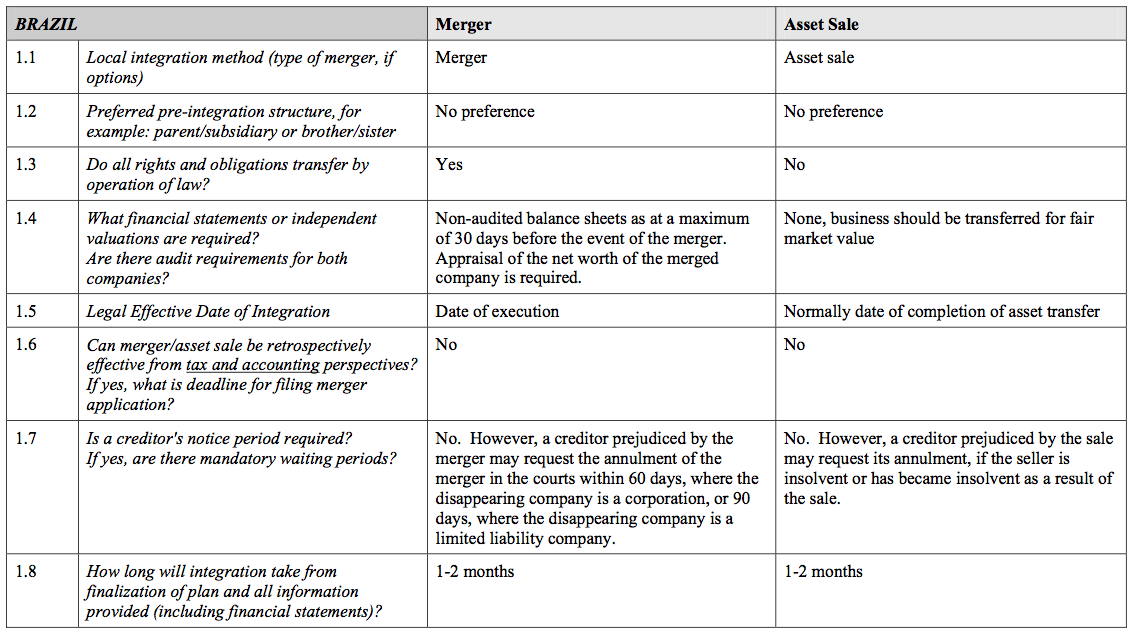
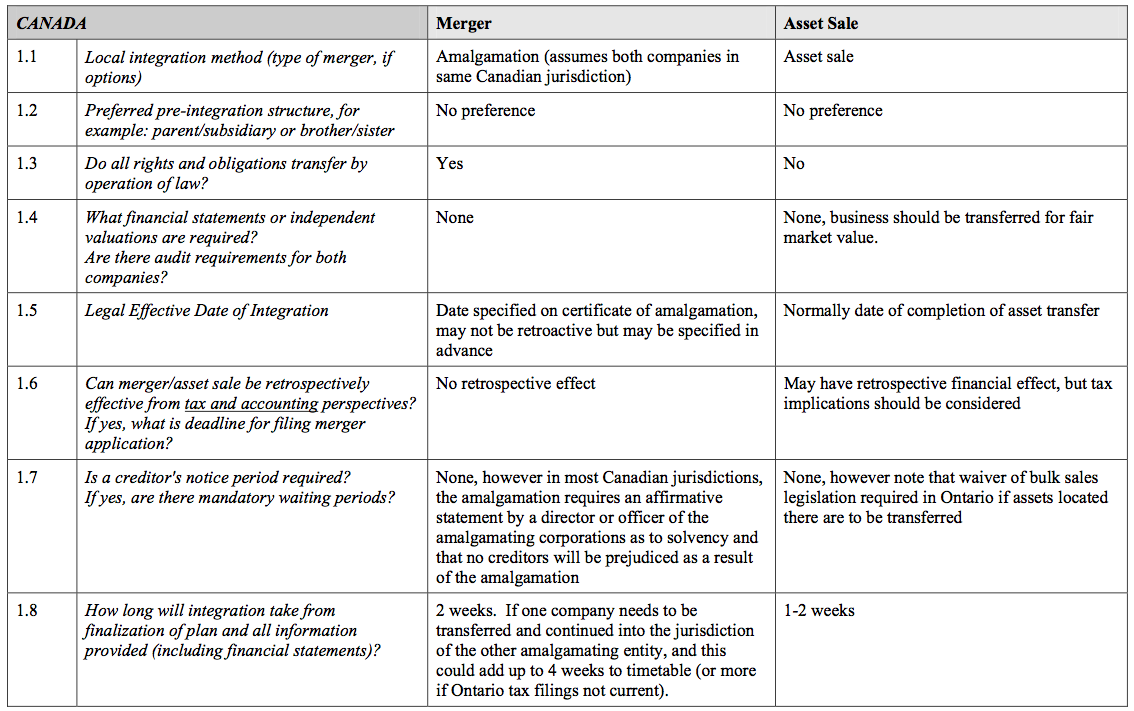
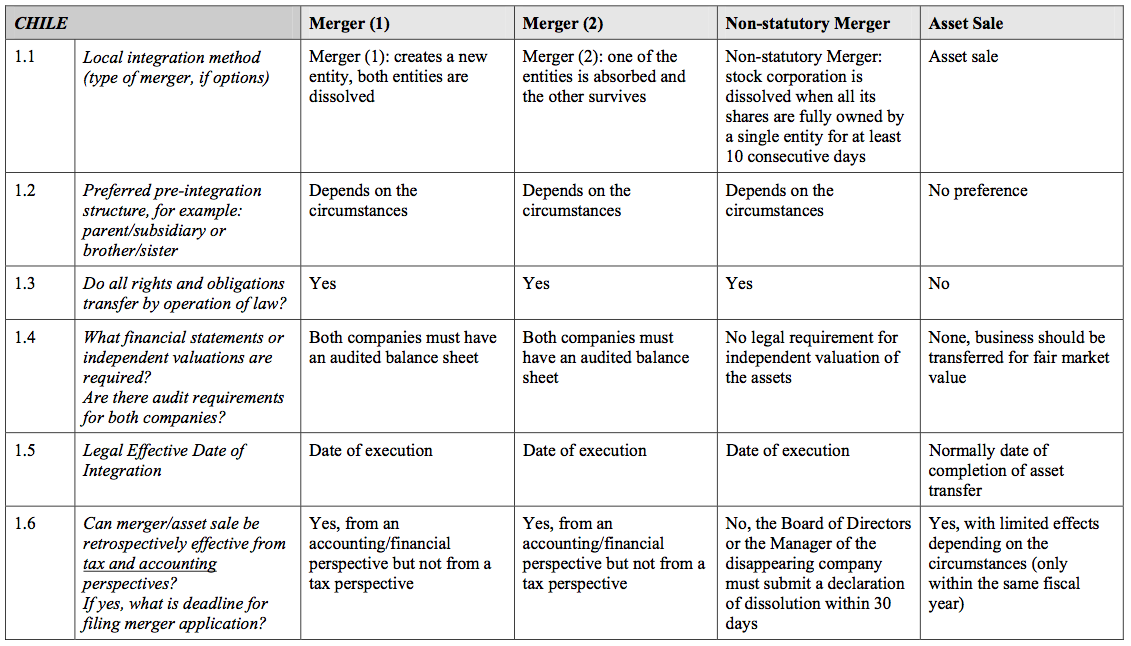
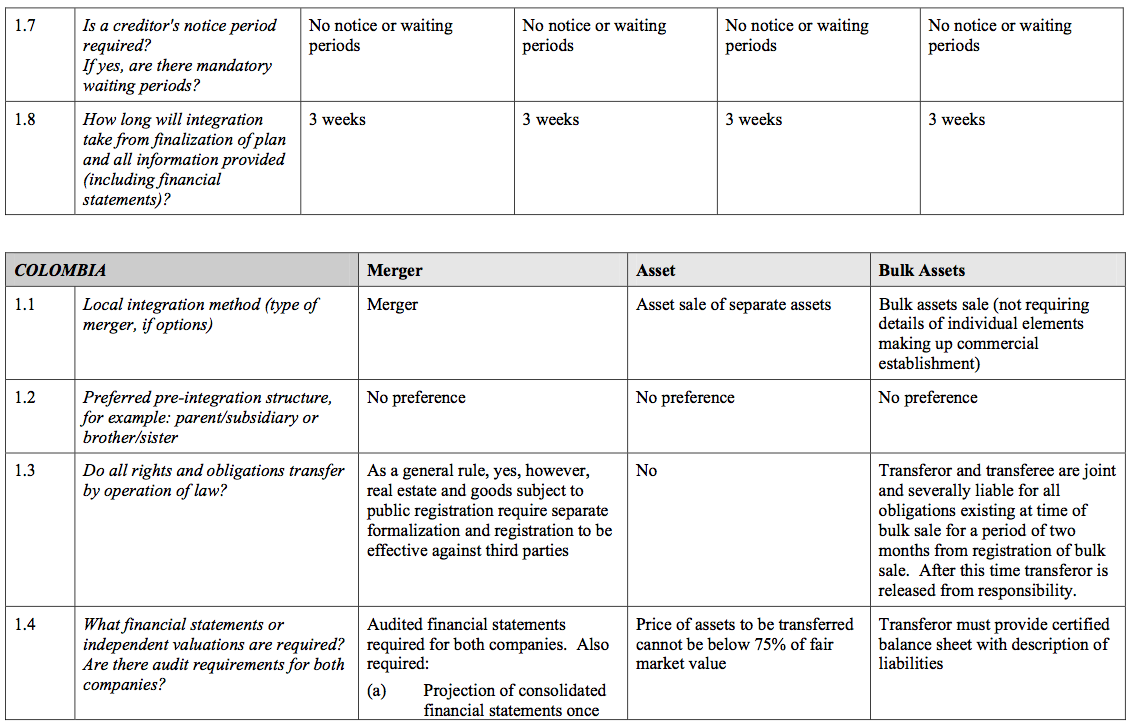
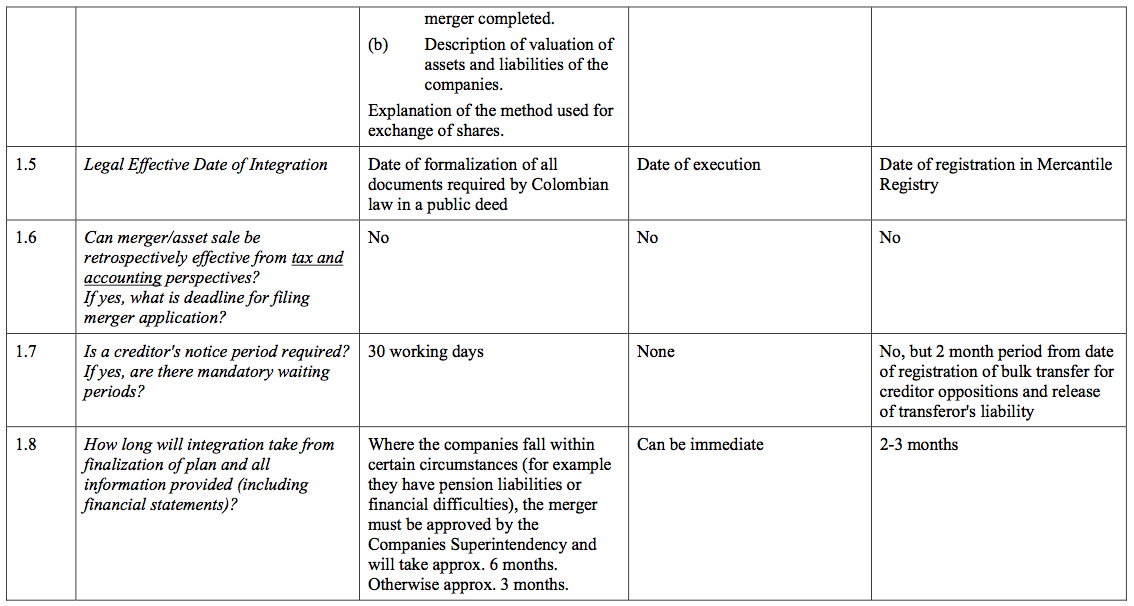

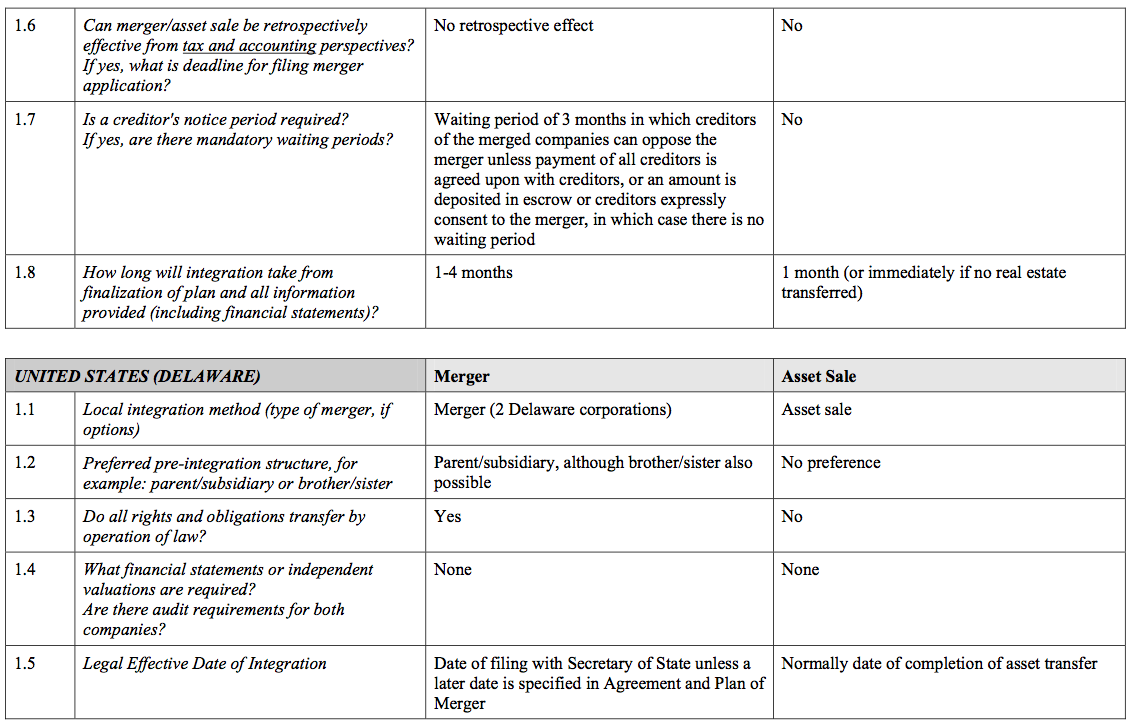
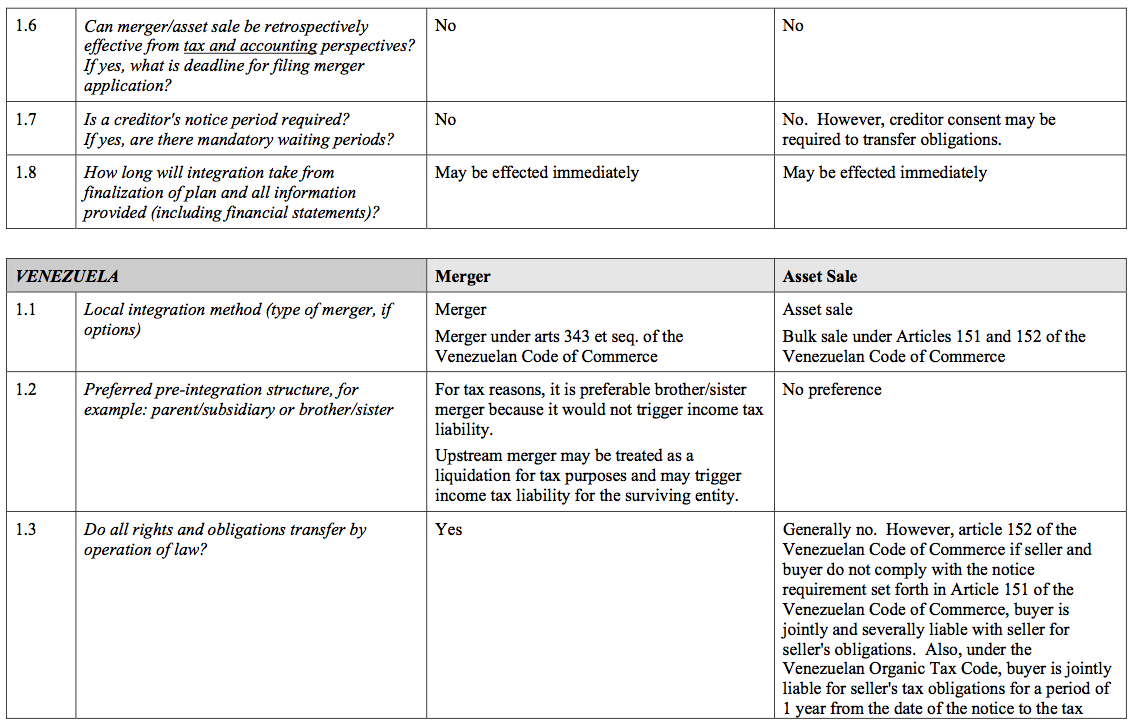
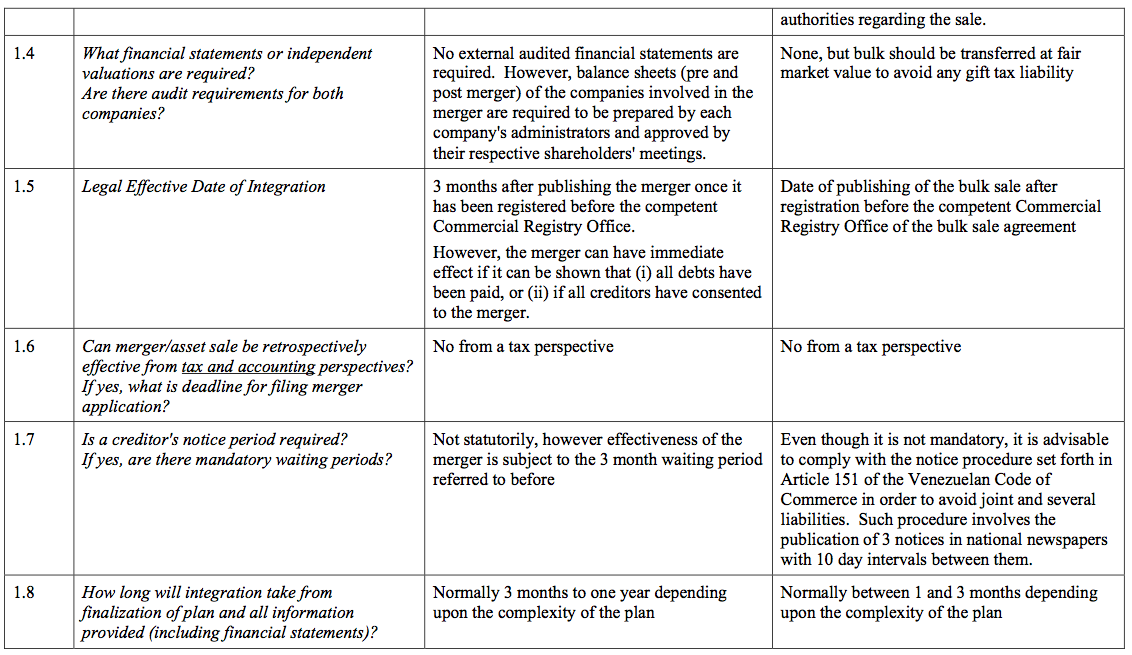
2. ASIA PACIFIC REGION
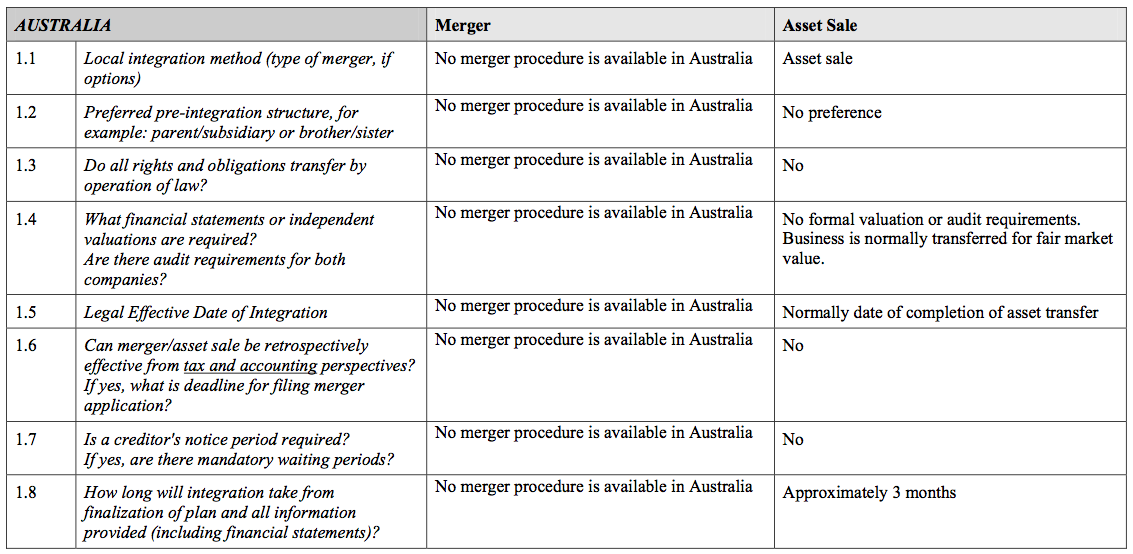


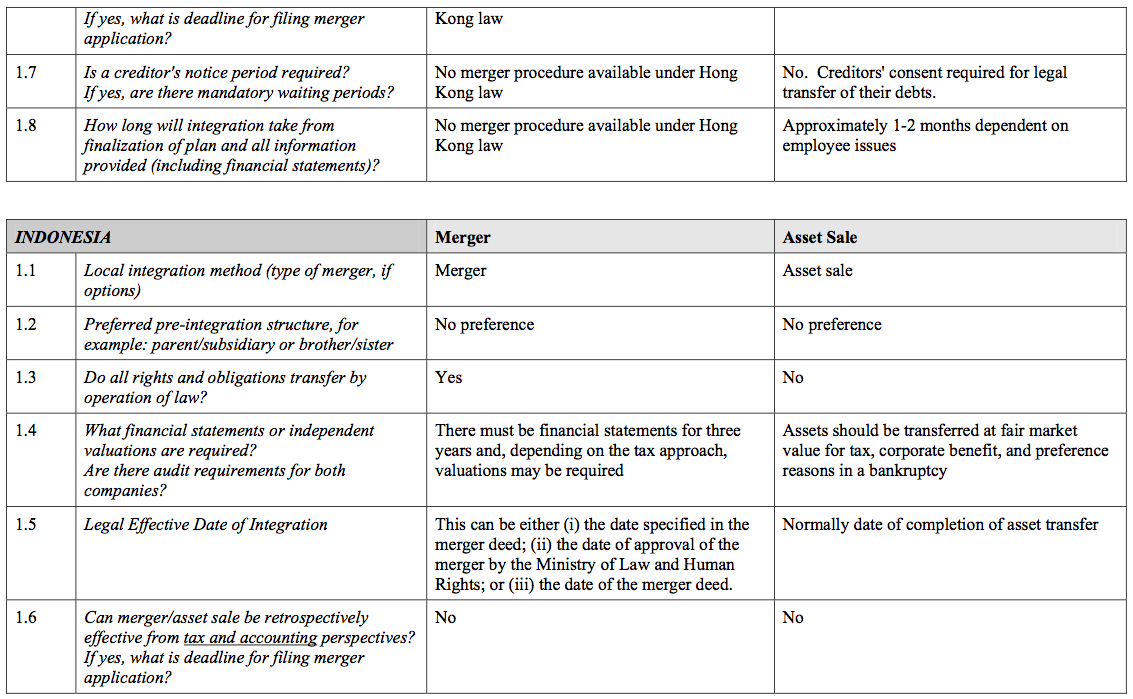
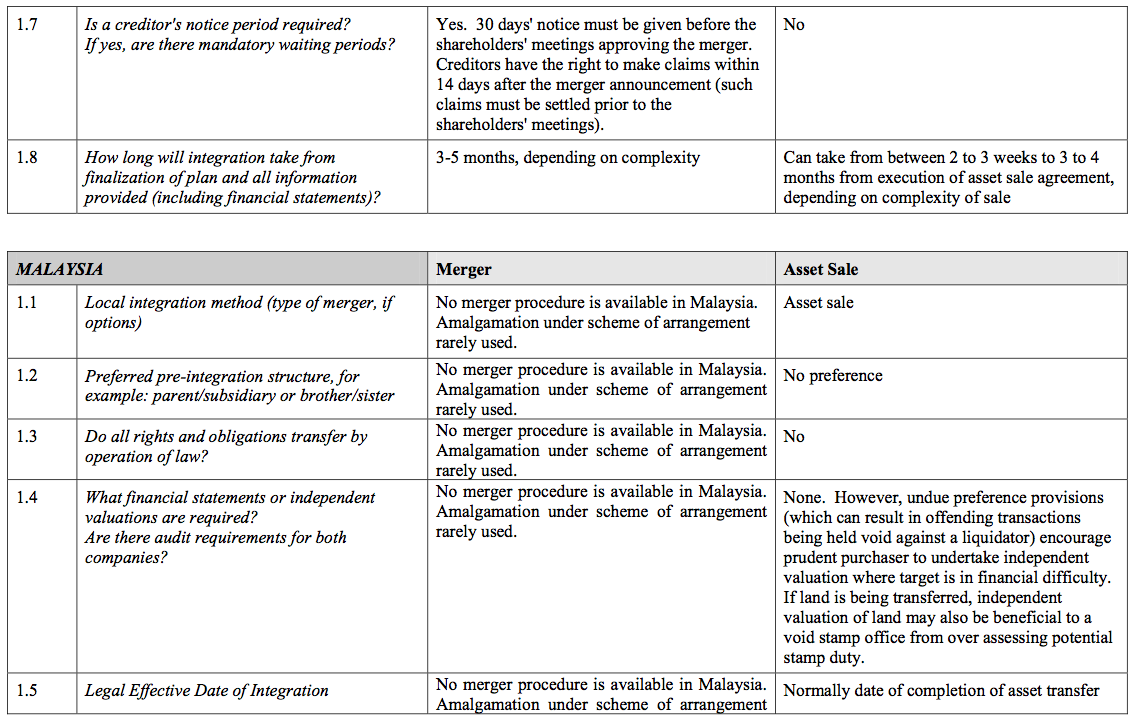

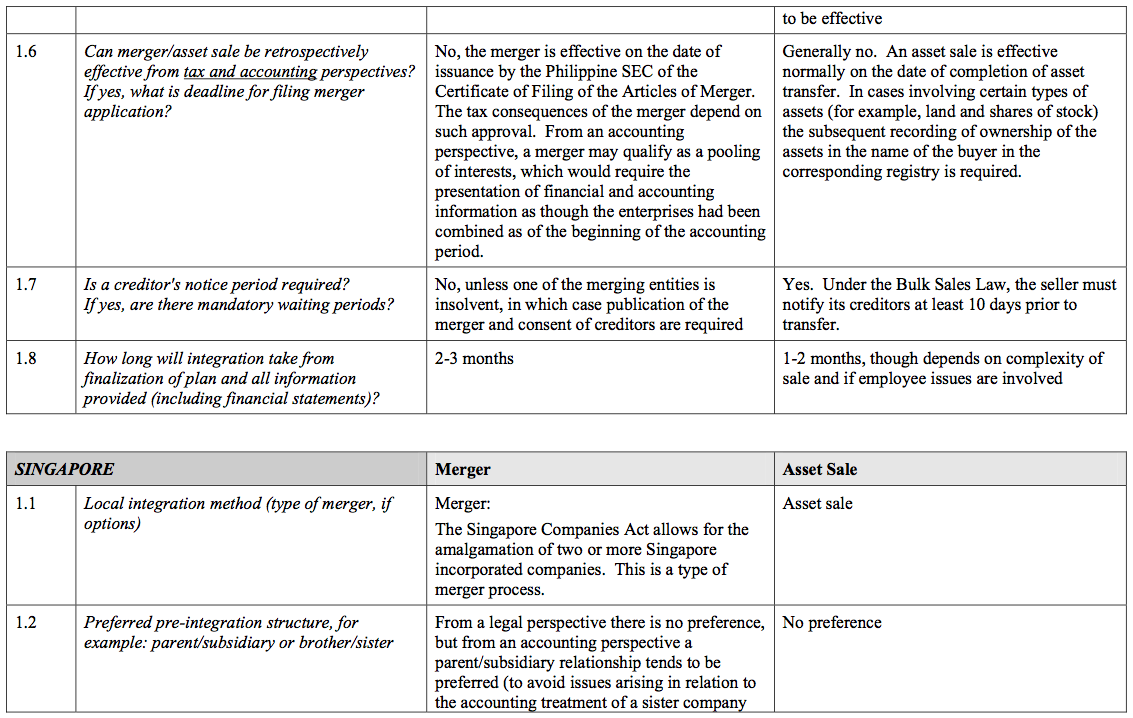

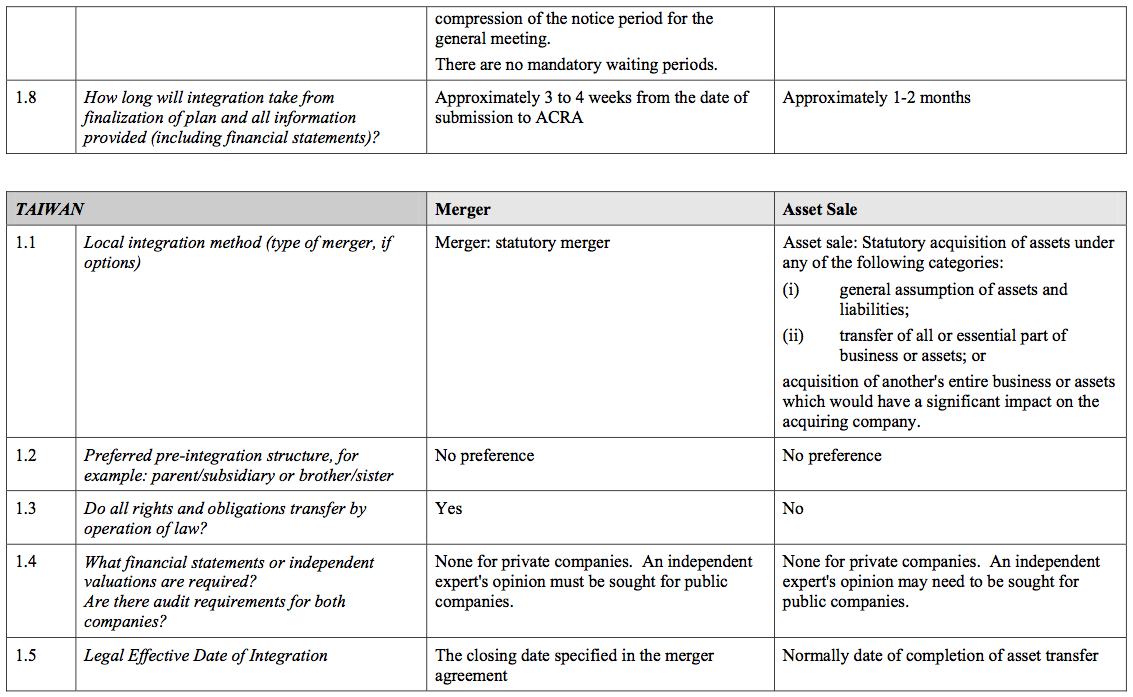
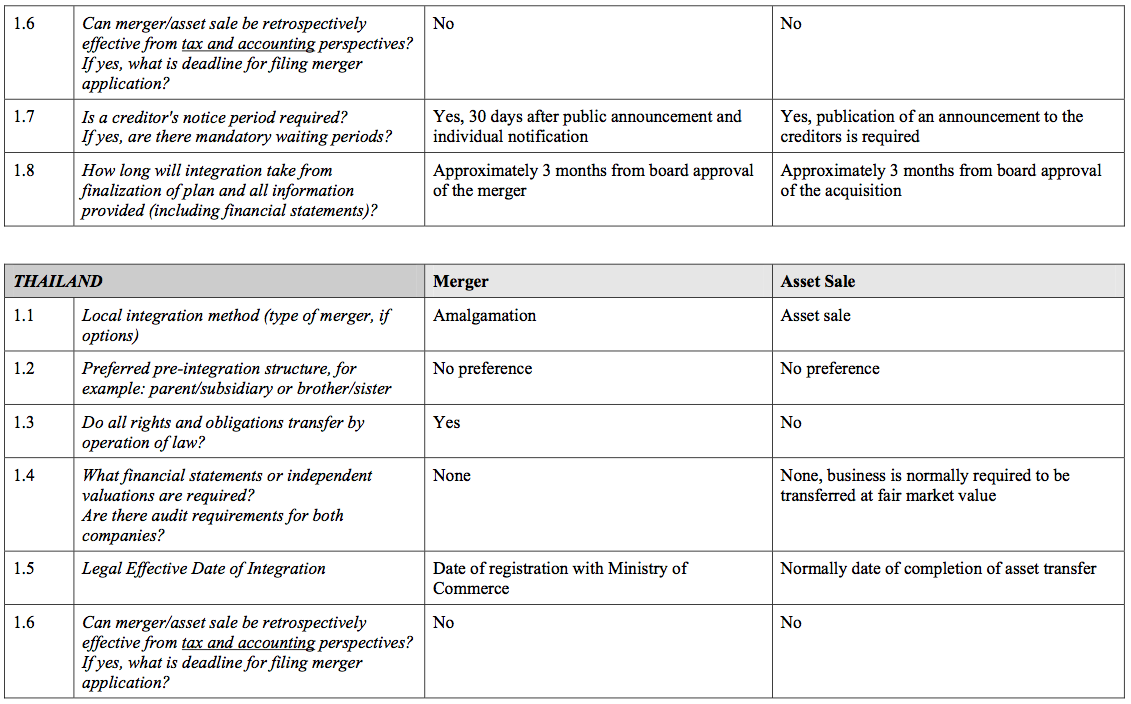
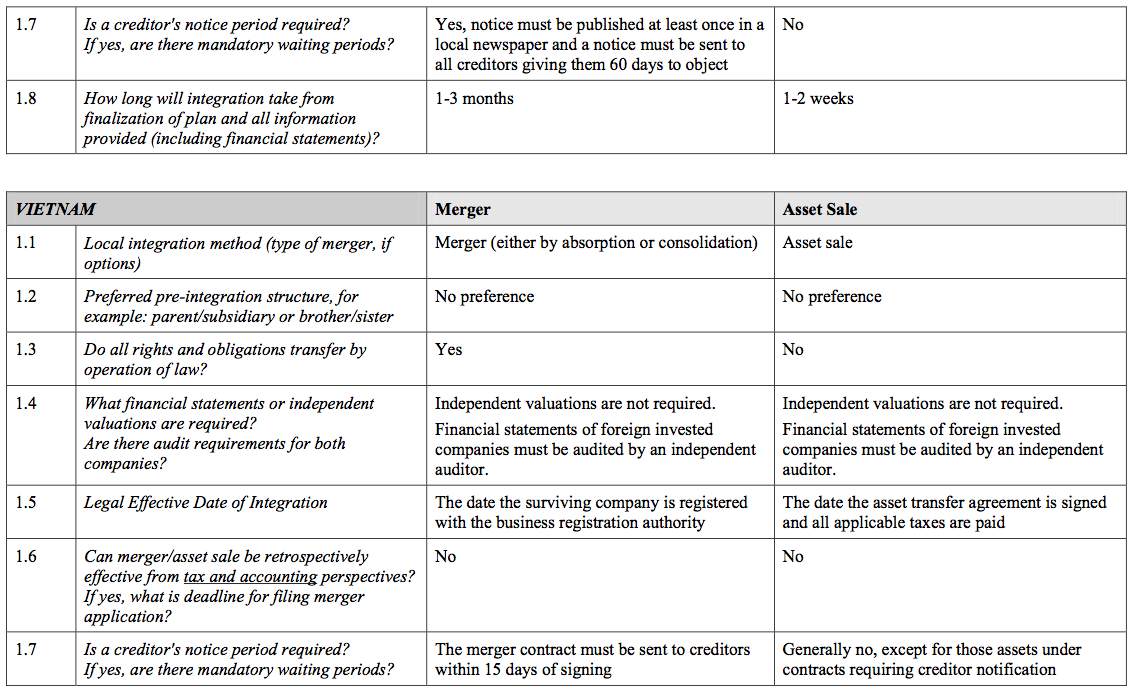

3. EUROPE, MIDDLE EAST AND AFRICA
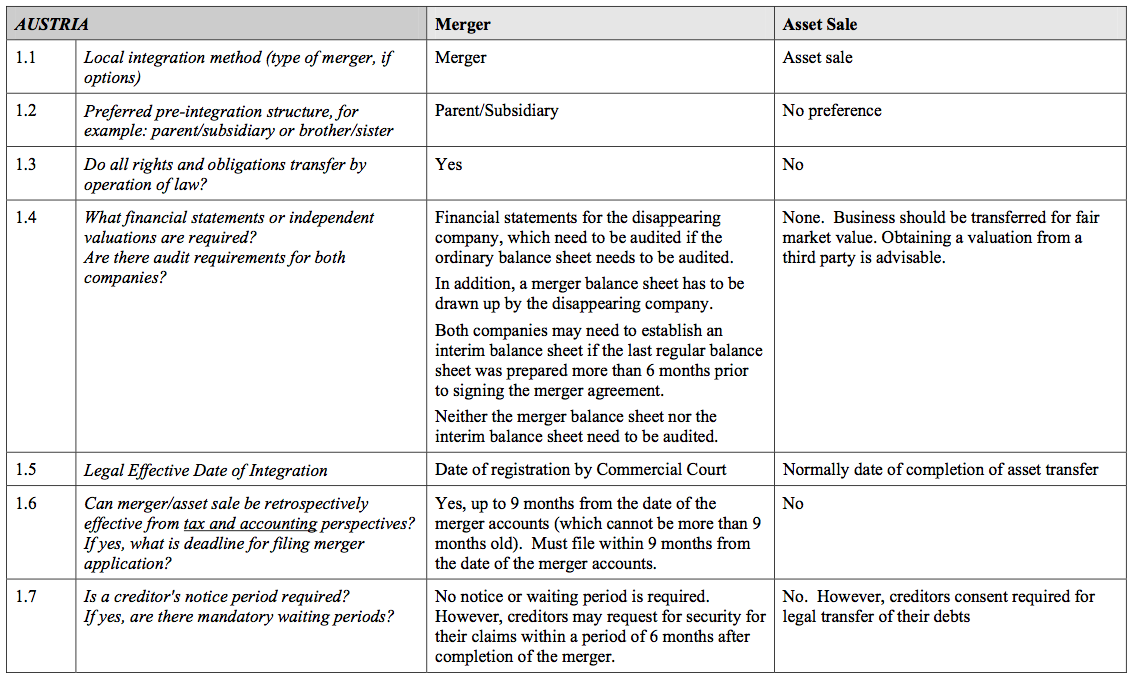
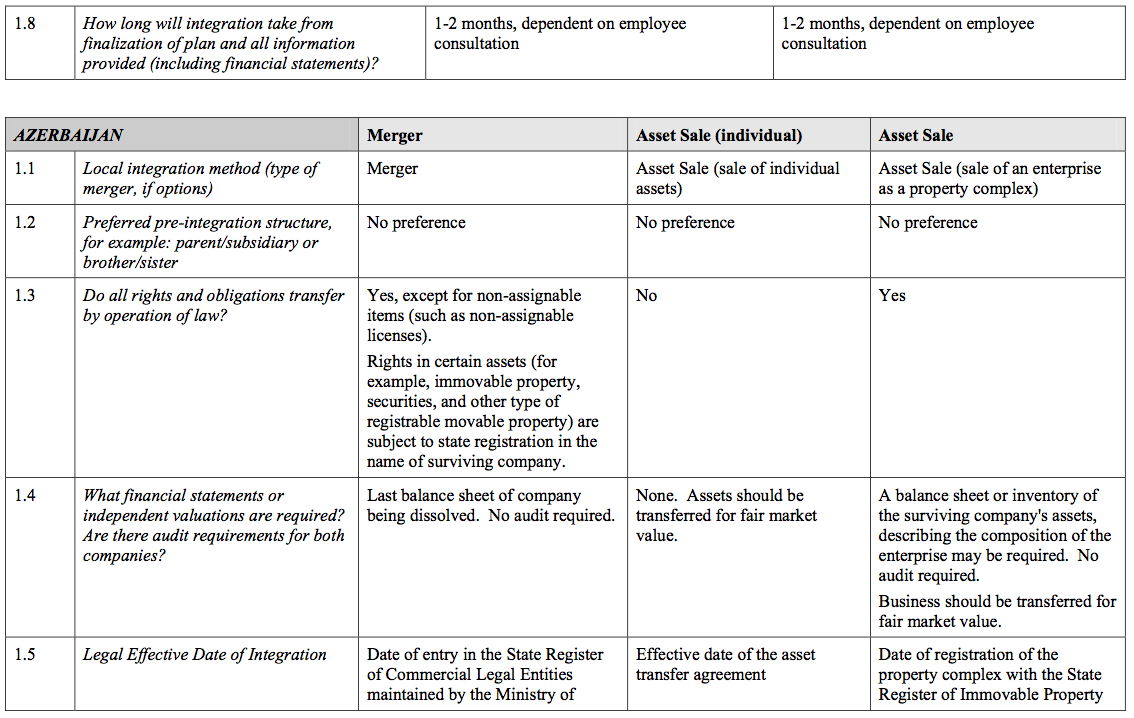
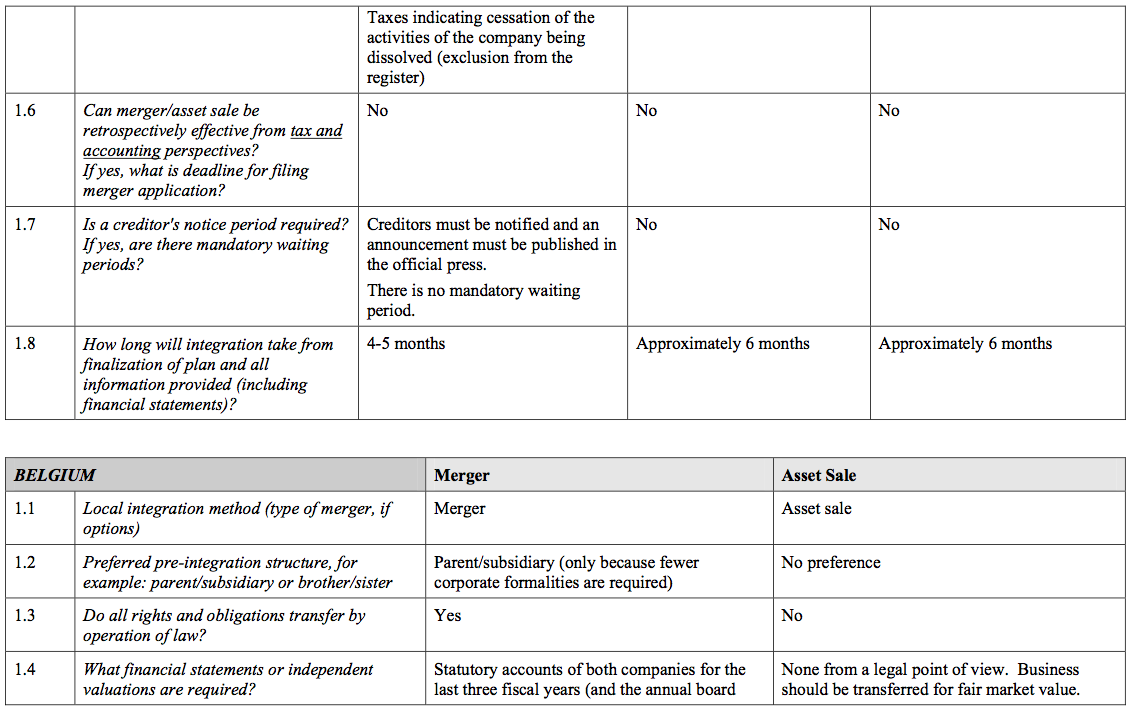
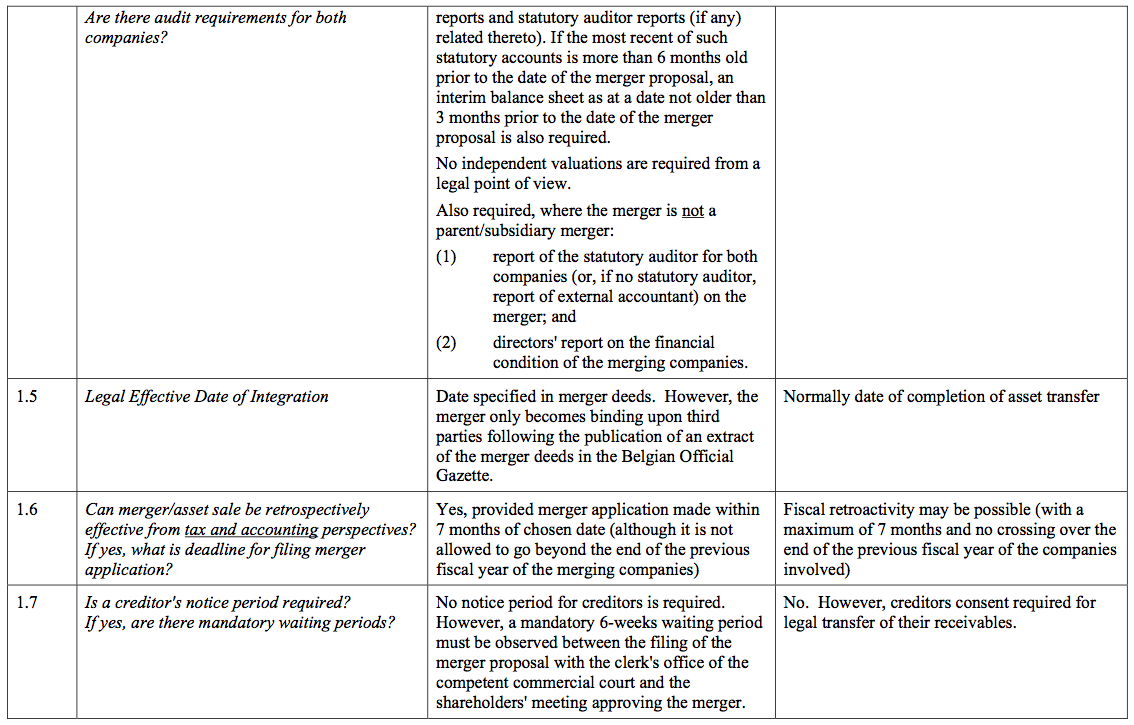
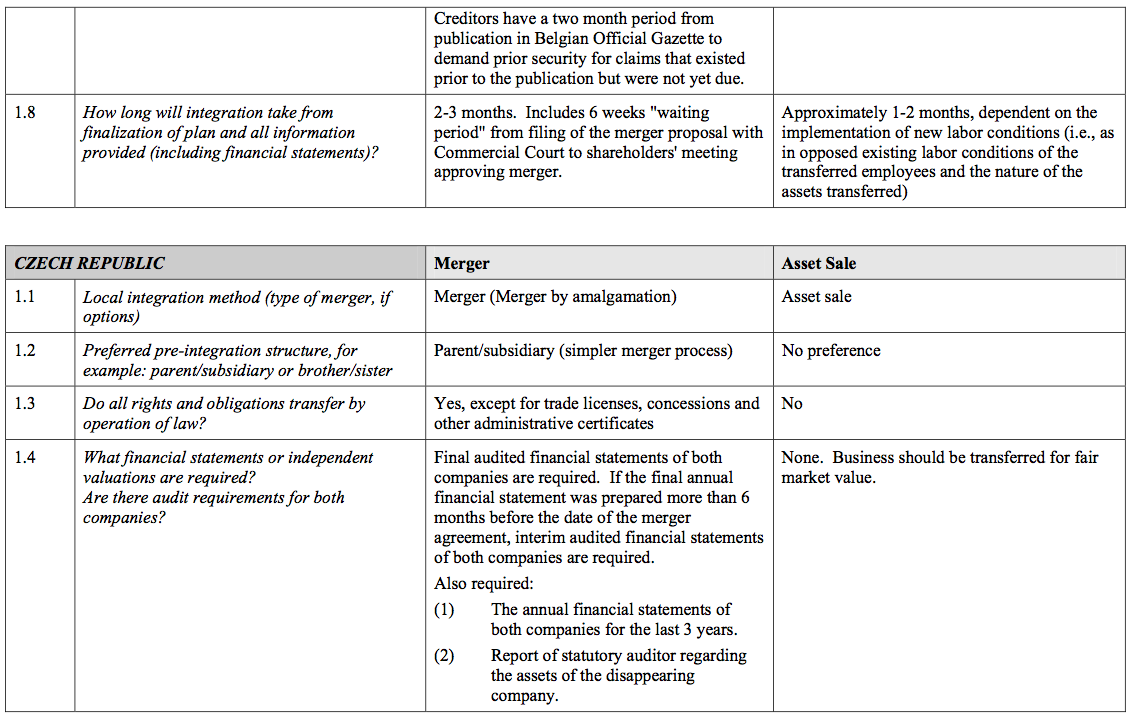

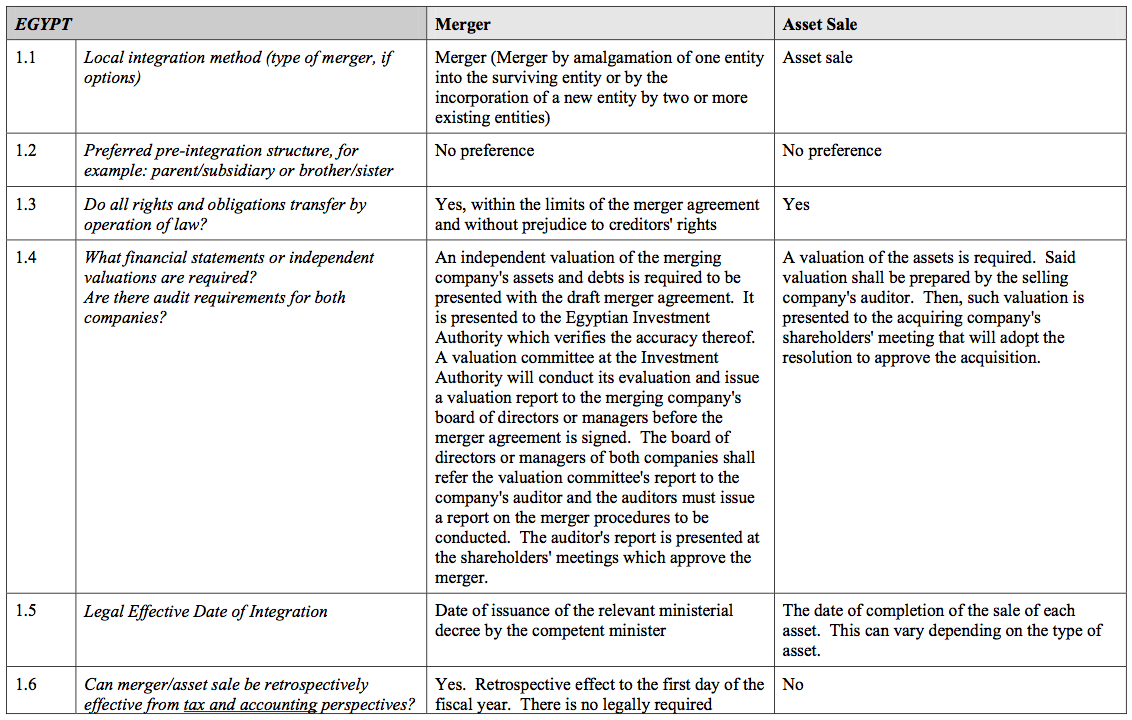
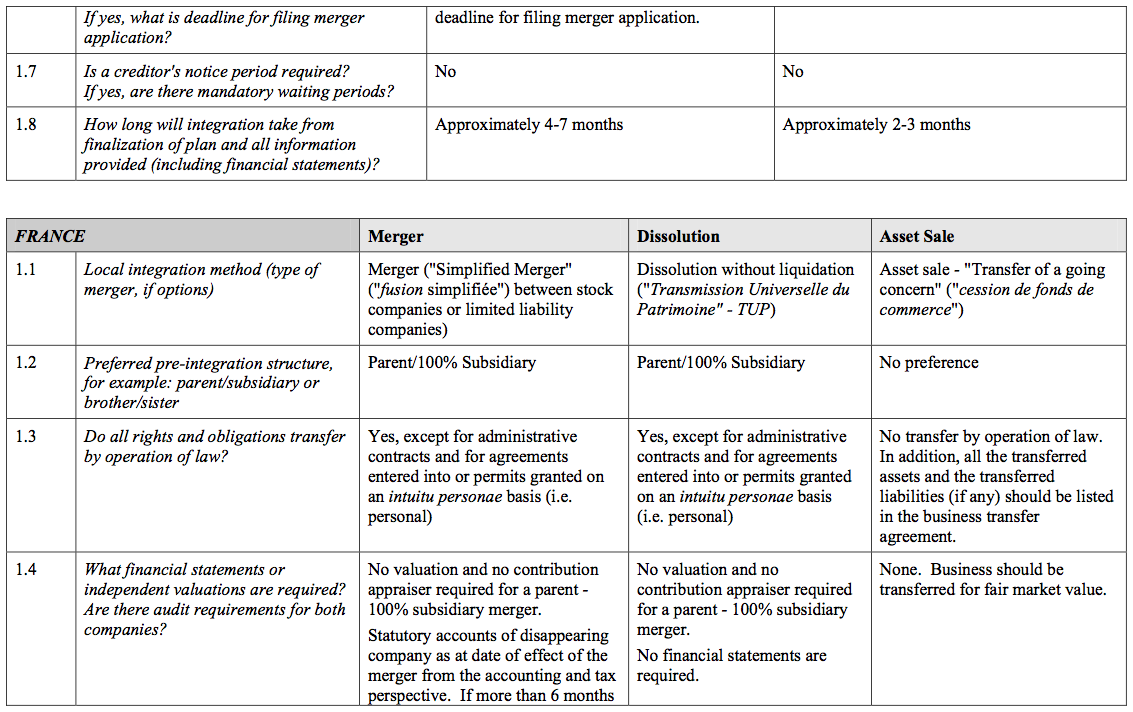
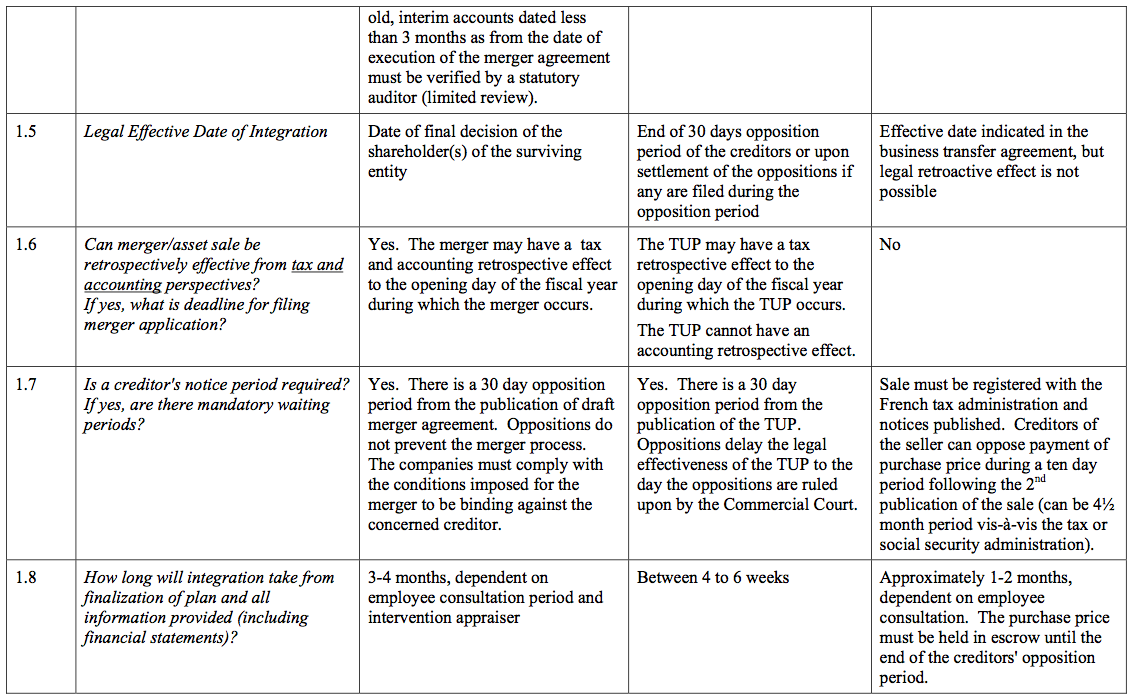
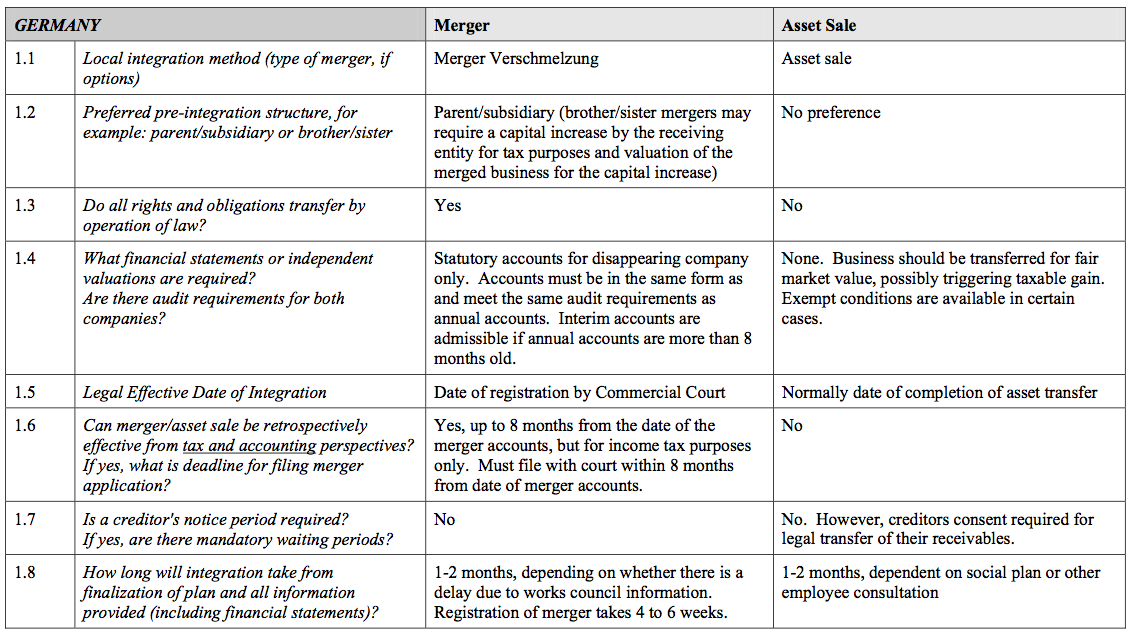
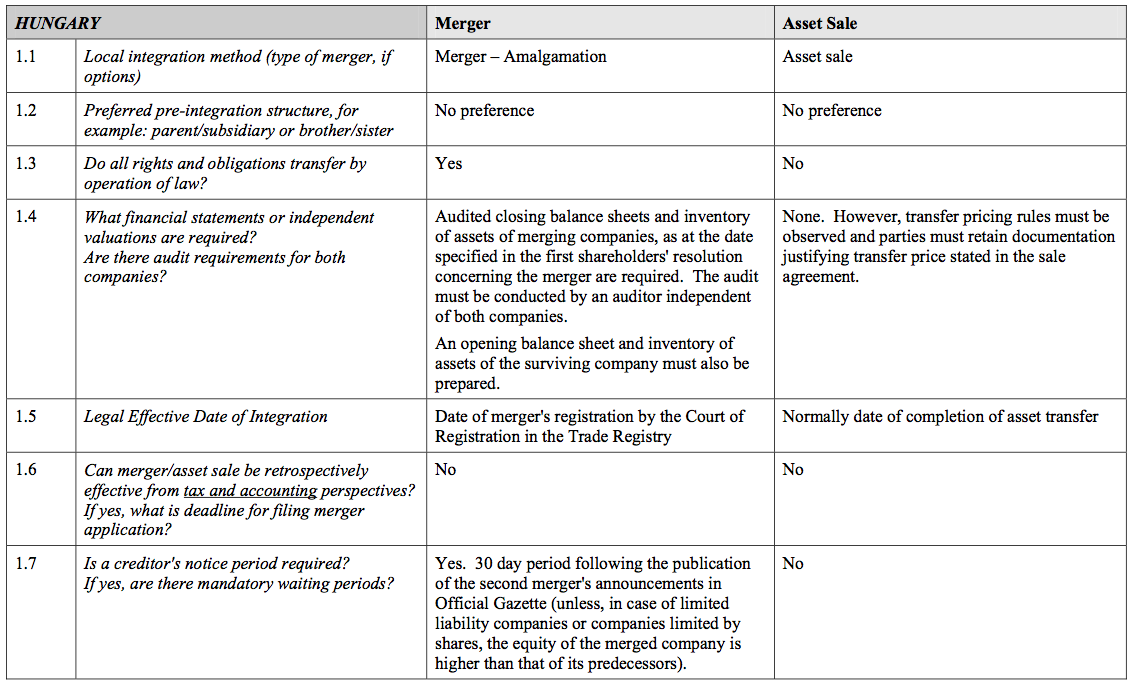
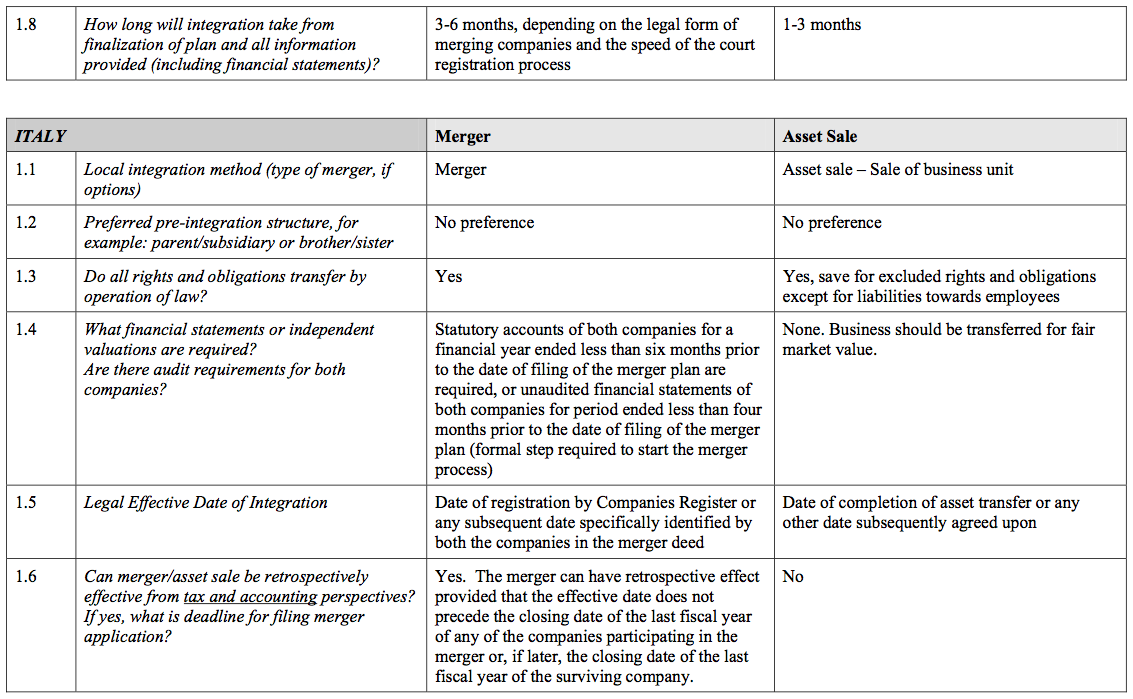
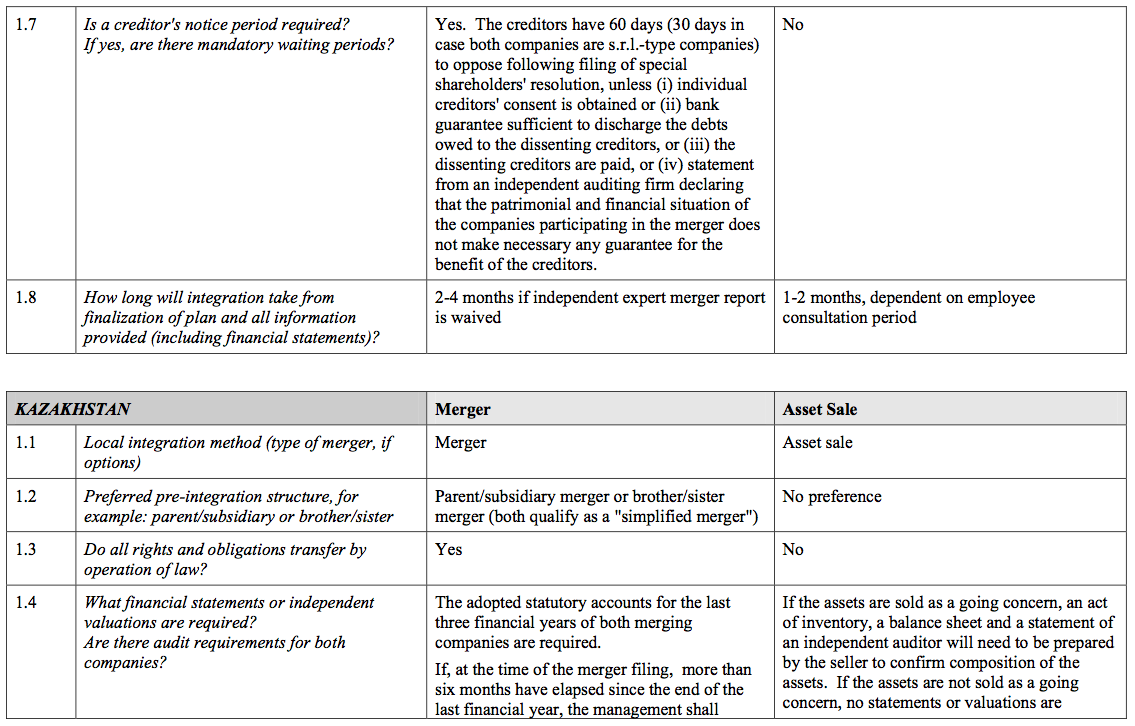

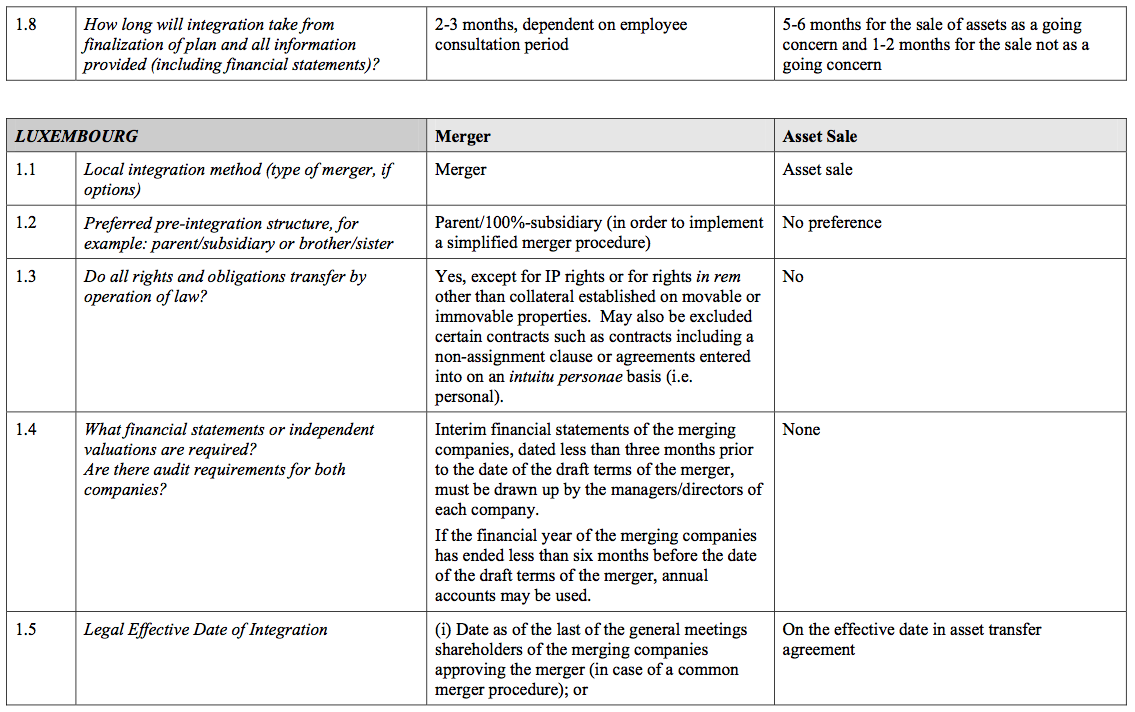
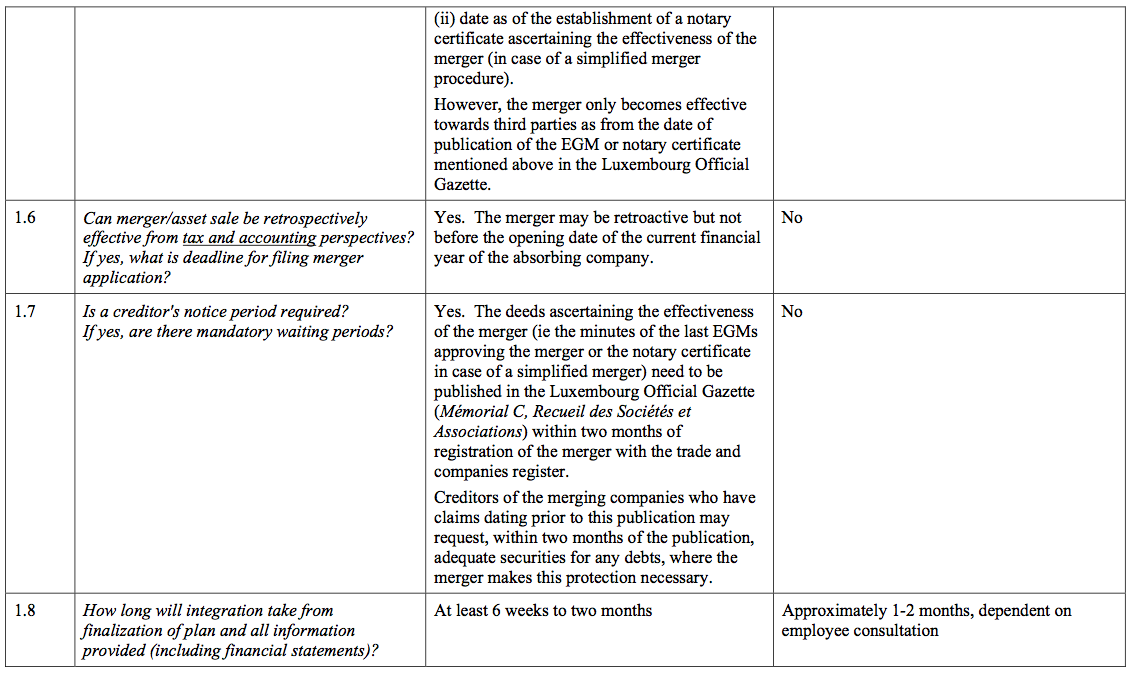
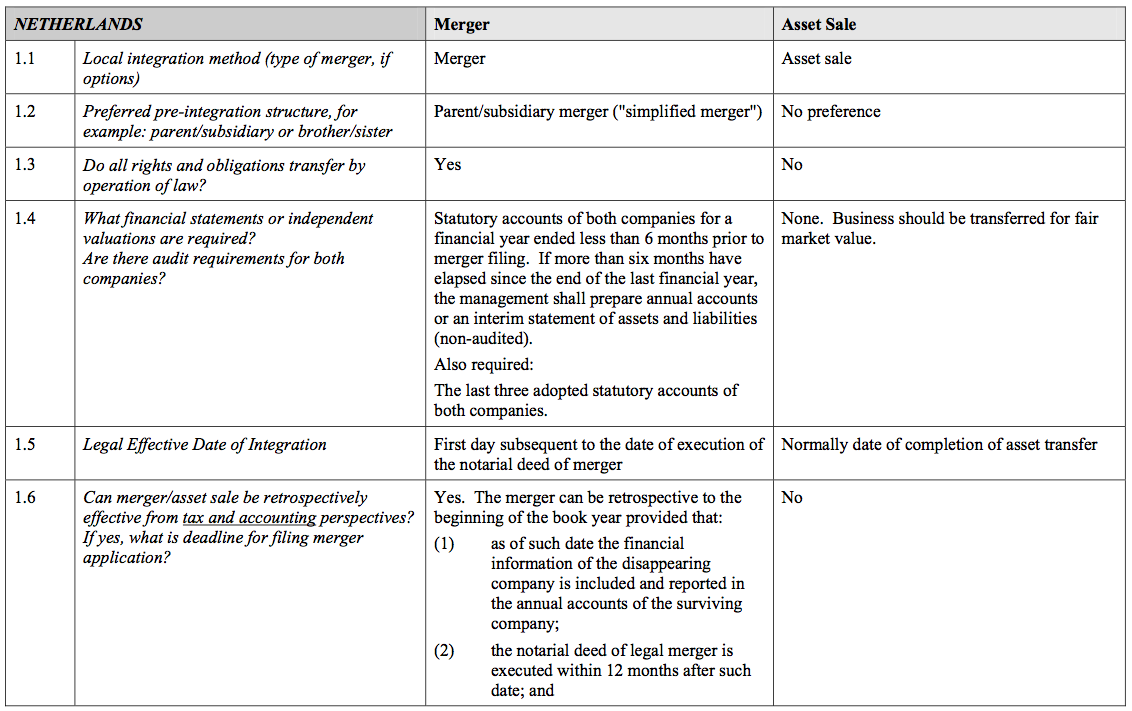

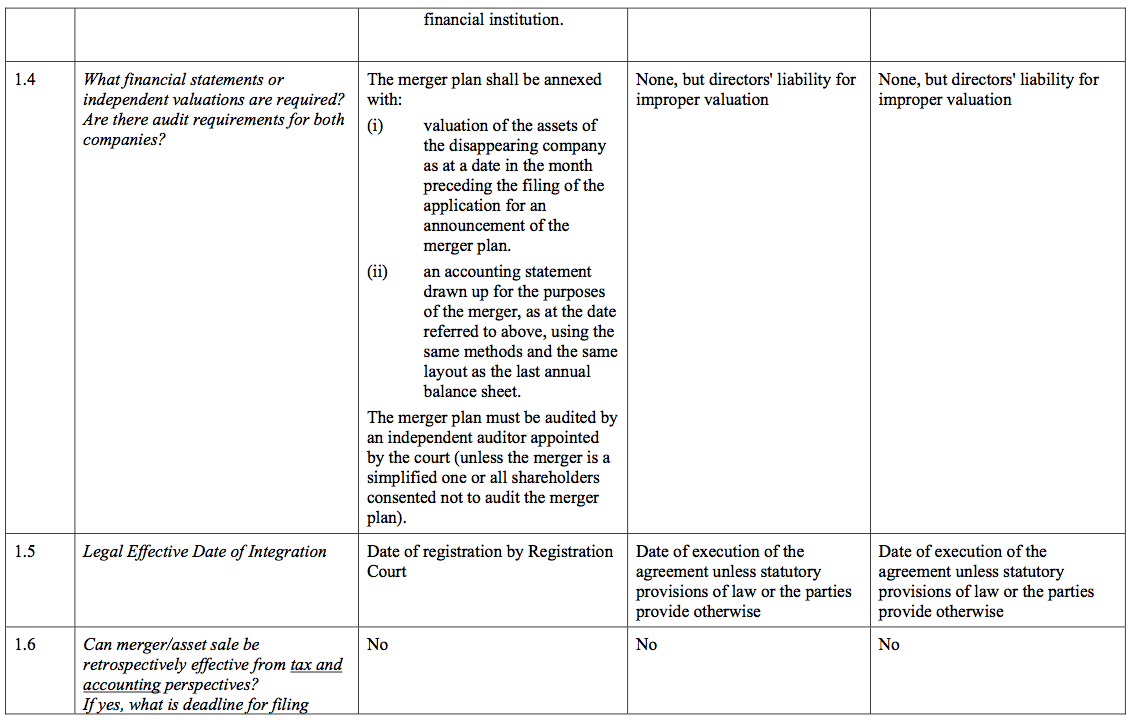


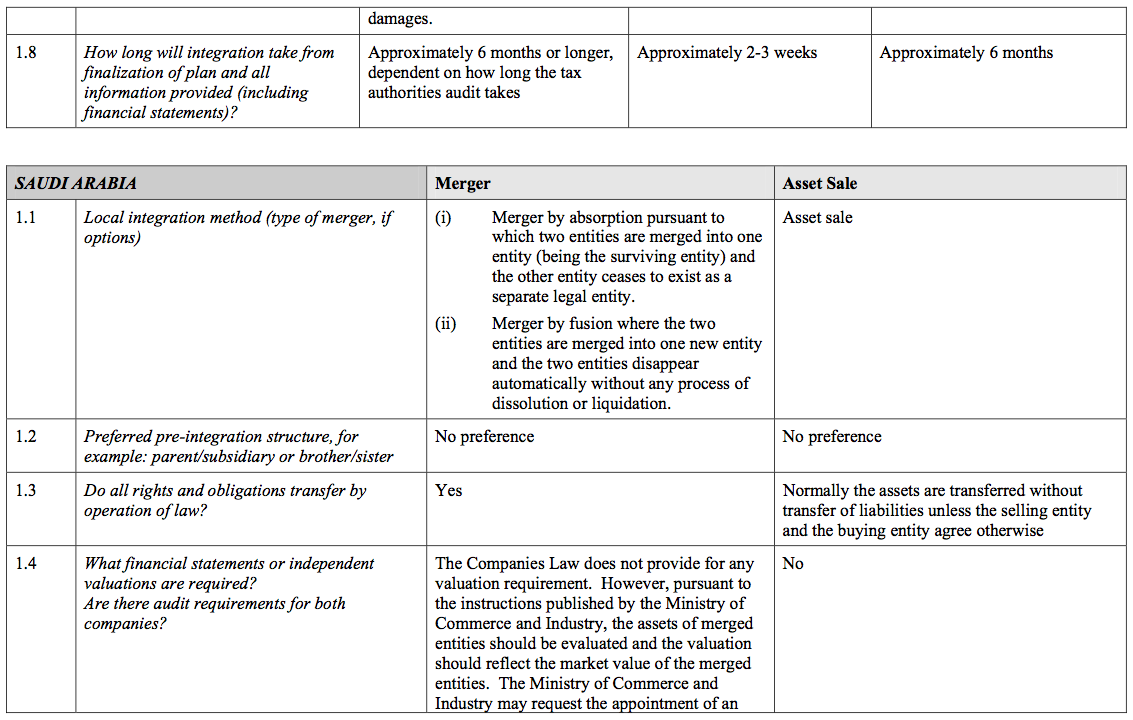
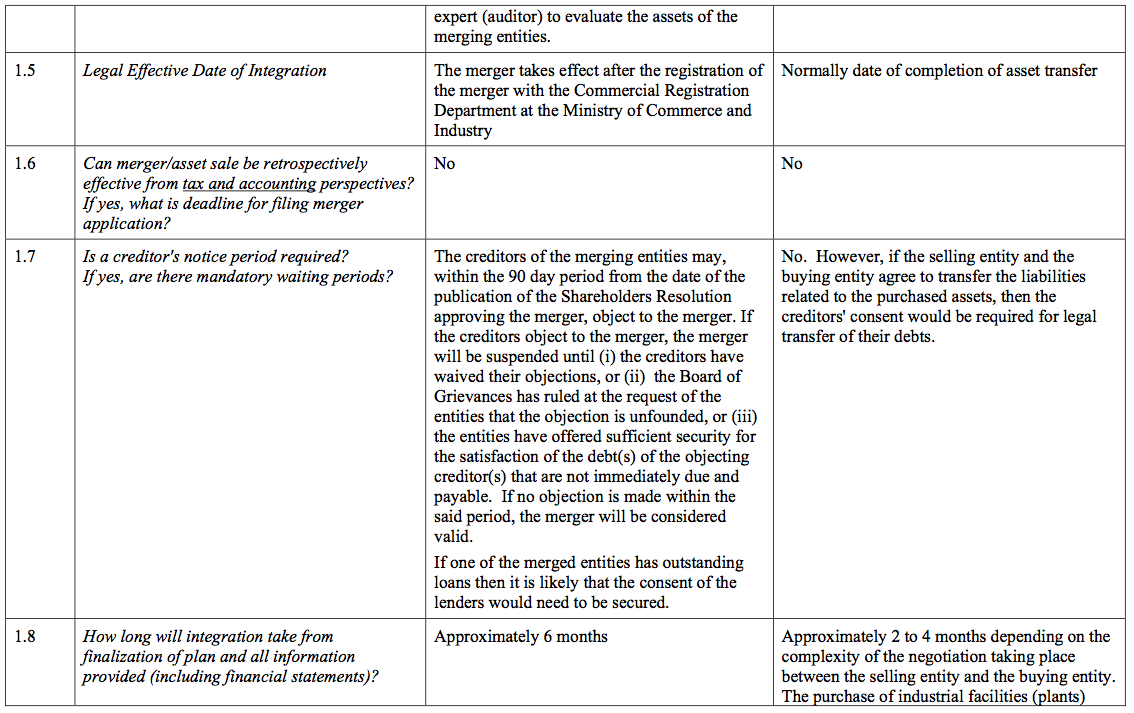


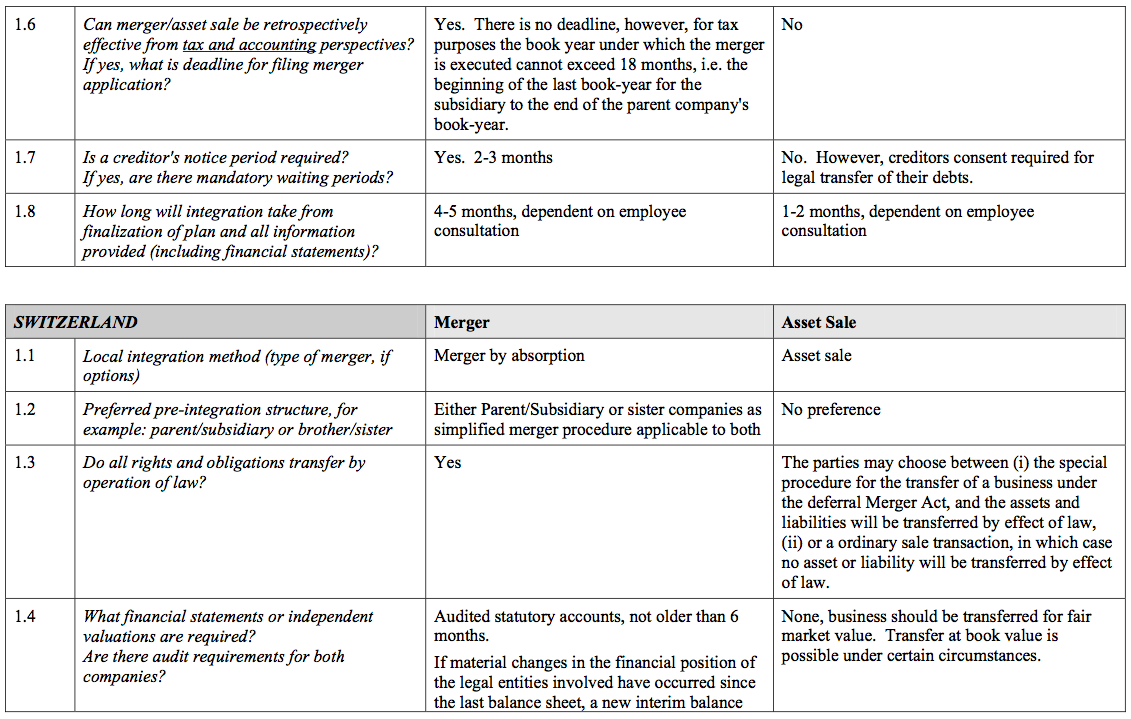
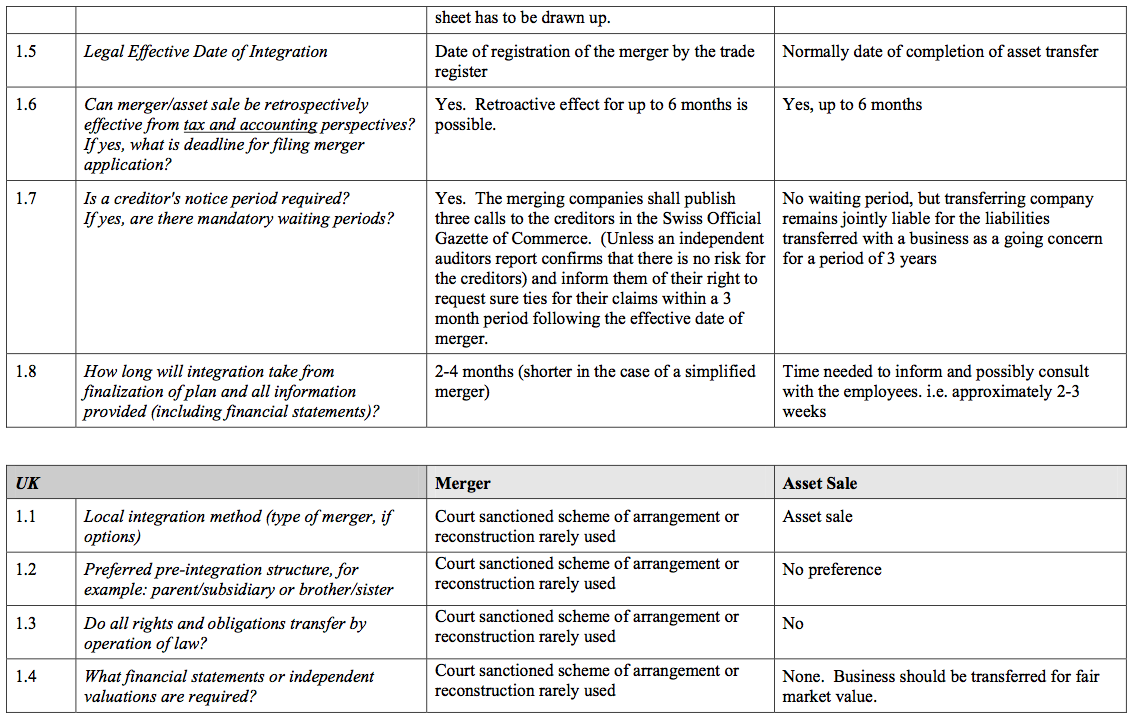
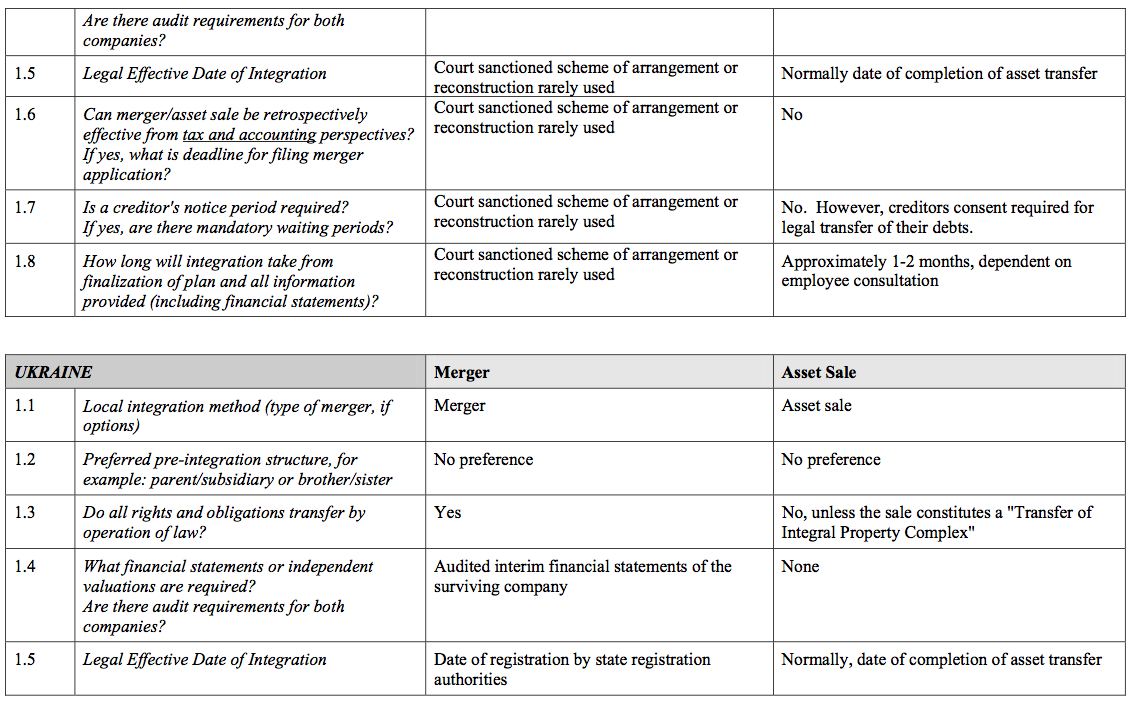
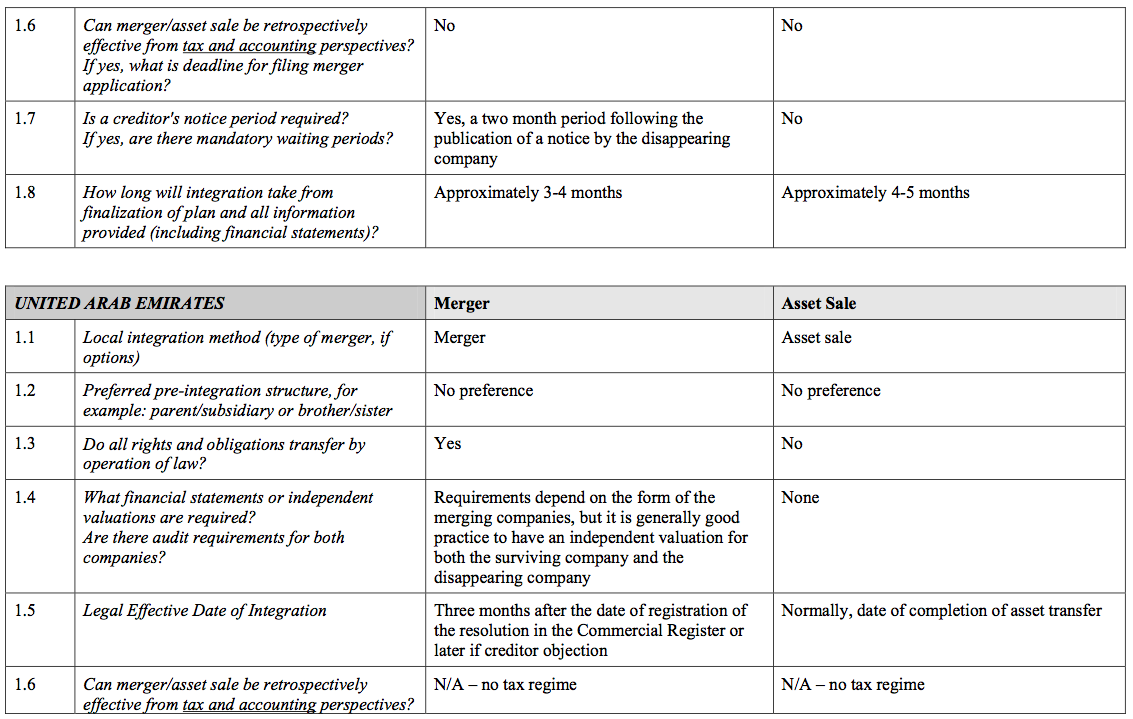

- Tags: M&A, M&A Deals, Mergers and Acquisitions
Become a member and get full access to our comprehensive and regularly updated database of M&A statistics across various industries worldwide.
SHARE:


Stay up to date with M&A news!
Subscribe to our newsletter
